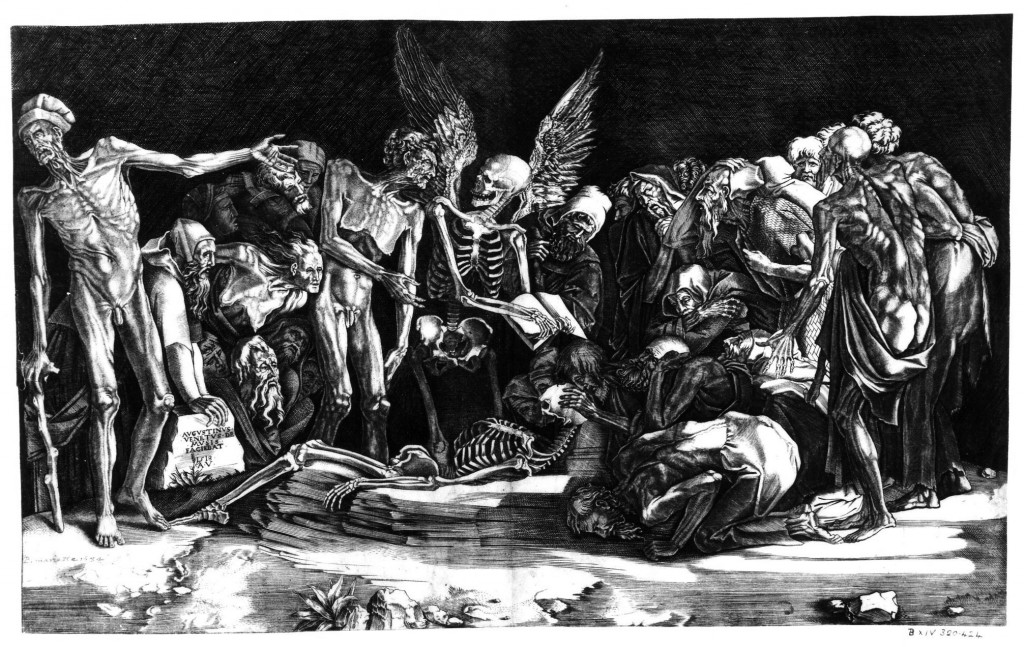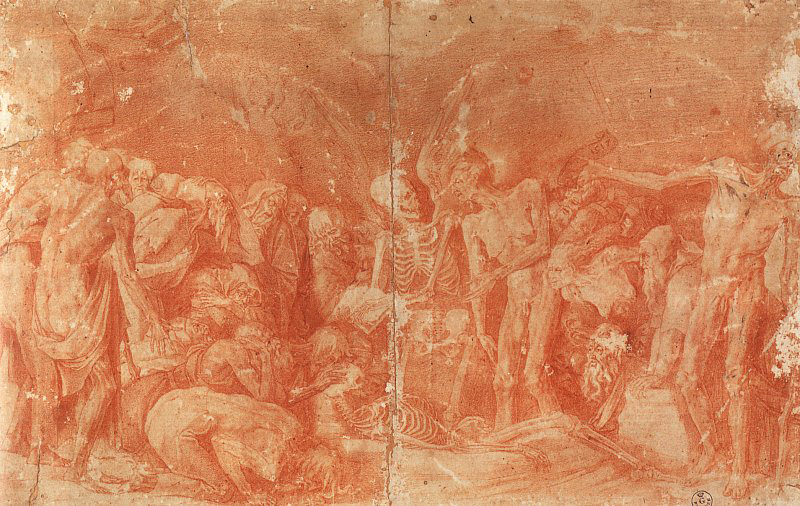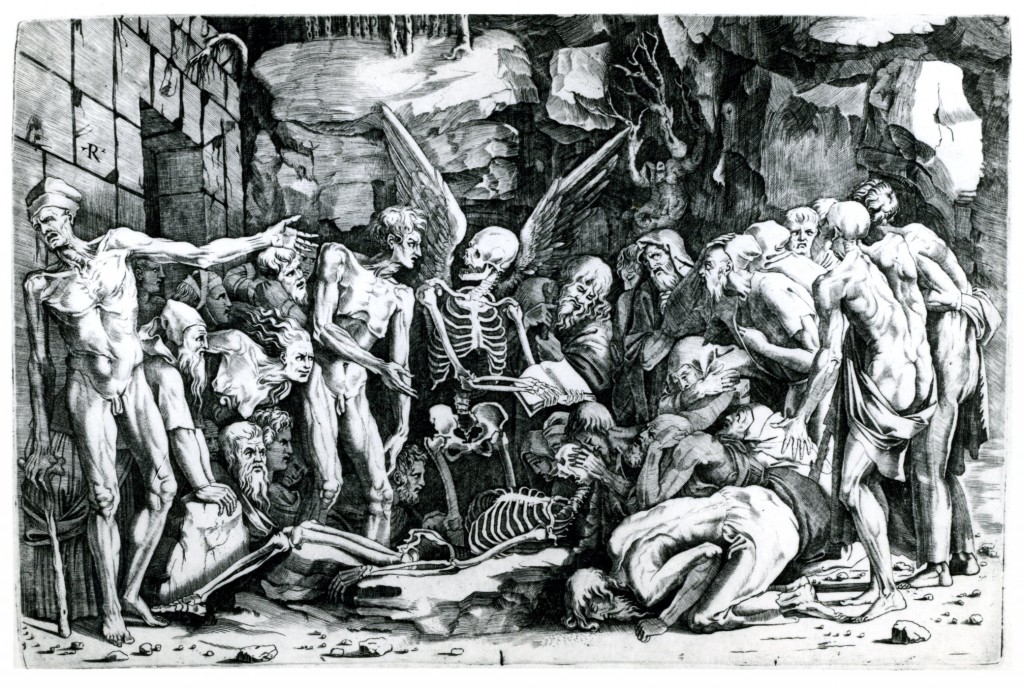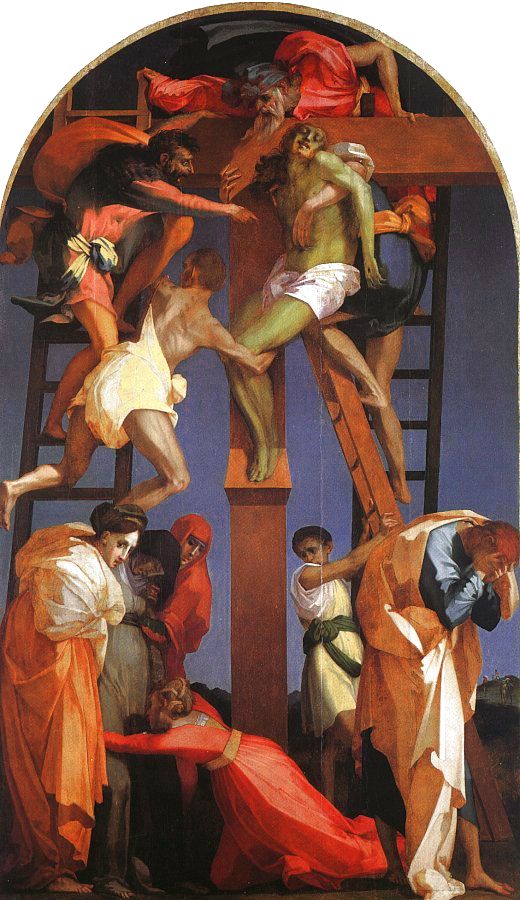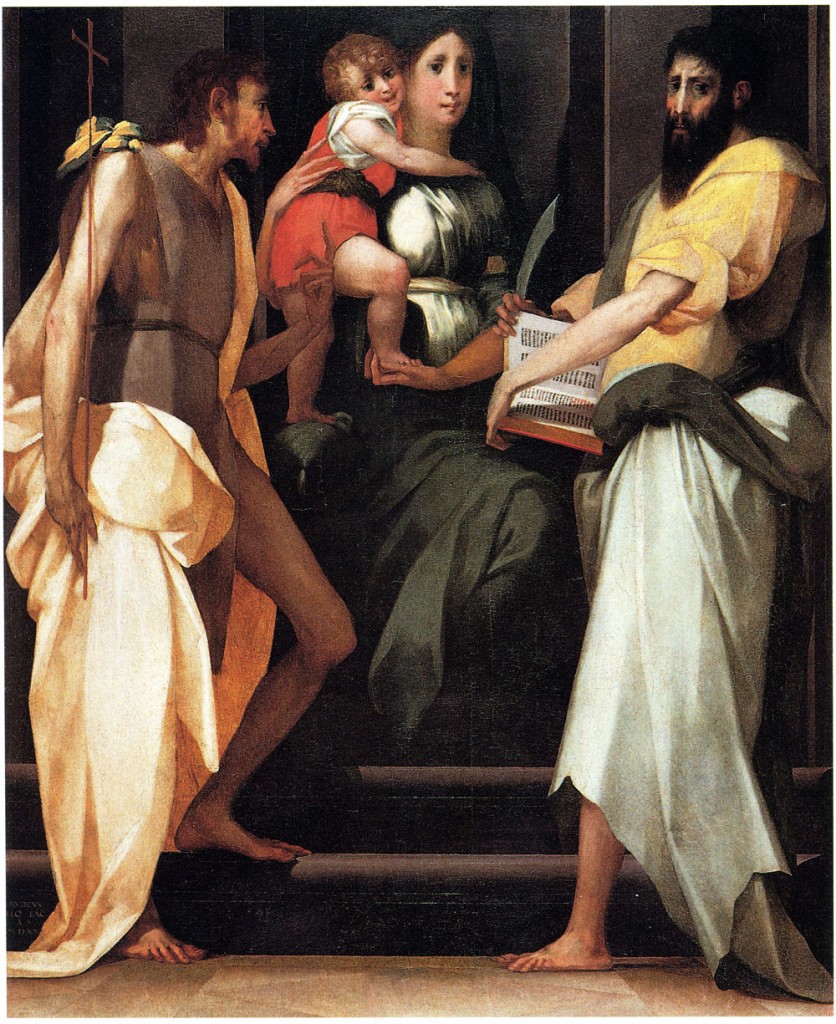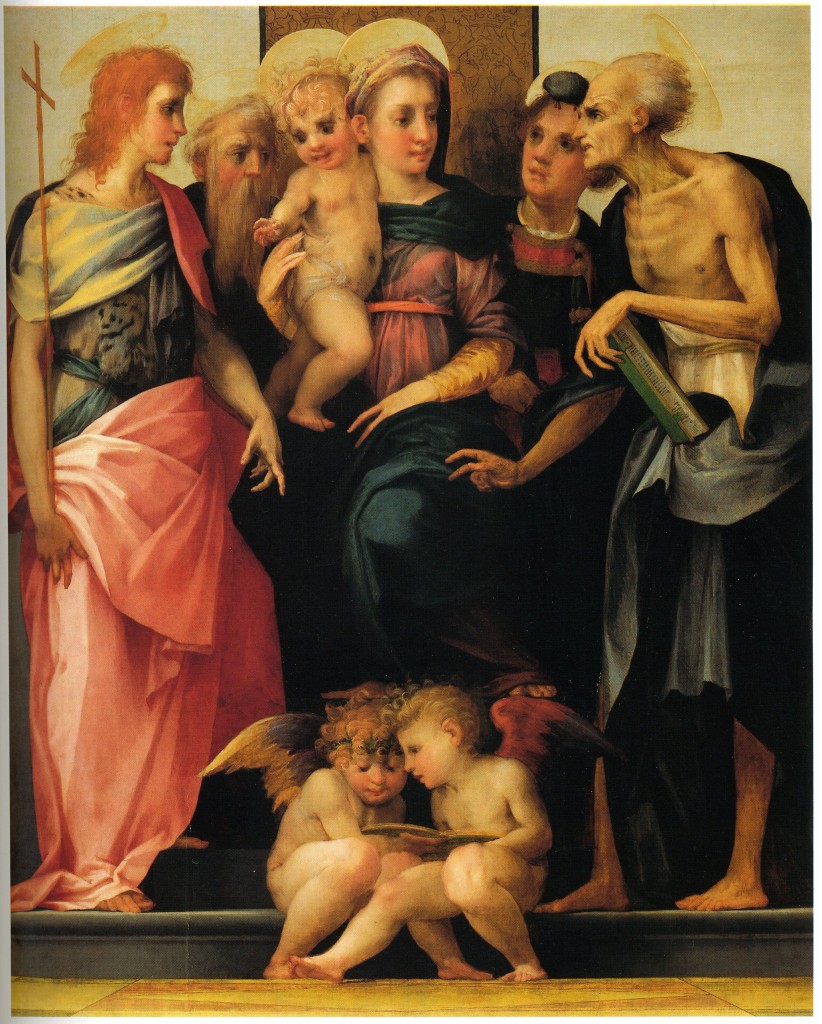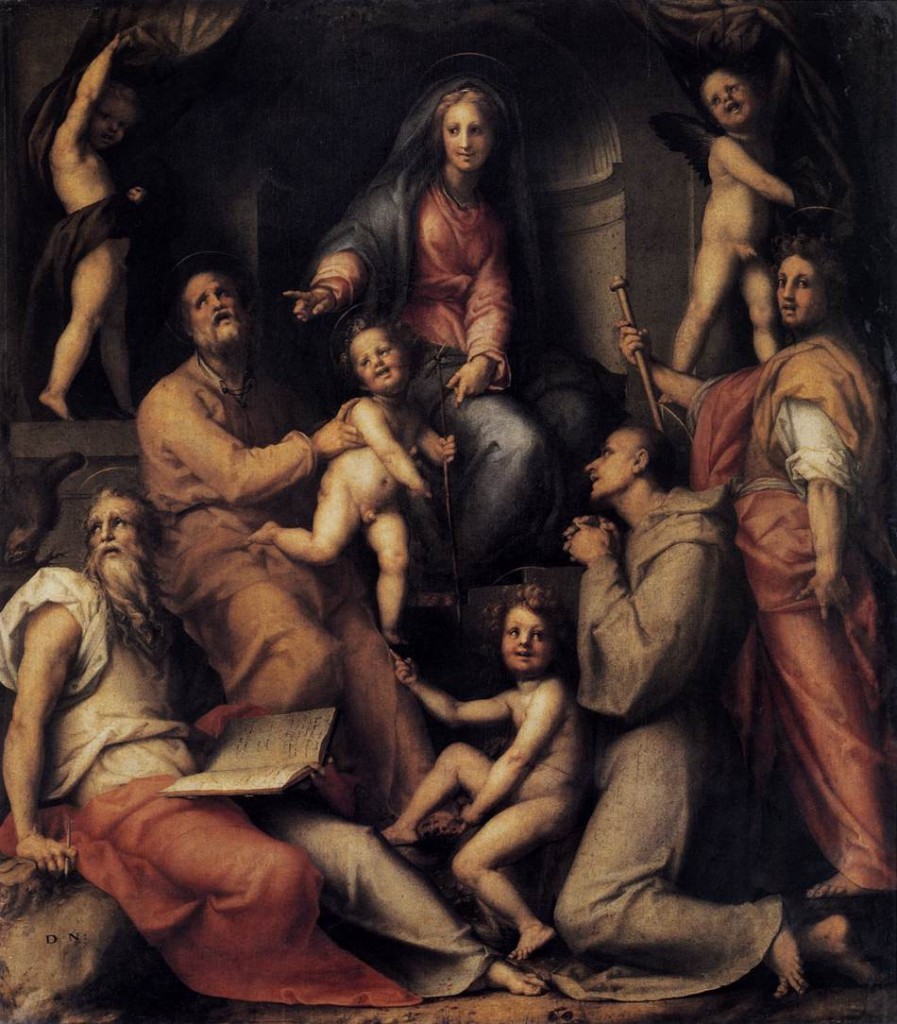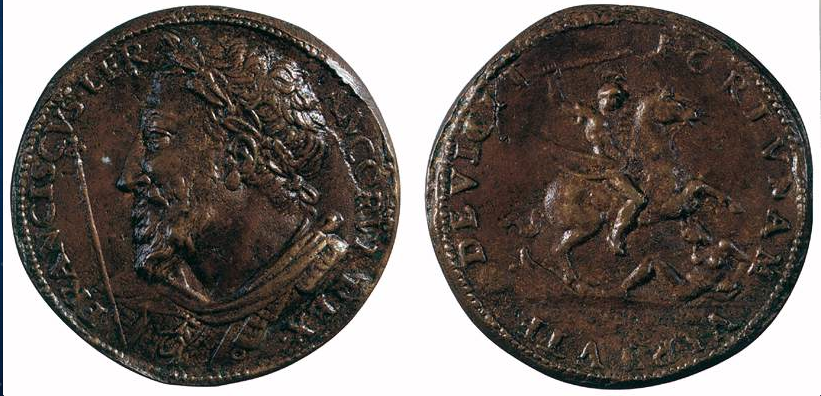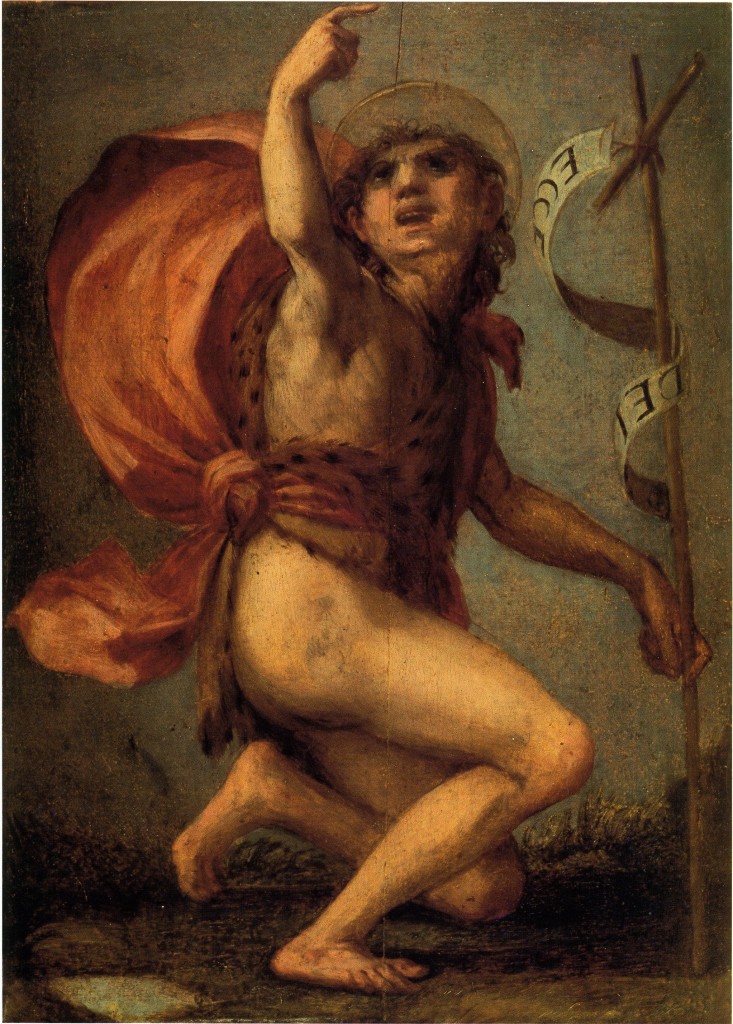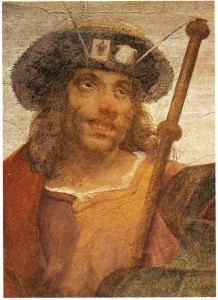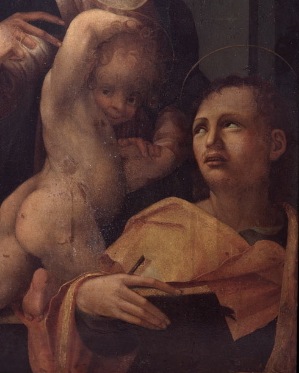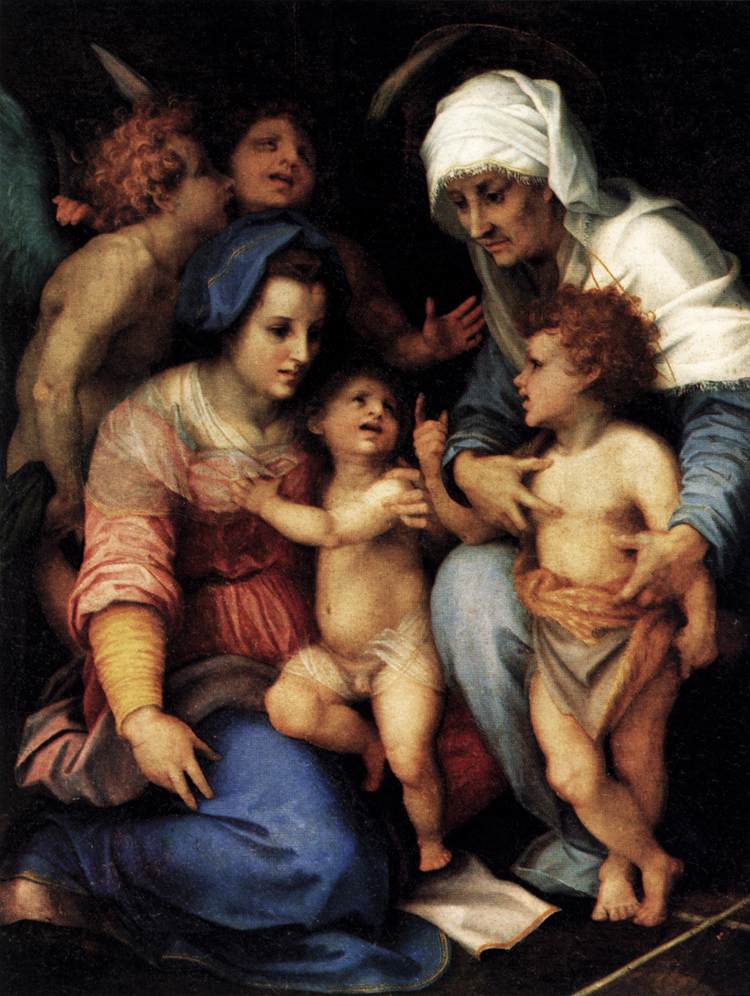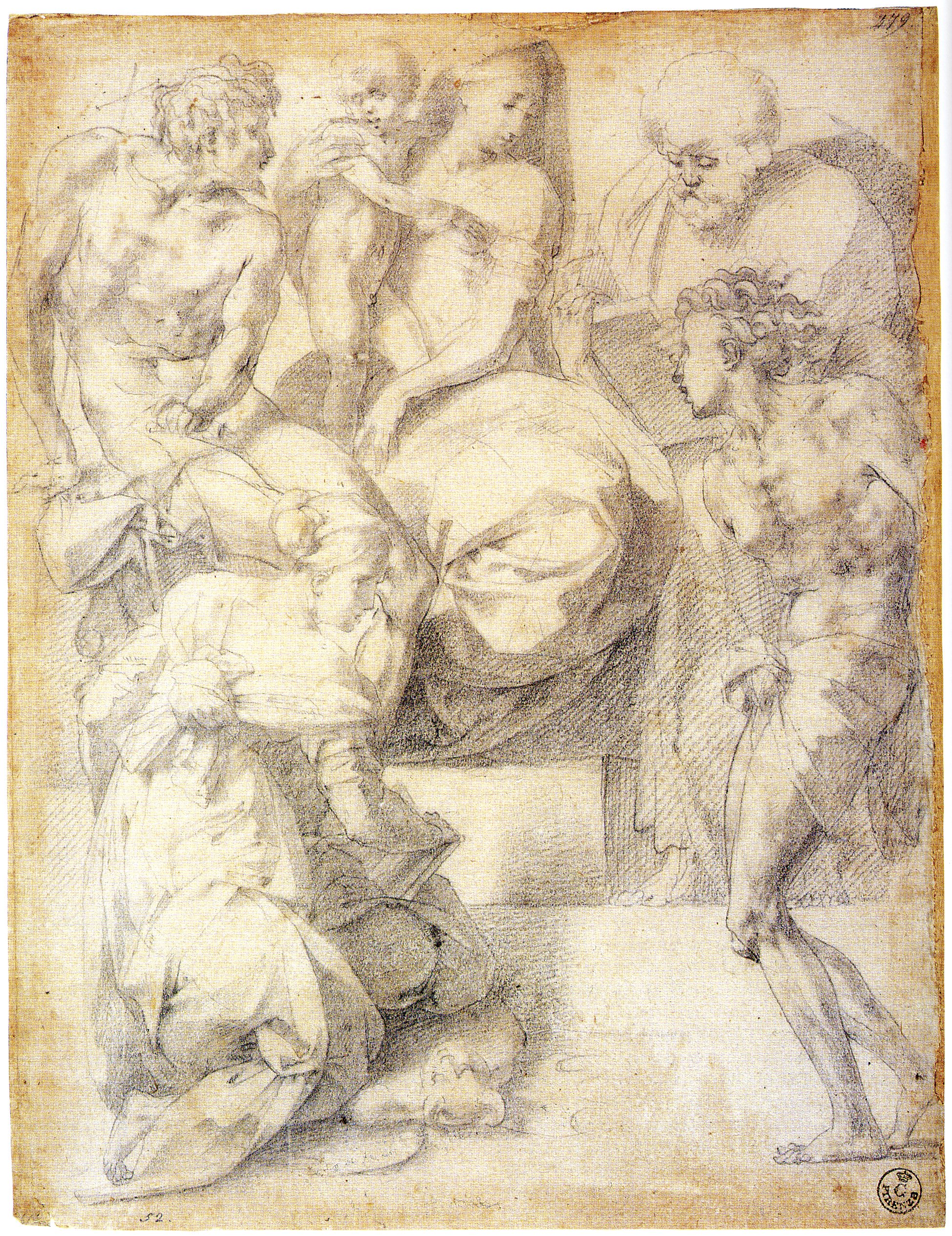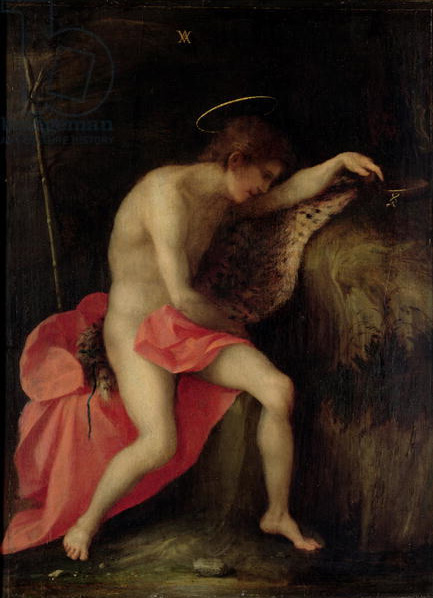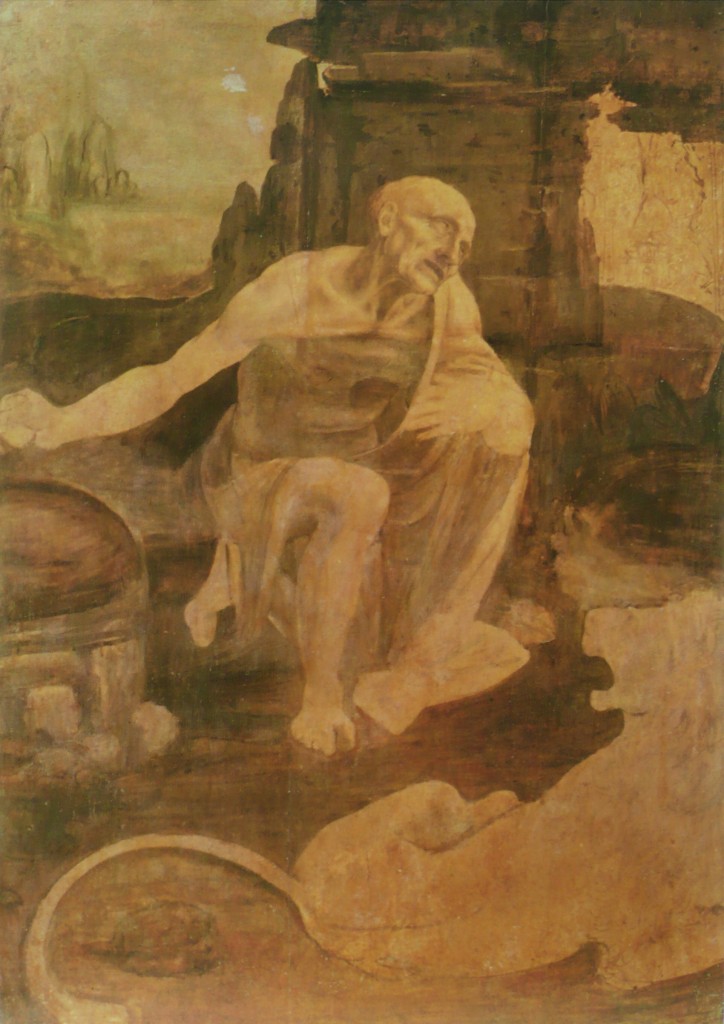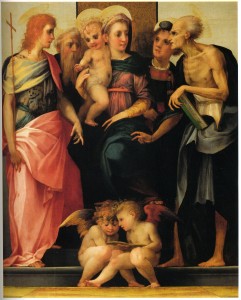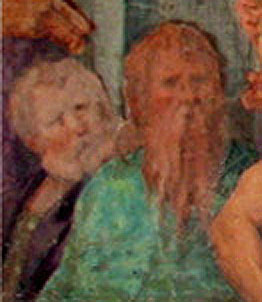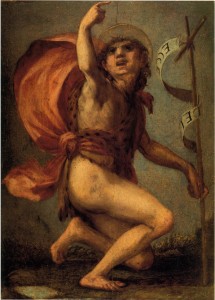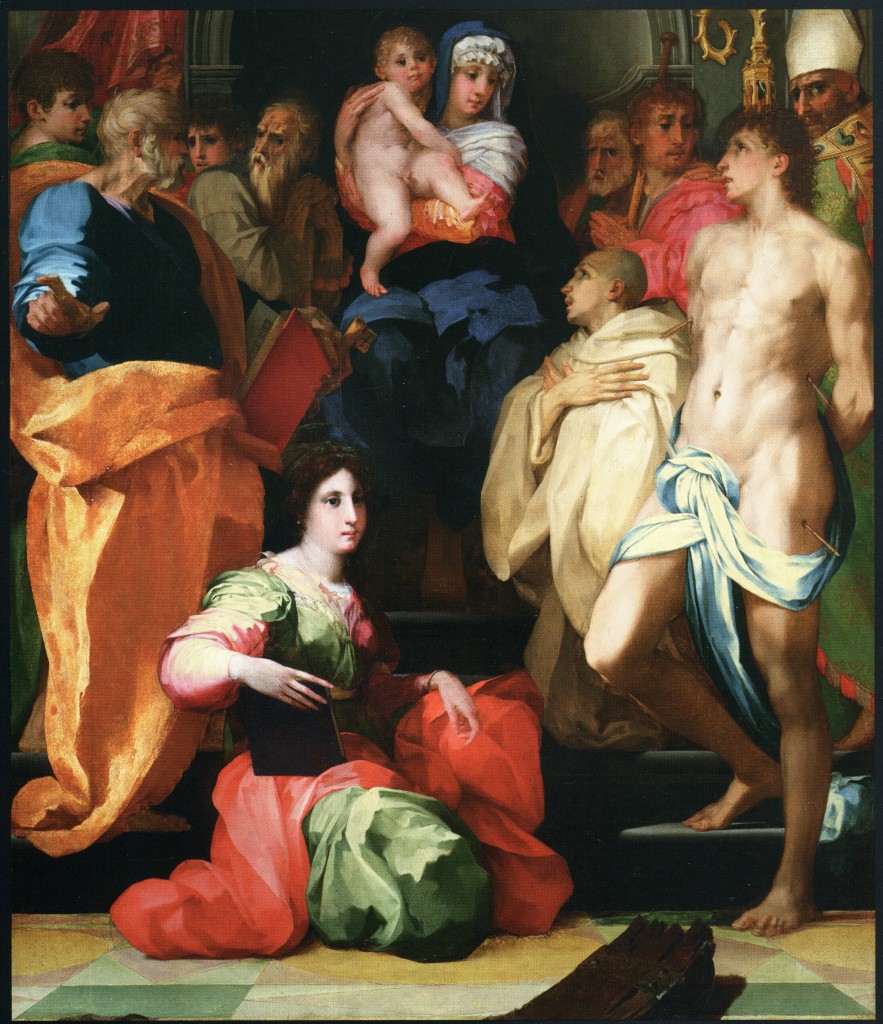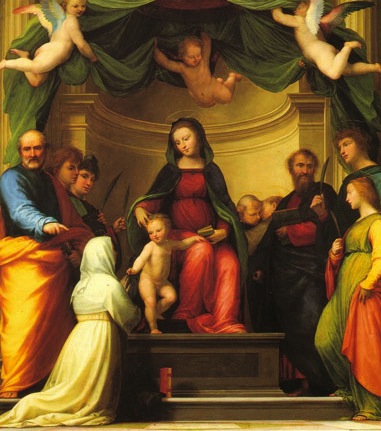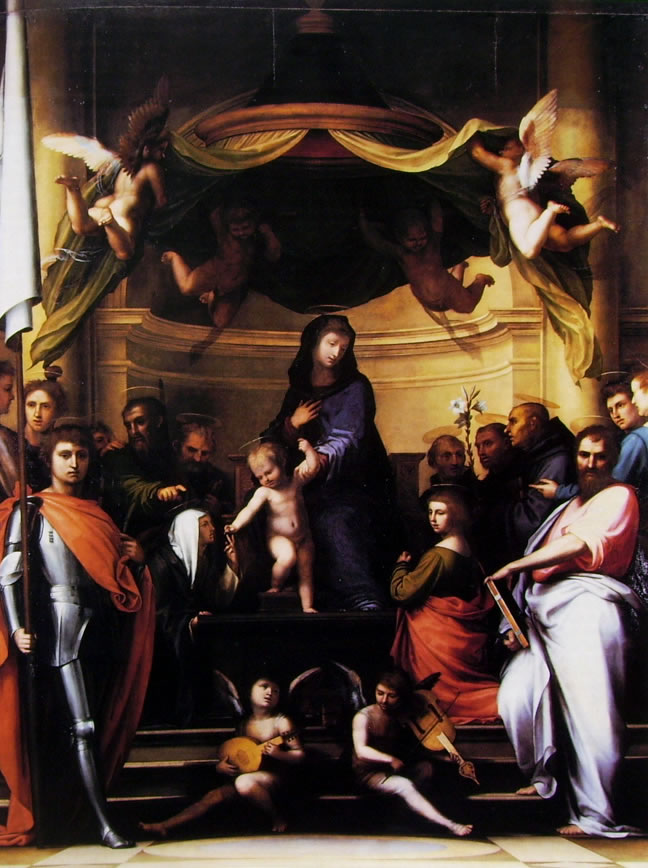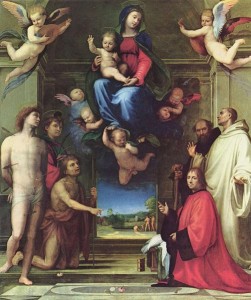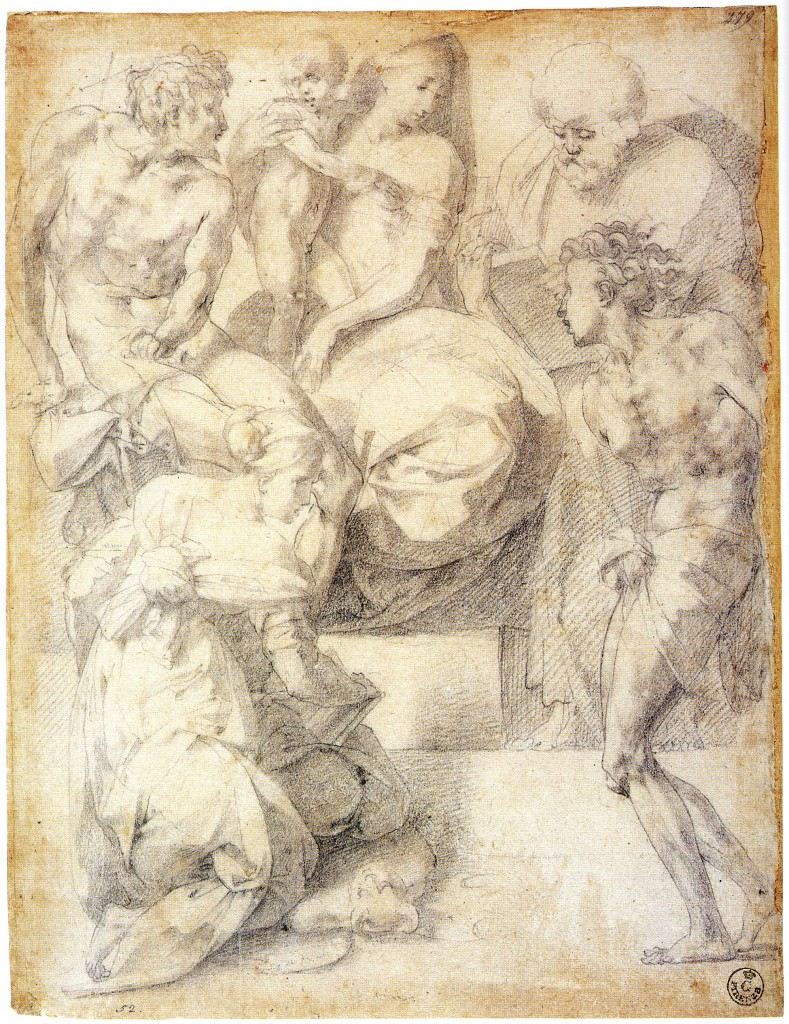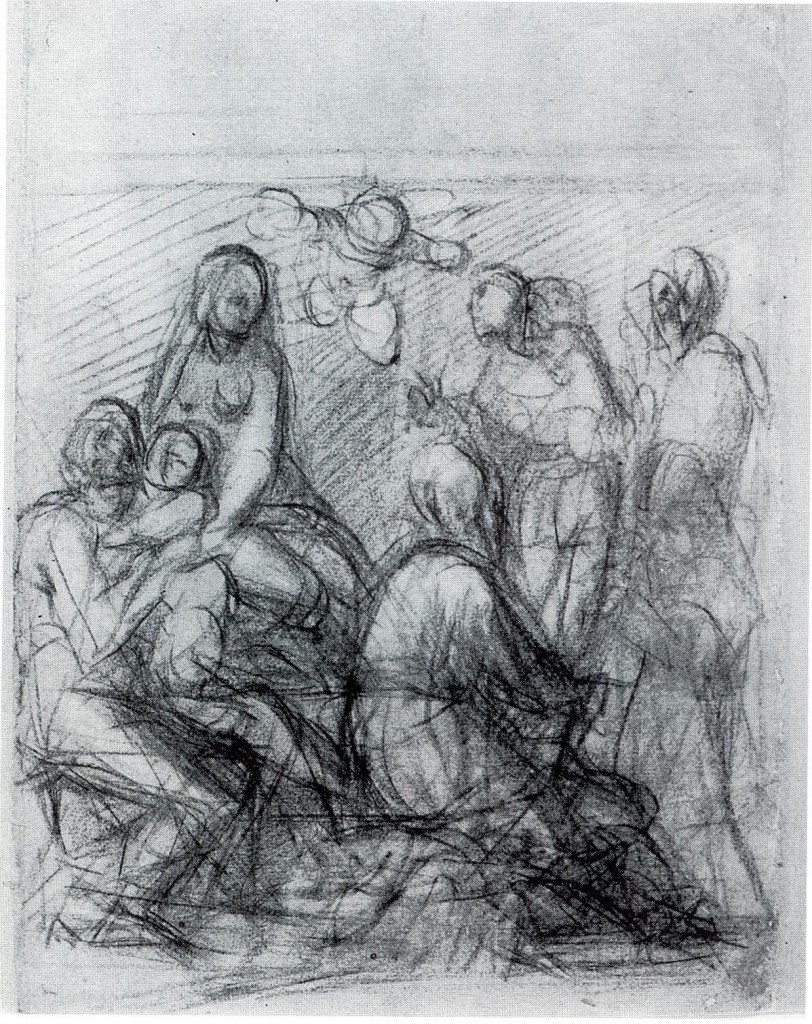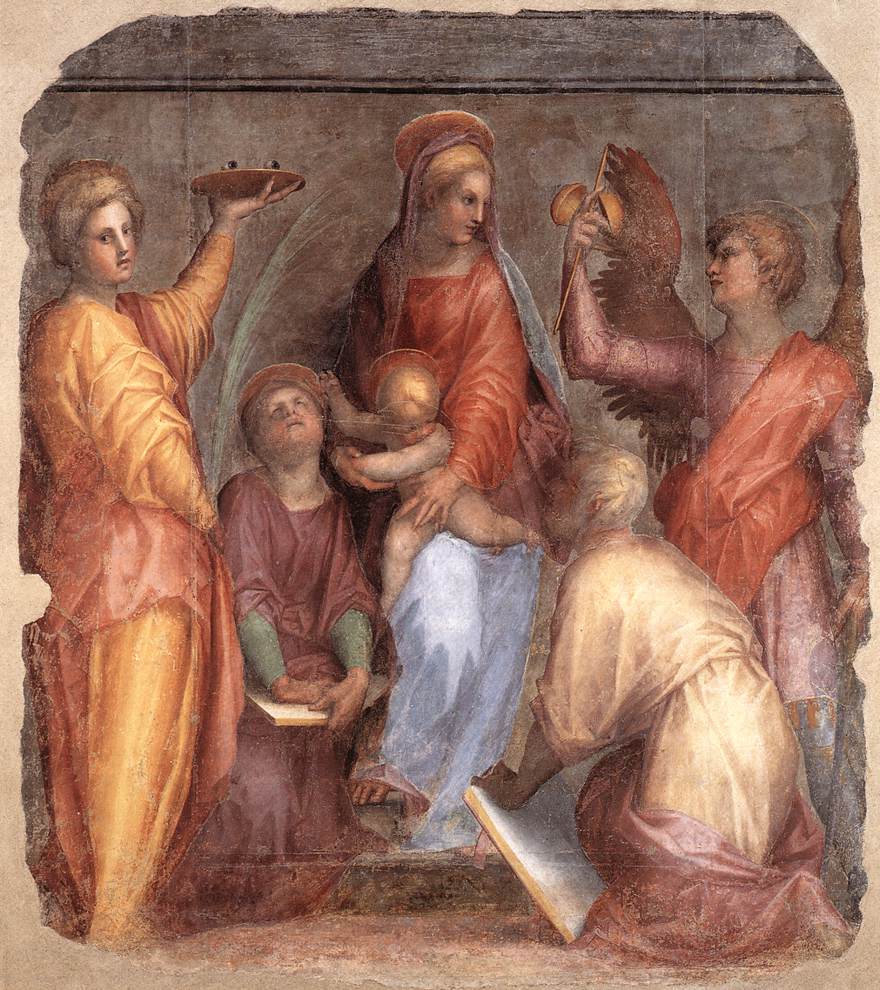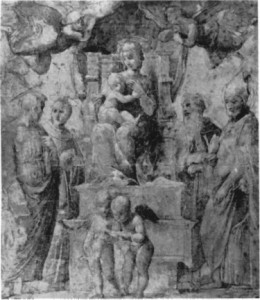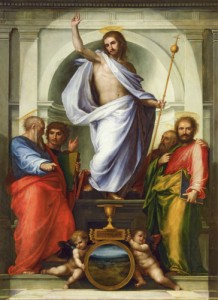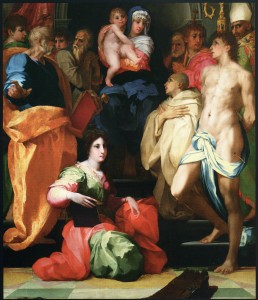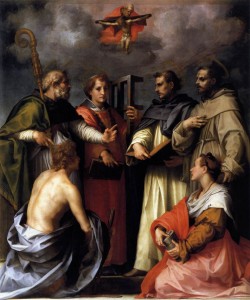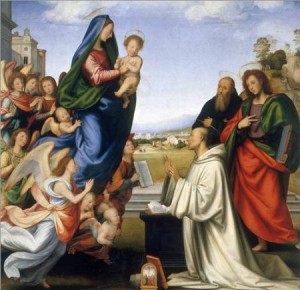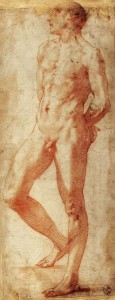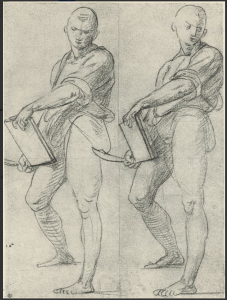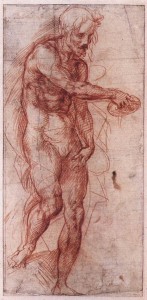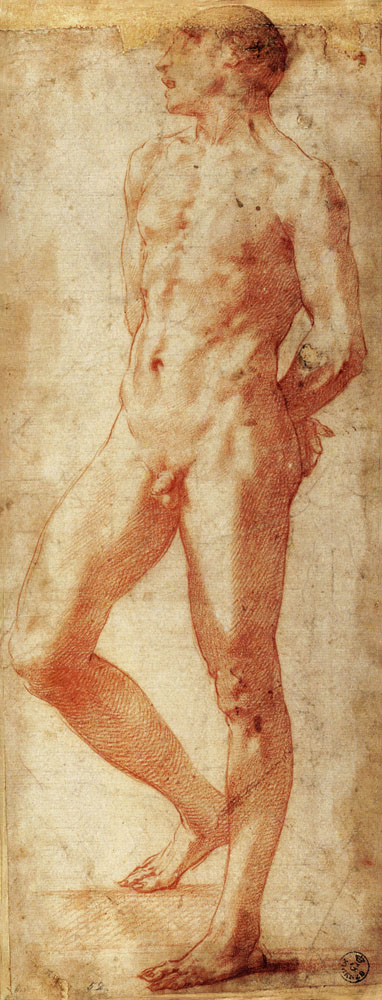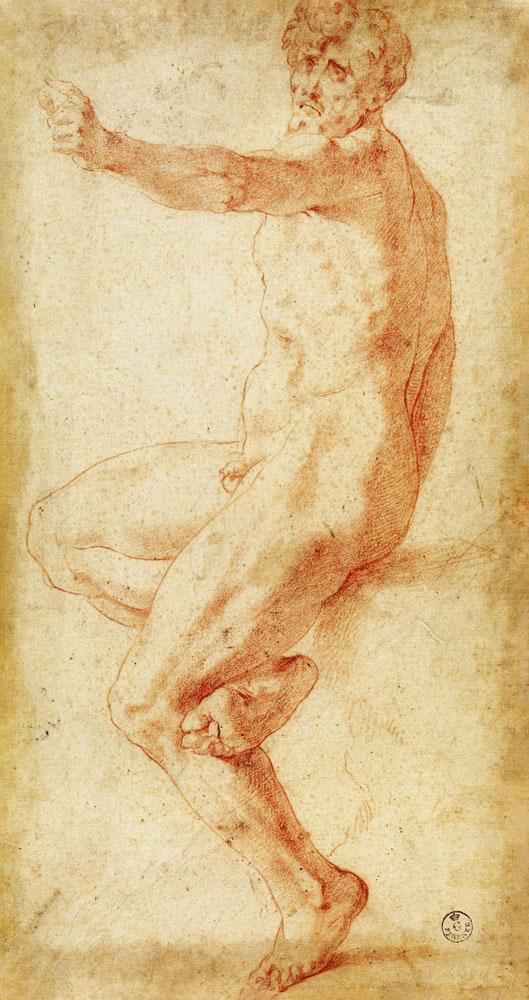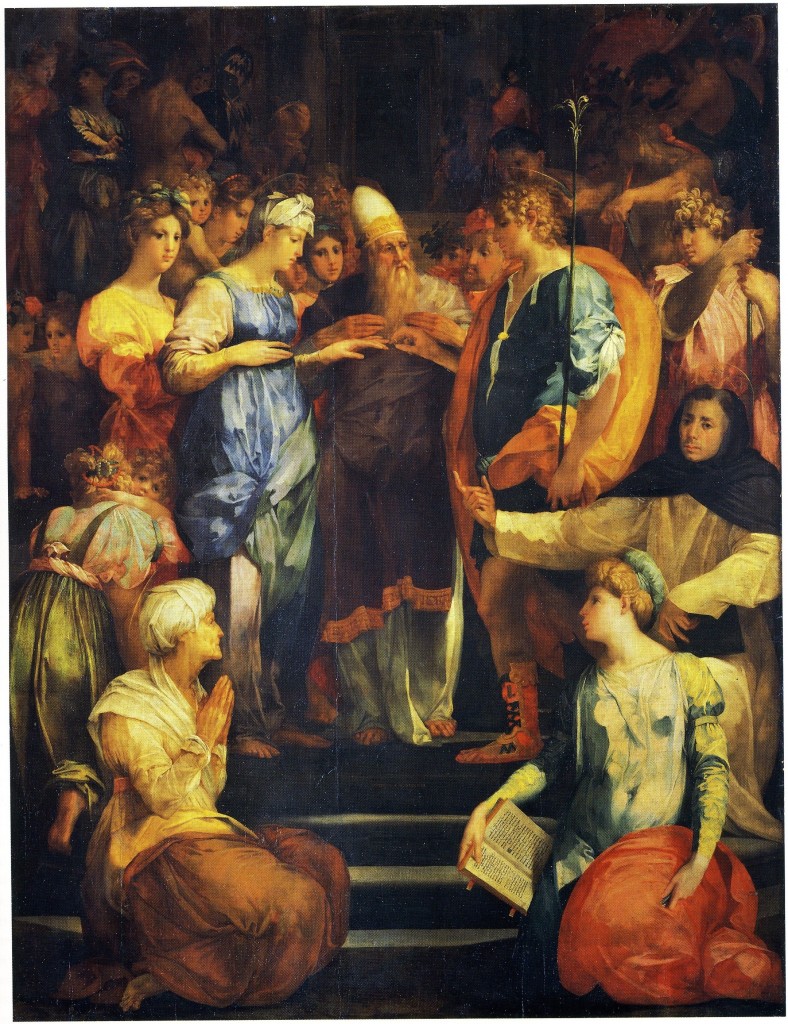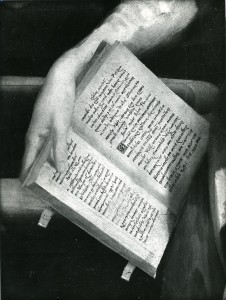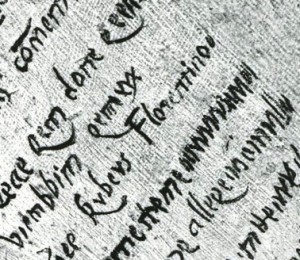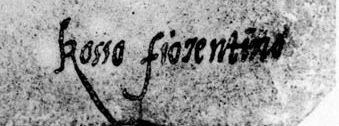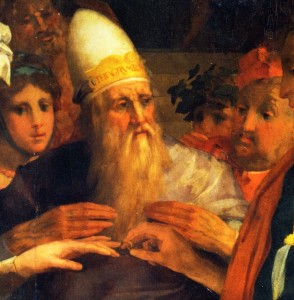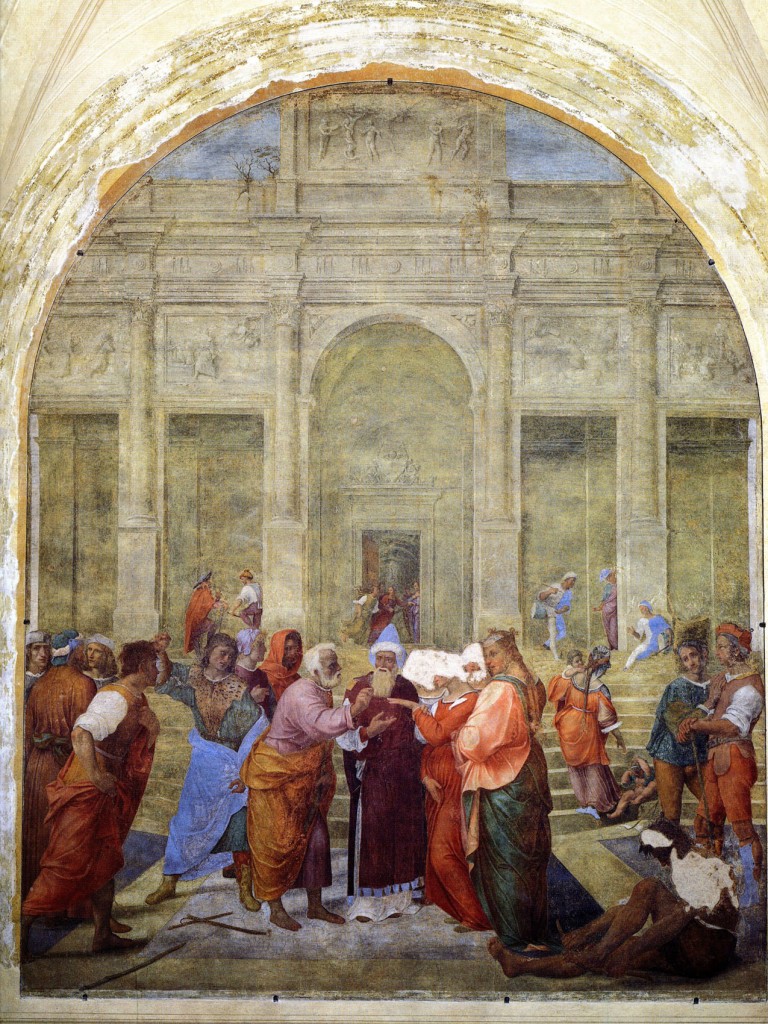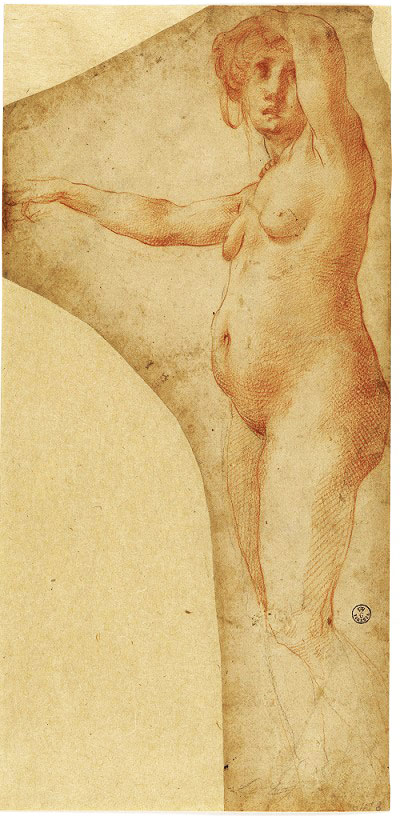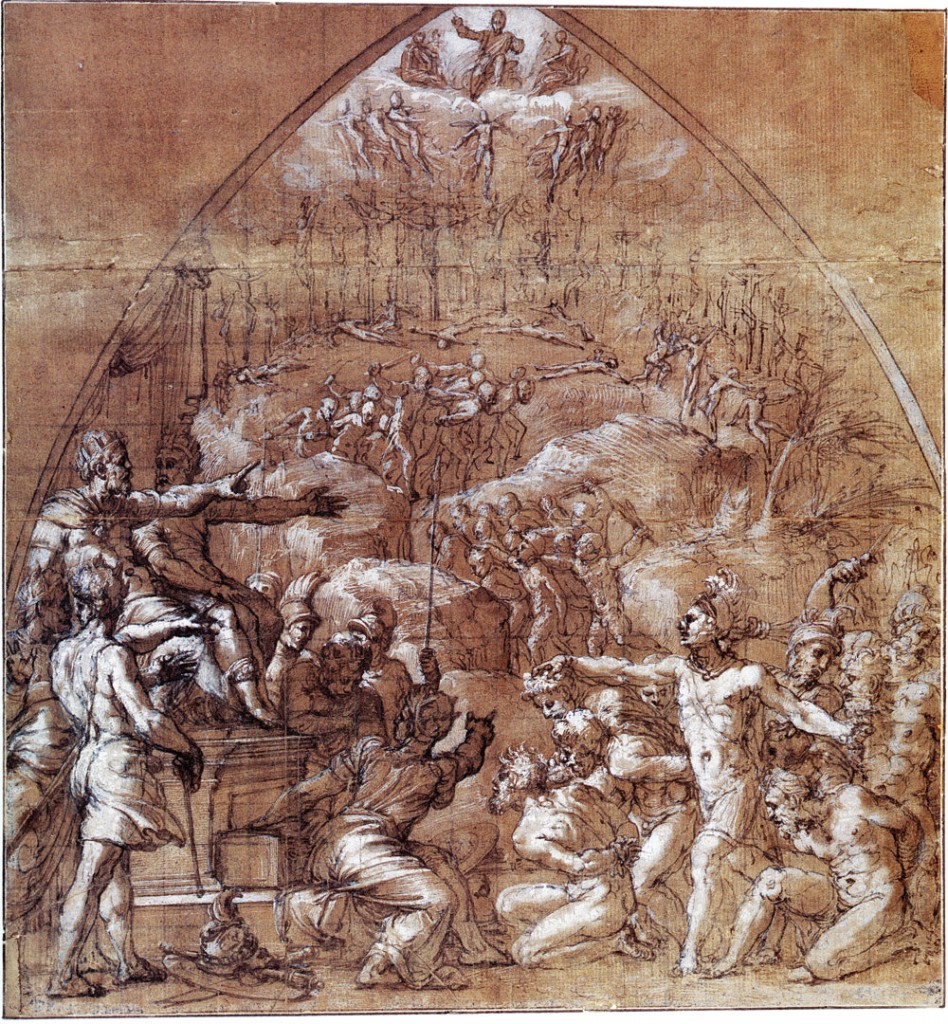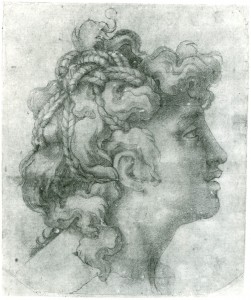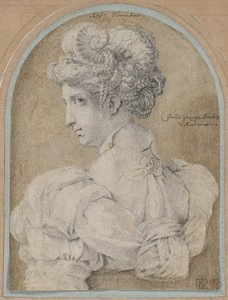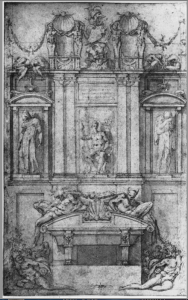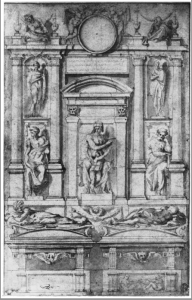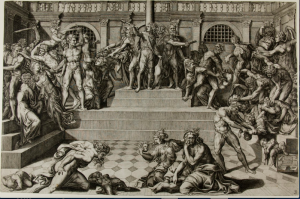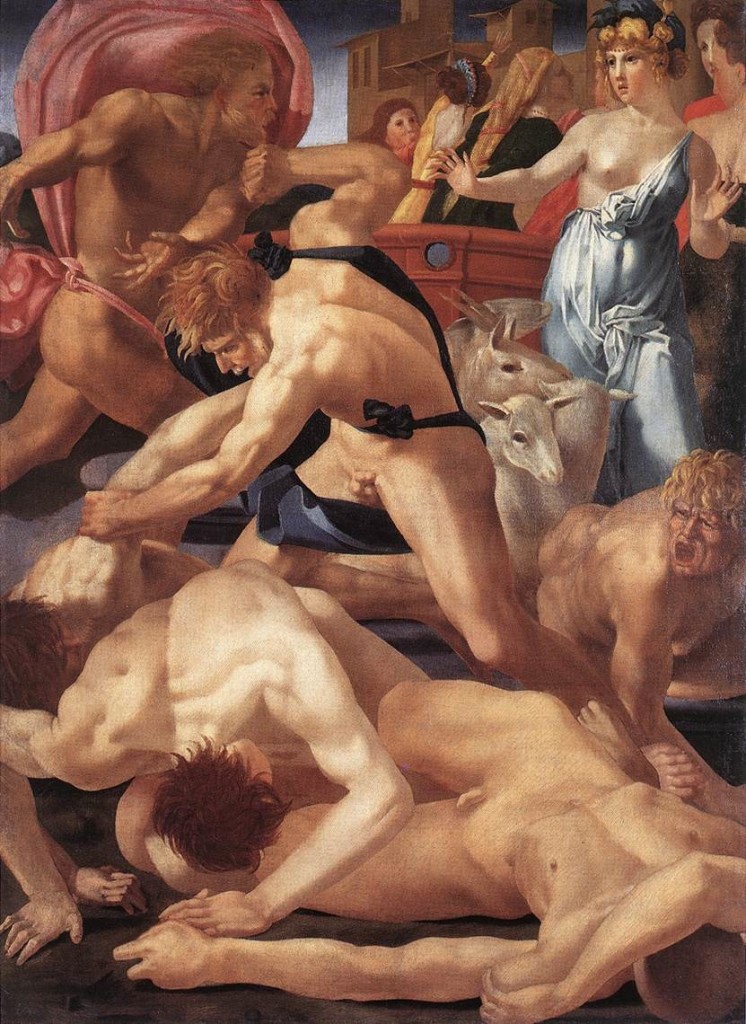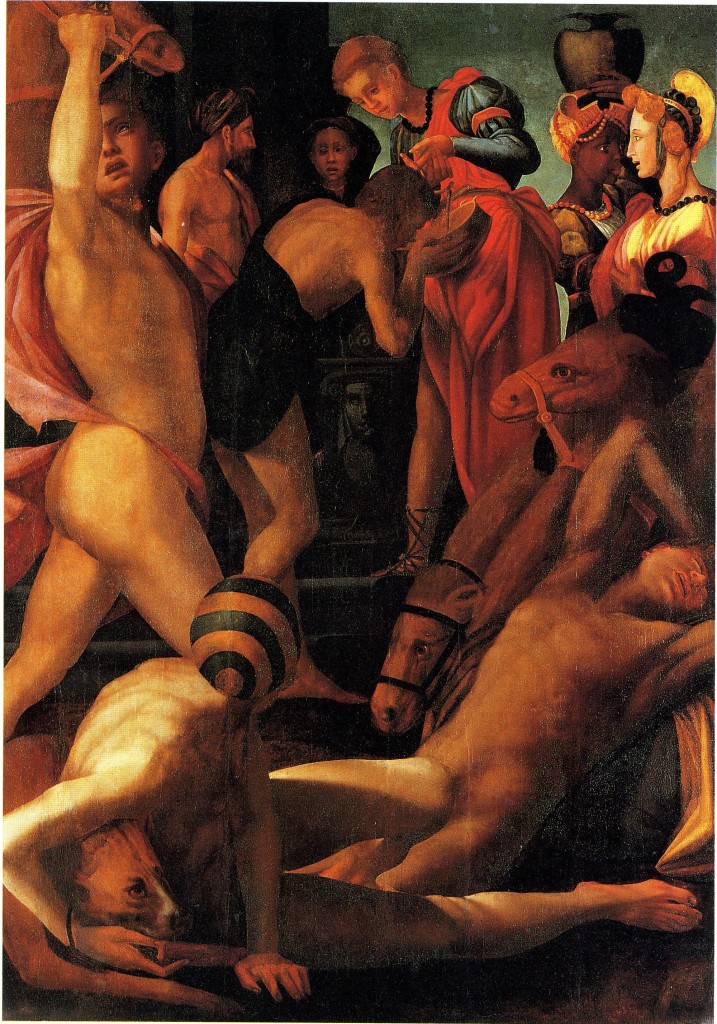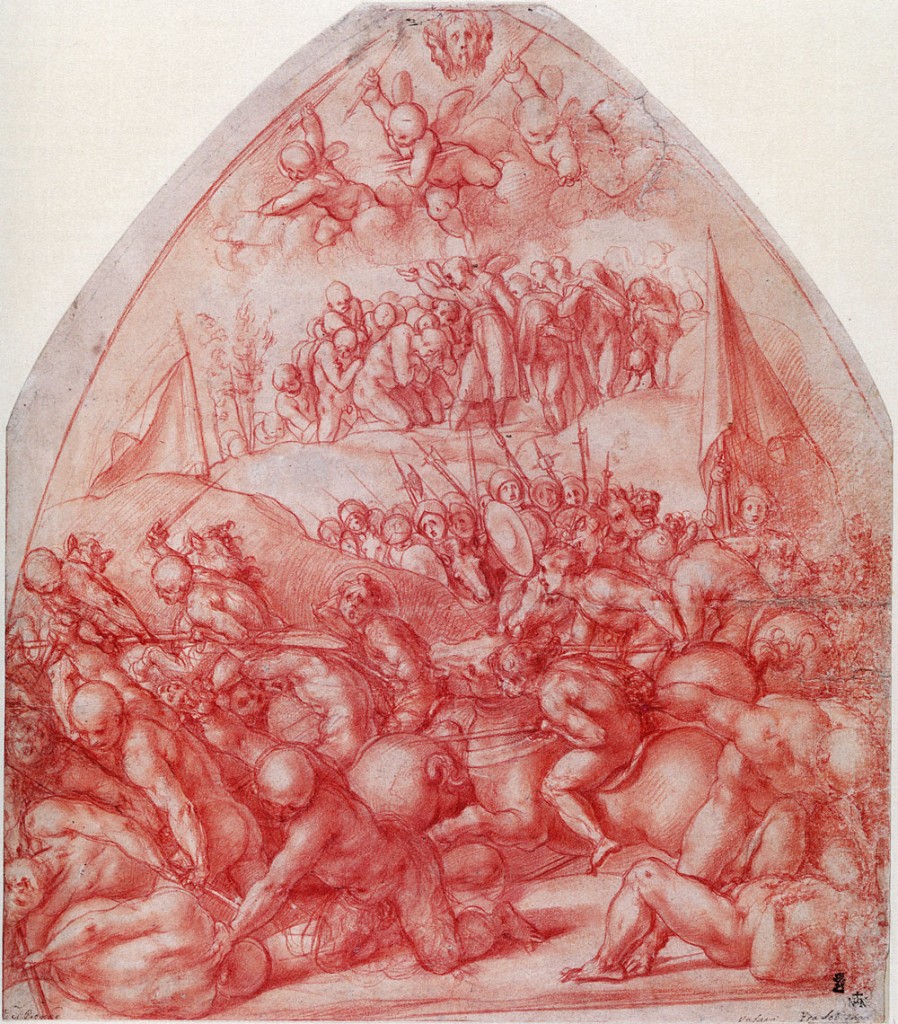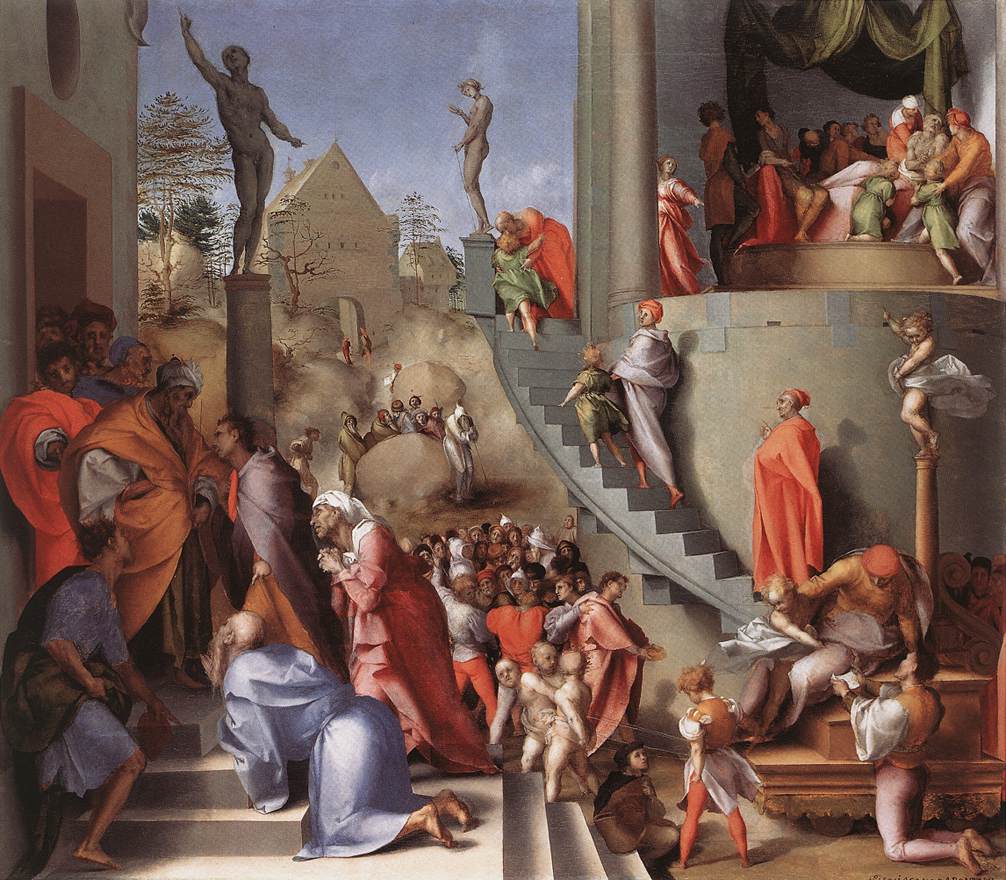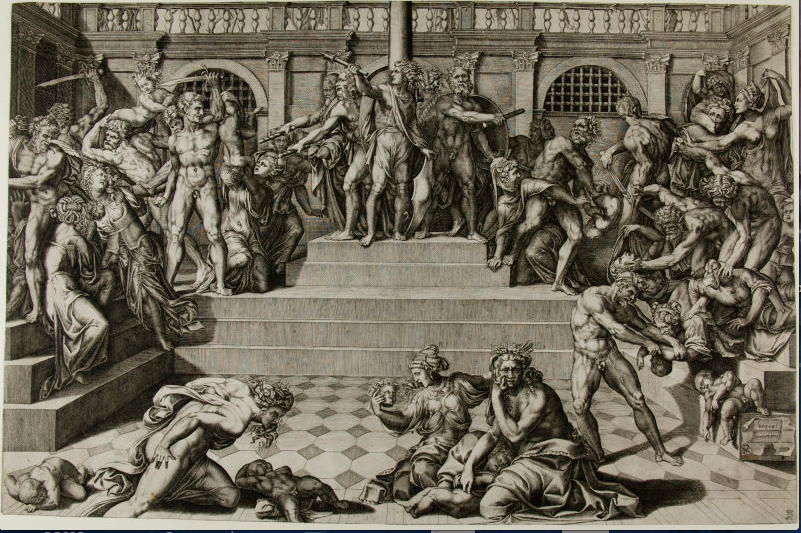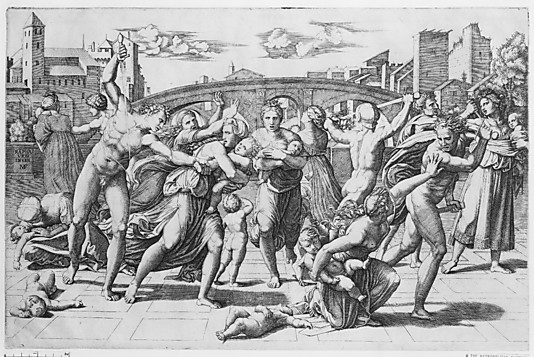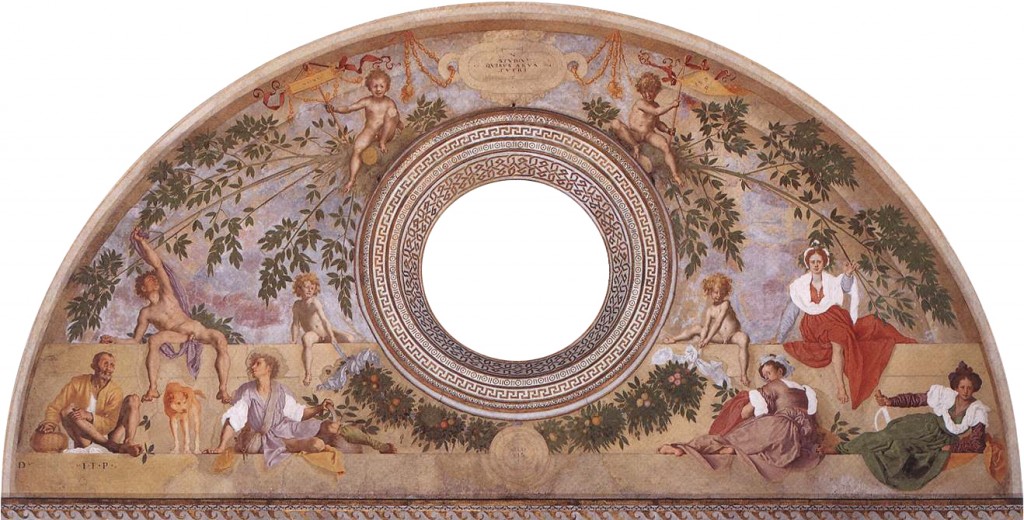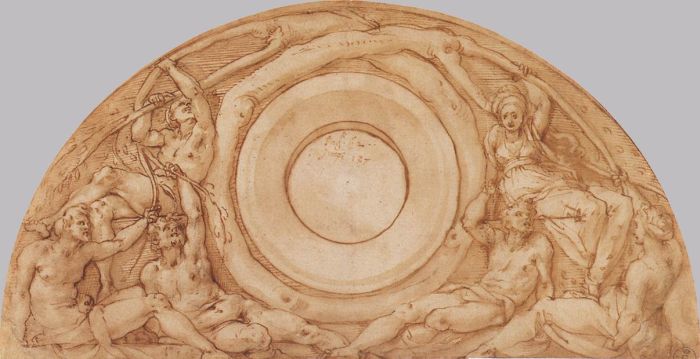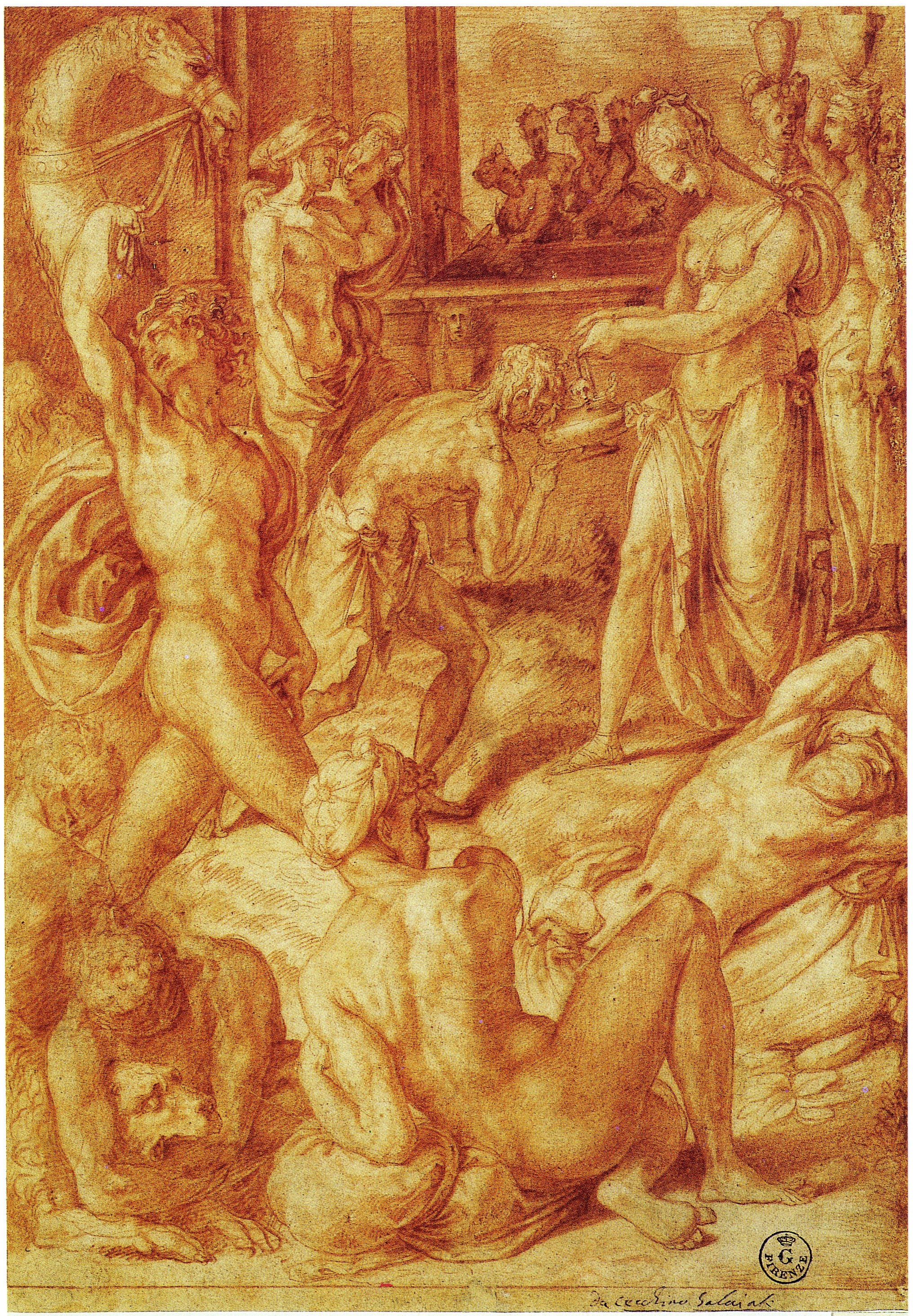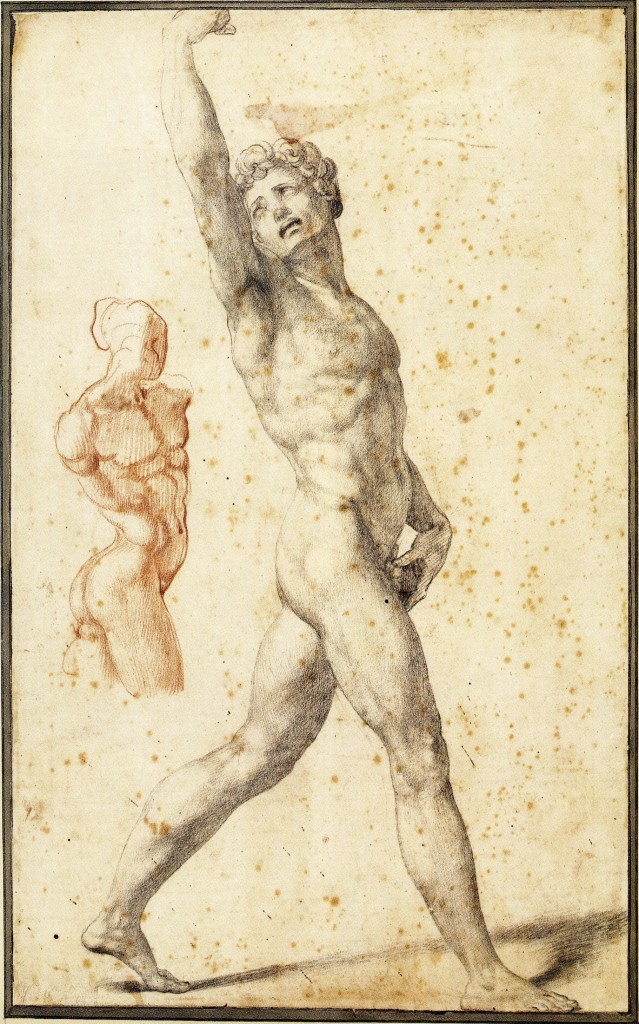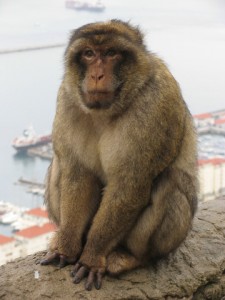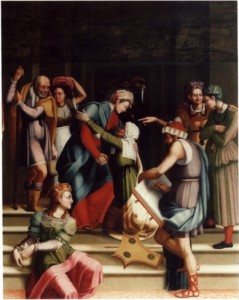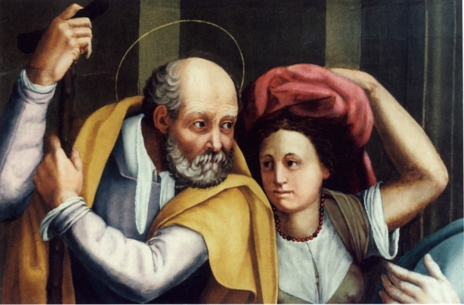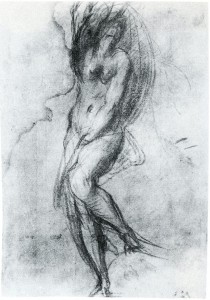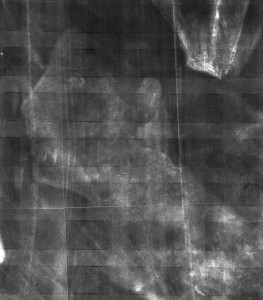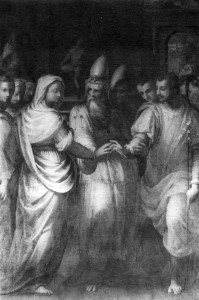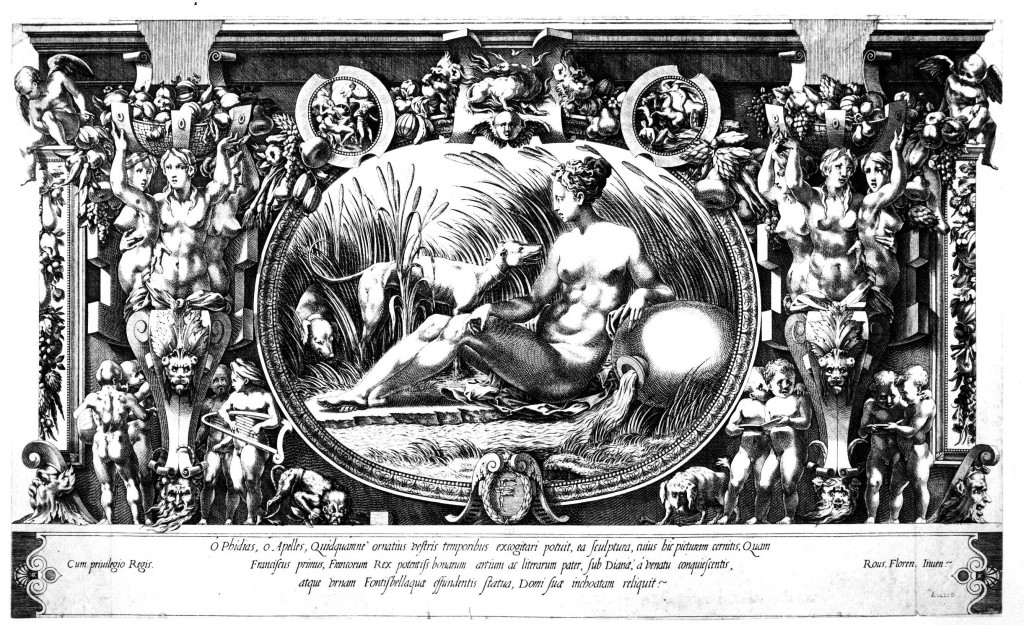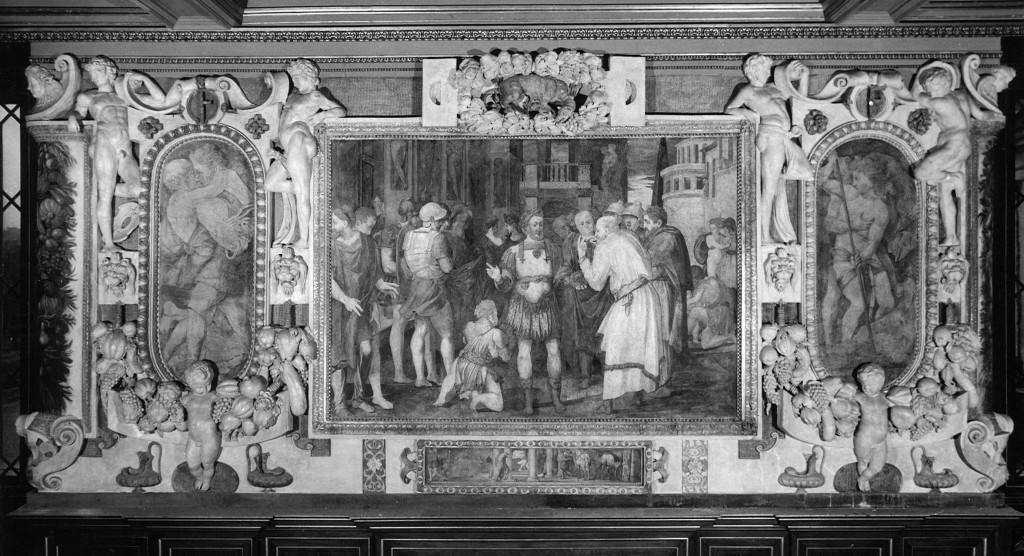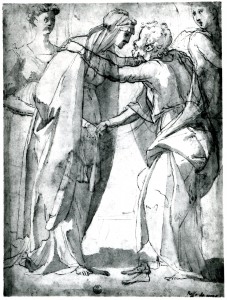When Rosso returned to Florence late in 1521 or early in 1522 it was three and more probably four years since he had painted a major picture there. That picture, the S. Maria Nuova Altarpiece, had not been found acceptable by the spedalingo who commissioned it. Rosso’s only work on public display was the Assumption in the atrium of SS. Annunziata, painted five years earlier in 1513–1514 (P.3), and that, too, had been the object of adverse criticism. Admiration of his work in Florence, such as it was, would seem to have been of a special and private kind and in certain respects, given the subject, style, and expression of some of his paintings and drawings, was dependent on the appreciation of a particular group of admirers at the Servite church. Further interest in his art appears indicated by the publication in 1518 as an engraving by Agostino Veneziano (Fig.E.109) from Rosso’s large Disputation of the Angel of Death and the Devil made as a disegno di stampa in 1517 (Fig.D.1a). This dark image was sufficiently popular to prompt a few years later another engraving of Rosso’s drawing by Marco Dente (Fig.E.51), making knowledge of this scene likely beyond Florence and Rome and beyond Italy, sending its imagery back to the site of sources from which Rosso originally drew inspiration. But it was not until 1521, and then outside Florence, that the full power of Rosso’s genius found expression in his great Deposition in Volterra (Fig.P.9a) and in the small but fervent altarpiece from Villamagna (Fig.P.10a).
In Florence alongside Rosso’s genius only Pontormo’s presented the same high level of artistic inventions, although with individual histories of achievement and patronage that were quite different. A parallel account of their activity in these years gives a partial but relevant picture of Rosso’s position as an artist in relation to that of his most important competitor until around 1522.1 For the carnival festivities of early February 1513 succeeding the restoration of the Medici in 1512, Pontormo painted figures and scenes for the chariots of the Company of the Diamond, the impresa of Piero de’ Medici, and for the Company of the Broncone, the impresa of Lorenzo de’ Medici. Rosso was not employed for these festivities. In September of 1513, and named Giovanni Batista dipintore in the documents, Rosso was paid for assisting Andrea di Cosimo Feltrini in the painting of the arms of Pope Leo X and of his cousin, Giuliano, at SS. Annunziata (L.5), where his brother was a friar. Now working alone when paid in September of 1515, he was occupied with a larger commission for the arms of Leo X with two young men supporting them over the door leading to the cloister of this church (L.9). Pontormo had a larger commission at the center of the façade of the Servite church executing between late November 1513 and early June 1514 the figures of Faith and Charity with angels flanking the sculpted coat-of-arms of Leo X that Feltrini has painted. At the same time Rosso did his fresco of the Assumption of the Virgin in the atrium of this church. Next to the Assumption Pontormo painted the Visitation between November 1514 and June of 1516 during the time that Rosso’s fresco was badly criticized and threatened with destruction. In these years an artistic struggle was taking place between Fra Mariano, who supported Pontormo, and Fra Jacopo, who was Rosso’s mentor.
In 1514 for the annual procession celebrating the Feast of St. John the Baptist, the patron saint of Florence, on 24 June, Pontormo executed figures and scenes for the Chariot of the Florentine Mint. Rosso was not engaged for this event.
The reflectographs of Rosso’s Angel Playing a Lute in the Uffizi (P.4) and the x-radiograph of his Portrait of a Young Man in Washington (P.8) give evidence of a single panel from which the two panels of these paintings were cut. The original single panel was the support of a small altarpiece showing the Enthroned Madonna and Child (L.11) with at least one standing saint at each side, a man with a staff at the left, possibly a pilgrim saint, and St. Catherine of Alexandria at the right with the wheel of her threatened execution at her right. A date late in 1514 or in 1515 seems suggested by the style of the musical angel and the single profile of St. Catherine visible under the male portrait. No evidence of other saints has appeared next to these two, nor any indications of why the altarpiece was abandoned and then cut into pieces by the artist for the support of a portrait and in order for Rosso most likely to keep for himself the musical angel from the original composition.
Rosso and Pontormo worked again on a single event for the grand procession of the entry of Leo X into Florence in November of 1515, Rosso as architect and painter of the Arch of Triumph dedicated to Hope (L.12), Pontormo as the painter of figures and scenes of the arch constructed by Baccio da Montelupo in front of the stairs leading to the Bargello. In addition Pontormo executed the figural parts of the extensive decoration, with grotesques by the brilliant Andrea di Cosimo Feltrini, of the papal apartment and chapel at S. Maria Novella in which Leo X resided upon his return from Bologna in December of 1515. In the chapel the pope may have blessed the marriage of Pierfrancesco Borgherini and Margherita Acciaiuoli, in celebration of which Pontormo was commissioned, along with Sarto, Granacci, and Bacchiacca, to execute paintings for the decoration of the couples’ bedroom in 1515 and 1516. The celebration of another prestigious marriage a couple of years later was marked by the decoration of the antechamber of Giovanmaria Benintendi, another fervent supporter of the Medici, with works by Sarto, Bachiacca, and Franciabigio and an Adoration of the Magi by Pontormo, the whole enterprise in imitation of the elaborate decoration of the Borgherini Bridal Chamber. Rosso was again not called upon to paint pictures for these domestic but prestigious projects.
On 18 April 1517 the contact for Rosso’s commission to do another fresco in the atrium of the Annunziata stipulated that if he did not do better than before, referring back to the adverse criticism of his Assumption, that he would not be paid for this new work (L.10). It was never painted. But in January of 1518 he was commissioned to execute a modest size altarpiece by the spedalingo of the Hospital of S. Maria Nuova, acting as the executor of the final testament of a Spanish woman resident in Florence (P.5). That same year Pontormo dated his altarpiece painted for Francesco di Giovanni Pucci, another firm Medici ally, and placed in the recently acquired family chapel in S. Michele Visdomini.
This was, however, only after the family’s failure in 1517 to obtain a funeral chapel in SS. Annunziata although in November of 1513 Rosso was paid for painting the arms of Lorenzo Pucci (L.8), who had just been made a cardinal by Leo X, in the atrium of this church, over the door to their chapel dedicated to St. Sebastian, the principal entrance to which is at the right end of the exterior façade of this Servite church. Vasari referred to the red haired artist at this time, when he was still nineteen, as essendo ancora sbarbato, that is being not yet bearded in the sense of not needing yet to shave. At the end of 1518 the spedalingo took a dislike to Rosso’s altarpiece that he commissioned at the beginning of the year and had it sent out of Florence to a distant church in the Mugello where it was more or less hidden until it was brought to the Uffizi toward 1841.
What is clearly evident in the unfolding of the simultaneous careers of Rosso and Pontormo is the steady pace of Pontormo’s against the uncertainly of Rosso’s in Florence. The beginnings of both of them lay outside the once necessary placement of boys as apprentices in the shop of an established master. Pontormo, according to Vasari, after being with Leonardo, Albertinelli and Piero di Cosimo for short periods, served for a while in 1511 and 1512 as an assistant to Sarto who recently had done a series of frescoes in the atrium of the Annunziata. Through Sarto and Fra Mariano at the Annunziata, the young Pontormo was assigned the Visitation in the atrium of the church. As already noted, in 1513–1514, he was favored by Andrea di Cosimo Feltrini as the artist for the Faith and Charity with angels alongside the sculpted coat-of-arms of Leo X that he, as a master of Medici emblems, has just painted. At S. Maria Nuova, Pontormo and Feltrini worked again together the following year to accommodate the Medici pope. Thereafter Pontormo’s major patrons, the Borgherini, Borghini and Pucci families, were all supporters of the Medici upon their return from exile, that long absence that had begun in 1494, the year of Rosso’s and Pontormo’s birth.
It was precisely within these years that Rosso grew up in Florence where he was born, in the parish of S. Michele Visdomini, into a family whose origins were in the Tuscan town of Civitella, a short distance northeast of Arezzo. Rosso’s father, Jacopo di Guasparre di Giovanni da Civitella, was still identified by his place of origin while his painter son with red hair, Giovanni Baptista di Jacopo di Guasparre, was not, seeming to indicate that the family’s arrival in Florence may have been one generation earlier. As discovered by Waldman, Jacopo di Guasparre became a member of the household staff of the Florentine Signoria, a post he held until he resigned it in favor of his nephew, Domenico di Guasparre. This position he might instead have passed on to one of his three known sons, neither of which, however, chose, if the choice was his, to be in servitude. Rosso’s two brothers became friars, at SS. Annunziata and at S. Maria Nuova. By birth Rosso was Florentine as the name he adopted declares.
Pontormo was born in the town of Pontorme, across the Orme River from Empoli, west of Florence. When he was thirteen, according to Vasari, his widowed mother brought him to Florence to live with a distant relation and to register the small family property in Pontorme that would be his.2 His only work painted in Pontorme was an early fresco above the door to the castle showing the arms of Leo X with two putti.
So important need be the artist chosen by the governing citizens of Pontorme to establish the prestige of the Medici family, so important need also be his loyalty to the Medici family that the images he made for and of them would be unquestionably seen as sympathetic and truthful, and so fine as works of art must his works be in order to capture the imagination of those who saw them, that only Pontormo was thought to be the artist who could and would fulfill all these needs in his home town again, like Florence, under Medici sovereignty.
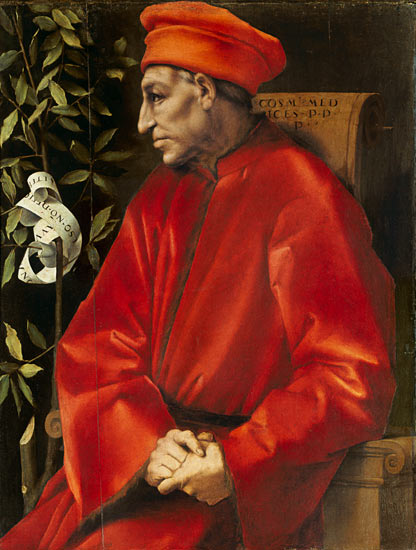 So, then, was it for the symbolic representation of the revival of the Medici family upon the break of its line with the death of Lorenzo, Duke of Urbino, on 4 May 1519, that it was to Pontormo that was entrusted the commission to paint a portrait of the long deceased Cosimo Pater Patriae with, at his side, the Broncone, cut but with a new branch of vigorous growth already having sprouted from its trunk. Following upon this remarkable achievement for the Medici family Pontormo was charged to paint one of the large lunettes in the banquet hall of the Medici Villa at Poggio a Caiano where the themes of the young branch and a new springtime for the Medici family were beautifully evoked. Two sections of the lower walls of this room were painted by Franciabigio and Sarto with scenes from Roman history before the project was stopped upon the death of Leo X on 1 December 1521. Rosso was out of Florence in these few years and probably did not return to the city until early in 1522. But then, had he not been away it is doubtful that he would have been chosen to work alongside these other artists at this Medici villa. For even the Medici coat-of-arms he did were not Medici commissions. What work Rosso had upon his return from Volterra had to be made up from what was available outside of the major commissions from the ruling family. This was a loss that shaped whatever Rosso was given to do by others, to achieve now according to those patrons’ tastes, in so far as he was able to do this.
So, then, was it for the symbolic representation of the revival of the Medici family upon the break of its line with the death of Lorenzo, Duke of Urbino, on 4 May 1519, that it was to Pontormo that was entrusted the commission to paint a portrait of the long deceased Cosimo Pater Patriae with, at his side, the Broncone, cut but with a new branch of vigorous growth already having sprouted from its trunk. Following upon this remarkable achievement for the Medici family Pontormo was charged to paint one of the large lunettes in the banquet hall of the Medici Villa at Poggio a Caiano where the themes of the young branch and a new springtime for the Medici family were beautifully evoked. Two sections of the lower walls of this room were painted by Franciabigio and Sarto with scenes from Roman history before the project was stopped upon the death of Leo X on 1 December 1521. Rosso was out of Florence in these few years and probably did not return to the city until early in 1522. But then, had he not been away it is doubtful that he would have been chosen to work alongside these other artists at this Medici villa. For even the Medici coat-of-arms he did were not Medici commissions. What work Rosso had upon his return from Volterra had to be made up from what was available outside of the major commissions from the ruling family. This was a loss that shaped whatever Rosso was given to do by others, to achieve now according to those patrons’ tastes, in so far as he was able to do this.
VIRTÙ VANQUISHING FORTUNE
In 1522 Rosso executed a modest size altarpiece for the chapel of the Dei family in S. Spirito, a picture that was accepted, even if, according to Vasari, its merits were not at first wholly appreciated, although exactly why Vasari did not say. Following the two altarpieces of 1521 the Dei Altarpiece may now appear unremarkable, but such an evaluation may not concur with contemporary sixteenth-century opinion in Florence. Nevertheless, whatever specifically that opinion was it was almost certainly not formulated by comparison with Rosso’s altarpieces at Volterra and Villamagna, a comparison, however, that is decidedly a factor in our understanding of his Dei Altarpiece of 1522. First, however, should be considered two small and slightly earlier works of around 1521–1522 neither of which could have been widely known: the Virtù Vanquishing Fortune, a red chalk drawing in Darmstadt, and the small painting of St. John the Baptist in a private collection in Florence.
The Virtù Vanquishing Fortune is likely the cruelest image of early sixteenth-century Florentine art although it is not alone in the savagery it shows alongside actual acts of contemporary torture and executions. In the background to the right, Virtù with her right hand pulls Fortune back by her forelock and with her left hand rips off Fortune’s right breast. In the foreground at the left Virtù, now seated, grasps a length of flesh in her left hand and, holding the severed breast up by it for careful inspection in her right hand, contemplates it with her attention focused upon its very evident nipple. Largely through the writings of Niccolò Machiavelli and probably through private discourse in which he had a part, as at the learned gatherings of the Orti Orecellari that will be considered below, the ancient Roman subject of Fortune became a major subject of philosophical and political thought in fifteenth and sixteenth century Florence.
Depicted as a woman, as her linguistic origin in Italian requires, la Fortuna is grabbed by the forelock, borrowed from the personification of Opportunity (Occasio), and pulled back in order to subdue her.3 The intent is to control Fortune by man’s will or virtù, not having, however, the ability to destroy her completely. Nevertheless Machiavelli thought the bold could conquer her by force.4 In Rosso’s drawing Virtù, a masculine force although also linguistically female, viciously tears off the source of Fortune’s offerings and by so doing gains control, perhaps complete control, of her. While it is not possible to say how Rosso came to know of the Roman goddess Fortuna and of the importance of her breast these details would ultimately have come from Cicero and Martianus Capella.5 From these texts no other artist seems ever to have created an image of the total theft of Fortune’s power that even vaguely resembles Rosso’s. In France, very likely when Rosso was there around 1537, Cellini created on the reverse of a medal of Francis I a heroic depiction of its inscribed VIRTVTE DEVICIT FORTVNAM that shows Fortune, naked and with prominent breasts, stretched out supine on the ground being beaten with a club by Virtù whose rearing horse tramples upon her.6 While not as intimately cruel as Rosso’s image the relief suggests the intention of the complete destruction of Fortune.
In the De Divinatione (II, 41, 85), Cicero, writing in the first century B.C. of the worship of the goddess Fortuna at Praeneste (Palestrina), describes:
the statue of the infant Jupiter, who is represented sitting with Juno in the lap [gremio] of Fortune and reaching for her breast [mammam], and it is held in the highest reverence by mothers.7 Martianus Capella in his On the Marriage of Philology and Mercury, from the Christianized Roman Empire of the 5th century, writes in Book I, passage 88, The Betrothal: And then the most talkative of girls came flaunting and jumping about with nimble lightness, constantly unstable, extravagant now one way, now the other; some call her Sors, some Nemesis, many Tyche [Fortune], and other Nortia. She carried in her ample bosom [gremio] the honors and decorations of the whole world, and conferred them on some people, distributing them unexpectedly; while like a girl she plucked the hair of others, beating others on the head with a rod; while the same people she formerly flattered she wounded with frequent blows of her knuckles on their heads.8
By the early 1520s Rosso may have known Latin sufficiently well to read these passages himself, although it is not until about five years later in his Vita that Vasari mentions his study of the language. Vasari does remark that Pontormo’s grandmother had the boy Jacopo taught to read and write Latin for several years before he was thirteen,9 and this might have been a regular part of the early education of a young man of his class whose family had ambitions for him. As Rosso’s two brothers became friars and the artist himself became a cleric it is likely that all three had instruction in Latin when young. One of his brothers, Fra Filippo, with Fra Jacopo, both at the Annunziata, may have led the artist to these sources in Cicero and Martianus Capella and help him read them. Thus, when Vasari wrote that as part of his preparation to appear in France più pratico in tutte le cose ed essere universale, apparata la lingua latina10 it may not have been Rosso’s first study of the language. Furthermore, when Rosso went to Rome only two or three years later Latin sources and expression were certainly an important aspect of the inspiration of the compositions that he designed for Caraglio to engrave, for some of which inscriptions in Latin were created.
Rosso’s use of the passages from Cicero and Martianus Capella in the invention of his Virtù Vanquishing Fortune is the first example of one way in which ancient texts served him. The special importance of these two lies in their being the only ones that prescribe Fortune’s mammam as the source from which she conferred her benefits, but only benefits. Her malevolence was expressed by physical violence. Rosso’s conception deals only with one breast. The second breast of Fortune is barely visible although both of the small breasts of Virtù can be better seen, the far one slightly. It is possible that Rosso was influenced here by the vocabulary of the texts where gremio and mammam are in the singular.11
Intellectually Rosso’s conception of a final victory over Fortune in spite of Machiavelli’s indication that this was unlikely is related to what appears also in his Disputation of the Angel of Death and the Devil and in the Volterra Deposition. The urgency of the drama and the emotion in Rosso’s drawing may also recall, in the glance of Saint John the Evangelist and in the quill and book that he holds, the suggestion of his visions in Revelations in the very early picture known from the copy at Tours, in the disputation between John the Baptist and Jerome in the S. Maria Nuova Altarpiece, and in the foreboding of death in the altarpiece painted for Villamagna. Emotionally the Virtù Vanquishing Fortune is, furthermore, in some sense and feeling a sequel to Rosso’s poignant Standing Nude Woman of only a year or so before with its implications of human vulnerability, aging and death. Although the Darmstadt drawing is a finished work it does not have the full appearance of drawings with complete backgrounds that serve as models for engravings. In any case, the cruel interpretation of its subject makes it unlikely that it was meant to be engraved and disseminated. Furthermore, the emptiness and yet completeness of the composition within its veils of shadow from upper left to lower right is not characteristic of early sixteenth-century prints, nor of paintings of this period. As the finished work of art that Rosso intended but not as a disegno di stampa it is equally likely that its image is shaped by his reflection upon what might have been the situation of his own life and career now that he had returned to Florence. A similar state of mind underlies the contemporary depiction of his fanatic depiction of his namesake, the small painting of St. John the Baptist in a private collection in Florence. The Virtù Vanquishing Fortune may well be not only about Rosso’s own ambitions and his own fortune, but at the same time indicating by the intensity of its imagery the universality of the struggle it depicts.12
The Darmstadt drawing partially shares its emblematic character with the Volterra Deposition where, in both, the major forms are arranged largely parallel to the picture plane. The area occupied by the seated figure of Virtù is approximately equal to that of the two struggling figures in the background that are set diagonally across the surface of the sheet from the single figure. The bend to the right of Virtù’s seated body balances the tense leftward arc of Fortune’s torso, creating a compositional formality that tightly binds the two different episodes together. But while they are compositionally joined, the two parts of Rosso’s drawing also elicit equal attention separately. The spatial relationship of the two parts is made ambiguous by the sharp definition of the background figures in contrast to the less clear description of the seated figure in the foreground, resulting in a subtle reversal of what would normally be the case. At the same time in the foreground Virtù’s braided hair is slightly more clearly drawn. By these means the separated single figure and the pair are more completely equated, as they may also be, reading them from left to right, by the reversal of the chronological order of the sequence of events. The space, however, also appears continuous by the passage of shadow extending from the lower left across to the center of the drawing and by that at the lower right extending upward. These are crossed by a screen of shadow that moves from the center to the right behind the struggling figures. The figures are illuminated by a raking light that is especially bright on the background figures, who cast thin, clear, and long horizontal shadows.
Virtù in the foreground is described almost entirely in terms of light and shade; even the fine undulating contour lines of her arms and back are so modulated as to suggest subtle variations of chiaroscuro. The lines and shading of this figure are smooth and regular and create the appearance of visual continuity with the light filled environment in which she is placed. But the contours of the figures in the background are more sharply drawn of lines that are shorter, broken, or repeated. These lines complement the angular, taut positions of these figures and heighten the sense of energy and pain in their struggle. But against the shadowed background the light on their bodies is more brilliant, and also sharper and more faceted, than the illumination of the seated figure in the foreground. Furthermore, the thrust of the drama follows the direction of the strong raking light in the background. Light is not merely the vehicle that makes the figures visible; it also dramatically reveals, as does the light, however different, in the Volterra Deposition, something of Rosso’s intuition of the meaning of his images.
Like the altarpiece at Villamagna the drawing at Darmstadt is conceived and executed with exquisite finesse. The parallelism of the background figures’ legs, the rotating pattern formed by their bodies and arms, and the flinging out of Fortune’s right arm with its pulled back claw-like hand, are not merely descriptive of such action as takes place here, nor only intelligently clarifying to give maximum sense to the movements of these figures. The composition of the drawing also makes a special conceit of the relation of these two figures, approximating visually the novelty of the thematic conception. The drama is seen not only as horrible but also as commanding of our attention, and an event that one might avoid looking at becomes a matter of keen interest through Rosso’s artistic finesse even as there still may well be a connection here with the attraction and repulsion of contemporary public torture and execution.
As we have seen there is a correspondence here with Rosso’s Standing Nude Woman of around 1520 who, with her beads and ribbons, appears most vulnerable in her nakedness, and from whom we might wish to avert our eyes. In the context of Central Italian art, if not in life itself, the cruelty and character of exposure in these works is extraordinary and suggests that Rosso has understood aspects of Dürer’s conceptions that even Pontormo, at the Certosa, did not appreciate or wish to emulate there. Nevertheless, there is a breadth and grandness to Rosso’s conceptions that move them beyond Dürer’s more particular concerns, suggesting some knowledge of Michelangelo’s art and of his Temptation and Expulsion on the Sistine Ceiling.
ST. JOHN THE BAPTIST IN THE WILDERNESS
The Darmstadt drawing, like the Volterra Deposition, is concerned with overpowering Fate, with the vanquishing of a condition that should be invincible. The feelings and actions of the figures test the limits of plausibility and even press upon us experiences that should normally be impossible. The small St. John the Baptist in the Wilderness of around 1521–1522 presents Rosso’s young namesake with the temper of a wild animal, suggesting an extension, in terms of feeling, of what is implied by the spotted wild animal skin he wears. Not only is this painting an ecstatic religious equivalent to the Darmstadt drawing, but the emotion of St. John is also an extension of the expression of Christ in the Volterra Deposition. The tilted back positions of their heads are almost identical and both also have their mouths open and their teeth visible. They are heirs to St. John the Evangelist in the early painting at Tours and to St. James in the Annunziata Assumption. Like the Deposition the St. John the Baptist is very loosely and thinly painted, although because of its small size the execution of the latter appears even somewhat broader and less sharply graphic.
The wild ecstasy of Rosso’s namesake suggests the emotion of the angels in Sarto’s Madonna and Child with St. Elizabeth in the Louvre, painted five or six years earlier. But already then extremes of feeling had been one of Rosso’s major interests. The expression verging on hysteria that is the meaning of Rosso’s St. John the Baptist is not, however, merely an emotional incident within the painting. The whole picture is about Rosso’s saint as totally consumed by his mission to exclaim: “ECCE AGNUS DEI” as inscribed on the banderole spiraling around his simple reed cross: “Behold the Lamb of God, behold him who taketh away the sin of the world.” (John I: 29). A patch of blue water at the lower left indicates his sacred role as baptist. Rosso’s painting is so closely related to his earlier work that it may be unnecessary to look elsewhere for a context in which better to understand it. Nevertheless, it becomes apparent that Michelangelo’s art was a factor in the generation of Rosso’s invention, carrying forward the Michelangelesque conception of the nude saints in Rosso’s Uffizi drawing for an altarpiece of around 1519. While not directly dependent upon a specific figure by Michelangelo, Rosso’s St. John the Baptist could not have come into being without Michelangelo’s precedents, without his establishing the possibility for such an action and for such emotion in his St. Matthew, in his Battle of Cascina and on the Sistine Ceiling. The emotion and apparent energy of Rosso’s figure may remind one of Michelangelo’s Isaiah and of his Jonah, although Rosso did not yet know these figures at first hand. However, the pose of the Baptist is also related to that of some of the figures in the lost Battle cartoon, and the saint’s billowing drapery can also be found there. Still, the vehemence of Rosso’s figure is not really a Michelangelesque emotion, but an extension of it. Furthermore, the anatomy and posture of the St. John do not reveal a profound knowledge of Michelangelo’s intentions; no contrapposto indicates the source of the bodily energy of Rosso’s figure or directs the course of its emotion. The foreshortening, not much found in Rosso’s earlier works, of the saint’s upper right arm is sufficiently unconvincing to disengage partly the effect of his gesture from the substance of his body. The shadow on this arm, on the armpit, and on the torso actually more conceals the forms of this figure than defines them. Instead of seeing the figure move through and turn in space, even if in a space that would be contained largely within the limits established by its own forms, the saint is seen most meaningfully, like the figures in the Darmstadt drawing, across the breadth and height of the picture. The angularity of the arrangement of his limbs contrasted with the curves of his cloak and the regular spiral of the ribbon turning around his cross, the intense expression on his face, and the strong raking light that makes him, as it were, unexpectedly visible to us, present a motion and an emotion that appear impulsive and fleeting, differing from the evolving and sustained motion and emotion of Michelangelo’s figures.
Of course in Rosso’s case we are dealing with other intentions. We are also dealing with a very small picture, measuring 53 by 38 centimeters, made for a domestic setting, and about the same size as Andrea del Sarto’s painting of the same subject and done about the same time.13 Neither one could hardly be set alongside Michelangelo’s large figures. Nevertheless Rosso’s figure, but not Sarto’s, prompts a comparison with Michelangelo’s figures, and the consequences of this comparison should be recognized. The wildness of Rosso’s figure is eccentric to our expectations as was his earlier Disputation of the Angel of Death and the Devil. The painting quickly arrests our attention and provides us with a special experience not only of artistic expression but also of an intuition into a special condition of life itself. This latter aspect of experience in the St. John the Baptist and in Rosso’s earlier pictures—and, as will be discussed, in his later pictures, too—tends frequently to be of such an unusual and often of such an extremely idiosyncratic kind as to exclude, in general, most relationships to the normal range of human experiences that might explain, support and affirm it. This limitation and the limitations of the painting’s pictorial resources, and their reflection of the limitations of Rosso’s intentions, special as they may be, reduce the authority of his image of St. John even as they give it the character that it has. We are, of course, still concerned with an achievement of a more than ordinary kind and one the extraordinariness of which is its most evident content. Compared, however, to Michelangelo’s Jonah (or to Leonardo’s St. Jerome in the Vatican) the form and the emotion of Rosso’s figure appear or are felt to be incomplete.
The description of the figure only partially explores its corporealness; except for his upraised arm and the tilt of his head, more seems to be expressed by his billowing cape and by the banderole curled around his cross than by the saint’s own body. It may be indicated that the figure has just suddenly kneeled in response to, perhaps, some vision and that the flying out of the drapery is the result of this movement. But such a possible relationship between stimulus and emotion is not altogether convincing as it is, to give two examples, in Michelangelo’s Battle cartoon and in his Isaiah. Furthermore, the rhythm of the emotion as experienced through the figure is discontinuous becoming almost inert in the torso. The diverse patterns, formed by arms, legs, head, cape, and cross, are somewhat uncoordinated so that the saint’s emotion, too, is not fully understandable. This quality of irresolution that appears here and is a factor in much of Rosso’s work indicates a style different, certainly, from Fra Bartolommeo’s, Sarto’s, and Michelangelo’s up to this time, not excluding the late spandrels of the Sistine Ceiling. Much of the effect of Rosso’s picture is most willfully intentional, and yet some measure of it is the result of only partial comprehension of what artistically went before, when he would not stay for long with any one of several masters as his opinions were so different from theirs, to paraphrase Vasari’s famous remark. Where, however, did he acquire those opinions or attitudes? Still within his own youth the extraordinary inquisitiveness and inventiveness of quattrocento painting in Florence was in evidence and the issue of individuality continued the possibility of extraordinary artistic inventiveness, even as it seemed to culminate in the unsurpassable art of Leonardo and Michelangelo, and then of Fra Bartolommeo and Andrea Del Sarto. But even as they learned consequentially enough to create together a certain common style, they also held to an individuality that was an aspect of the tradition. Rosso’s art is still an heir to this diversity and to the level of ambitions of these predecessors.
Small though the St. John the Baptist is, it is, and most likely because of its size, a revealing document of Rosso’s artistic situation in Florence around 1521–1522. It and the Darmstadt drawing indicate an intense private expression, but this expression is so eccentric that it could not have led to the making of a substantial livelihood for Rosso. There could not be further episodes like that with the spedalingo and the S. Maria Nuova Altarpiece of 1518.
The St. John the Baptist, measuring 58 by 38 centimeters, is approximately the same size as Rosso’s painting of around 1519 in Baltimore, measuring 63.5 x 42.5 centimeters. Both show St. John with mouth open, wearing a rustic garment in the earlier picture and a spotted fur garment in the other, and grape leaves in the hair of the saint in the Baltimore painting. While the grape leaves refer to Bacchus, it is possible that the spotted fur alone worn by the saint where he is shown alone indicates the wildness of the Baptist without any reference to the antique god. Compared to the Holy Family the later picture is not so cursive in its draftsmanship, nor does it show any obvious connection to Pontormo that is very apparent in the two altarpieces at Volterra and from Villamagna. Like the figures in the Virtù Vanquishing Fortune, especially the seated woman, the figure of the saint is described largely in terms of the relationship of values and not by any significant focus upon contours. Where, in the background figures of the drawing, the contours are sharply marked in a staccato rhythm, they not only delineate forms but also accent that the drama. This has its equivalent in the free brushwork of the painting, especially evident in the head where contour as such does not appear at all. The effect of the tonal relationships is more optical than three-dimensional suggesting the execution of Rosso’s earlier pictures including the Annunziata Assumption and the S. Maria Nuova Altarpiece. Somber as the tonality of the St. John the Baptist appears, it is also the background against which the drama of the flying mantle of reddish purple and rose makes its effect of impending doom.
It is very probable that these two works, the Fortune Vanquishing Virtù and the St. John the Baptist reflect, even define, the circumstances in which Rosso found himself upon his return to Florence and his deeply felt emotions toward them. Rather than bringing to mind an art historical position to which they may be associated these small works seem first to evoke a reaction in the viewer that pertains to Rosso’s own life, not, as might otherwise be thought, to the life of someone else who might have requested the artist to respond intimately to the circumstances and feelings of the private life of that other person. The vagueness of the background of the drawing does not indicate that it is a study for a painting or for an emblem that would have to be further defined. Nor has it the characteristics of a disegno di stampa that would require more explicit description for the engraver’s needs to cut the image onto a copper plate. Furthermore, nothing about the drawing indicates a device, even a unique one, the meaning of which is bound to the readable elements of familiar antecedents and syntax of which an emblem might be recognized.
Although its narrative is partially evident in showing the Goddess Fortuna with braided hair pulling back Opportunity (Occasio) by her loose forelock, the translation of this event to that of Fortune overpowering Virtù and not simply getting a temporary upper hand on Opportunity moves the image from the illustration of a verbal concetto to a unique philosophical image that is first felt as terrifying before it is understood, if, it might be added, all the implications of the image are fully understood. From Machiavelli’s ideas and those of others of the Florentine intelligentsia, Rosso would have come to know Fortune, as seen and experienced, as one the most powerful factors controlling human life. However, while from them the subject was largely aligned with political power and the ability to face Fortune’s vicissitudes in order to take advantage of the success it allows or to prepare defenses against the misfortunes it might alternatively bring. To Rosso the subject appears personal with Virtù’s victory complete in its savage attack. It may not be misleading to find in the drawing the expression of the artist in an extreme state of mind that approaches a kind of madness.
The Darmstadt drawing, like the Volterra Deposition, is concerned with the overpowering of fate, with the vanquishing of a condition that would seem invincible. The feelings and actions of the figures test the limits of plausibility and even press upon us experiences that would be normally impossible. In these respects the drawing draws not only upon Machiavelli’s thoughts on the subject of Fortune but also upon the long history of Christian thought on the ancient Roman goddess Fortuna going back to Saint Augustine’s The City of God against the Pagans. Here in Book IV, Chapters 18–20, where the Roman goddess of Virtue is dismissed because “virtue is not a goddess but a gift of God.”14 According to Patch, “Augustine says (and, in saying it, accomplishes the complete philosophical annihilation of Fortuna) what St. Thomas Aquinas is to develop further from Aristotle”.15 In Italy Dante created the full Christian Fortune who found her place under God’s rule, volve sua spera si gode (In bliss, rejoicing as she turns her sphere) Inferno, Canto VII, 67–46.16 For the humanism of the fifteenth century, Alberti, in the Proemio to his Della Famiglia, saw Virtù, though weaker than Fortune, of no more value that the latter in the achievement of fame and glory, but in order to keep them was through the virtue of Prudence and spiritual devotion.17 With this history Rosso’s drawing reveals its Christian ethos in Virtù’s complete subjection of Fortune by the detachment of the source of her gifts, but she achieves this end with a cruelty, a necessary cruelty, that has no ancient or Christian precedent. This degree of originality ignores the decorum of the patrons he needed, but in this case Rosso could have thought they might never see this small drawning.
A state of madness appears also to possess the saint in Rosso’s small St. John the Baptist who exclaims in a frenzy the coming of God, as proclaimed on the banderole that encircles his cross of reed sticks.
In Mark 1:1–8, we read: The beginning of the good news about Jesus the Messiah, the son of God, as it is written in Isaiah the prophet [40:3]: “I will send my messenger ahead of you, who will prepare your way”—”a voice of one calling in the wilderness, ‘Prepare the way for the Lord, make straight paths for him.'” And so John the Baptist appeared in the wilderness, preaching a baptism of repentance for the forgiveness of sins… John wore clothing made of camel’s hair, with a leather belt around his waist, and he ate locusts and wild honey.
Pictures of the young St. John the Baptist were familiar in the houses of Florentine citizens who could afford them as icons of the patron saint of their city.18 However, these images that have come down to us show nothing of the temper of Rosso’s saint, as, for example, Andrea del Sarto’s peaceful small image at Gresham Court of about the same date that was mentioned before. For Rosso, however, the image may be not only one of civic attachment but also of deep personal identity to Rosso’s baptismal namesake: Giovanbaptista, as it appears on his baptismal record (DOC.1). The possible double meaning of the image as referring to Florence and to the artist may find some support also in the redness of his cloak that bellows out behind him in reaction to the strong upward declamatory gesture of his right arm. The name that Rosso used professionally was, although probably not at first determined by himself but by a common practice of calling a boy Red from the color of his hair (and eventually Rosso’s abundant beard), more than a signature. Joined with the adjective for the famous city of his birth Rosso Fiorentino took on an iconic aspect. It is not merely a signature, as Giovanni Baptista da Firenze would be, but a definition of his most personal identity: his special appearance and the city of his famous artistic origins. The passion of the young saint also presents the artist’s acknowledgement of his devotion to the God to whom he had dedicated as aspect of his own life as a cleric.
While the temper of Rosso’s St. John the Baptist is the Wilderness, its santa pazzia, may find its origins in the survival of the pathos of Savonarola and suo sacrificio, as extensively and significantly explored by Mugnaini (see P.11), it is possible that this small painting and the temperamentally analogous and small Virtù Vanquishing Fortune, are related, together, to the plot known as the Orti Oricellari Conspiracy of 1522. The discussions held in the gardens of the Rucellai family, founded at the end of the fifteenth century by Bernardo Rucellai and revived by his grandson, Cosimo, were attended by some of the leading intellectuals of Florence, including Machiavelli, and several other republican Florentine patriots, including two who appear again in Rosso’s life, Luigi Alamanni and Giovanni Battista della Palla. The latter two and others of a small anti-Medici group that frequented the Rucellai gardens conspired, with military support promised by Francis I, to murder Cardinal Giulio de’Medici and re-establish the Florentine Republic. When their plot failed, two of the conspirators were beheaded, others fled, the majority of which, including Alamanni, to Venice, della Palla to Lyons. It was there the following year that three of the fugitives reunited, Zanobi Buondelmonti, Battista della Palla, the art dealer who would have Rosso’s Moses sent to France, and Luigi Alamanni, the poet who, upon the final collapse of the last Florentine Republic and the return of the Medici rule in 1530, fled again to France and became a favorite of Francis I and his advisor on all Italian matters.19
There is no evidence that Rosso attended the discussions at the Orti Oricellari, nor any possibility, as an untutored painter, that he would have found entrance to them. It was very likely his upbringing during the years of the Florentine Republic from 1494 to 1512 instilled in him anti-Medici sentiments. These may have been enough in evidence to be noticed by the Medici and thus to exclude him from their patronage, as indicated earlier in the comparison to Pontormo’s commissions from them and what might me seen as his faithful attachment to the family. Although Rosso would likely have had nothing to do with the notorious Orti Oricellari plot of 1522, and may have become aware of it only when it failed, his regret may have been sufficiently passionate to move him to record his feelings in these two small and very personal works, the Virtù Vanquishing Fortune and the St. John the Baptist in the Wilderness.
These two small but remarkable works would not have created a significant new and public artistic identity for Rosso in Florence around 1521–1522. Furthermore, upon his return to Florence any lingering memory of his reputation before his departure for Piombino would most likely not have encouraged a significant number of commissions. His receipt of the commission of a new altarpiece for the small chapel of the Dei family in the church of Santo Spirito was possibly due in part to the less prestigious circumstance of replacing a painting left unfinished by Raphael upon his departure for Rome in 1508. Until the moment of Raphael’s death in 1520 there may have been some hope by the Dei family that Raphael would eventually either complete his altarpiece or furnish another work from Rome. When this did not happened the commission to Rosso, based possibly upon the report of his successes in Piombino and Volterra, could have been seen by him just then as his best chance for the reestablishment of his reputation in Florence and for the Dei family the best opportunity to get, finally, an altarpiece for their chapel.
DEI ALTARPIECE
Given the refusal of the S. Maria Nuova Altarpiece by the spedalingo who ordered it, there must be some special significance in Rosso’s receipt of the commission for an altarpiece from the Dei family. It was only after the death of Raphael that Rosso received this commission, which he completed in 1522, the date on the picture.
He had been away from Florence for a short while and the episode of 1518 was also three or four years behind him (and by 1521–1522 that altarpiece may already have been out of Florence and in any case out of sight). The fact alone that he had painted a large altarpiece at Volterra may have advanced his reputation in Florence. Vasari wrote that Rosso received the Dei commission “Perchè cresciuto in pregio e fama”, although it is unlikely that Rosso’s works of 1520 and 1521 were actually known in Florence. In any case the Dei family was willing to look forward to receiving an acceptable altarpiece from Rosso, who may also have promised a respectable performance, recalling a similar condition imposed on Rosso for the second fresco he was commissioned at SS. Annunziata in 1517.
The Bartolommesque and Sartesque character of the altarpiece suggests such an attitude on Rosso’s part and the picture has generally been considered something of a compromise between Rosso’s own artistic inclinations and the demands of his conservative Florentine patron or of general artistic expectations in Florence. It would therefore be a work with which Rosso would secure for himself a sound artistic career in Florence. Although this might seem to have been the situation, Vasari, writing only about twenty-five years after the altarpiece was painted, spoke of it as a “cosa stravagante” and yet stated that at the time of its completion it was not very much praised. Compared with Rosso’s three preceding altarpieces in Florence, Volterra and in Villamagna originally, the Dei Altarpiece still appears quite ordinary as it adheres to the conception established for large sacre conversazioni in Florence by Fra Bartolommeo and Andrea del Sarto in the first two decades of the sixteenth century. But actually the altarpiece’s “normal” appearance is a clever conceit, masking, in a sense, a remarkable originality. This conceit is, however, a decided departure from the style of all his preceding work, and marks not only a new level of maturity but also a new artistic attitude on Rosso’s part.
Except for its size and the not unusual feature of the Madonna raised high upon a platform, the conception of the Dei Altarpiece, and all other aspects of its style, bear no relation to the picture that Raphael left unfinished, and would become the Madonna del Baldacchino.
[IMAGE OF MADONNA DEL BALDACCHINO]
The asymmetry of Rosso’s composition is not only unlike the arrangement of the figures in Raphael’s altarpiece but it is also unlike that of any other earlier Florentine sacra conversazione. Unassuming as she appears to be, the placement of the seated female saint in the foreground of the picture, identified as St. Catherine of Alexandria by the wheel added later but very likely in her splendid garment of a princess (and not the habit of the fourteenth-century St. Catherine of Siena), is not found in any earlier altarpiece, although it could have been suggested by the slightly forward position of St. Catherine of Siena in Fra Bartolommeo’s Marriage of St. Catherine of Siena in the Louvre; however, even this minimal degree of symmetry was eliminated by the Frate from his later altarpiece of the same subject, the Pitti Pala.
A more specific precedent for Rosso’s seated figure is the St. Margaret in his own drawing for an altarpiece of around 1519 that may also show St. Sebastian at the right (Fig.D.4). The conception of this earlier composition almost certainly goes back to Pontormo’s Visdomini Altarpiece of the year before, a drawing for which, in Rome, shows a most extraordinary asymmetrical composition (Fig.Pontormo,Rome).20 To a limited extent an interest in such asymmetry is already shown in Pontormo’s earlier S. Ruffillo Madonna with Four Saints (Fig.Pontormo,San Ruffillo). These images form the basic line of descent of the asymmetry of Rosso’s composition and partly account for its dissimilarity from the sacre conversazione of Sarto and the Frate. At the same time, the energetic activity of these pictures by Pontormo has little in common with the general, if not absolute, stillness of the Dei Altarpiece, suggesting that something else has motivated the conception of the picture. Aside from being a so-called sacra conversazione, the Dei Altarpiece was also conceived as a vision of St. Bernard, somewhat like Fra Bartolommeo’s altarpiece in the cathedral at Besançon.21 Rosso’s St. Bernard, in rapture, looks up at the Virgin and the Child elevated before him upon a base decorated with two huge lions’ heads that refer to the Throne of Solomon. Here it should be recalled that Raphael’s first altarpiece was commissioned as a result of the will of Rinieri di Bernardo Dei in which it was specifically stated that both the chapel in S. Spirito and its altarpiece were to be dedicated to St. Bernard.22 The kneeling and quietly emotional saint is subtly contrasted to the seated, coloristically rich and very passive female saint. And yet her position does not absolutely balance his; she also counterbalances to some extent the large and brightly illuminated St. Sebastian. The active Child placed just left of center also counterbalances St. Sebastian as do the two old saints energetically discoursing at the left. The brightly lit and very strongly foreshortened right arm of St. Peter also balances the figure of the nude saint at the right. Traditional as the picture at first appears to be, it is actually conceived thematically and stylistically in a richly novel manner in which an apparent regular balance of subjects on either side of a central axis has set within it another system of oblique references.
While the four saints depicted by Raphael—Peter, Bernard, James and Augustine—and that appear in his drawing at Chatsworth (Fig.Raphael,Chatsworth, 733),23 for this picture have been maintained by Rosso, their number has been enlarged to ten creating a veritable pantheon of saints around the Virgin and Child in the Pala Dei. This large number of figures encourages comparisons with Fra Bartolommeo’s grand altarpieces, especially his Marriage of St. Catherine of Siena in the Louvre and the Pitti Pala in the Accademia in Florence. Where, however, the latter picture with its thirteen saints is only about fifty-five centimeters wider than Rosso’s altarpiece, it is a full meter higher, the additional height containing an enormous circular baldachin and flying, foreshortened angels. The Frate’s Pitti Pala is filled from side to side, but the semi-circular arrangement of the saints and the canopy above them create an amplitude of space that is sympathetic to the large number of saints and angels in the picture. It is clear that Rosso had to accept the original dimensions of Raphael’s altarpiece as the small Dei Chapel could not have held a larger framed altarrpiece. Within, then, the same pictorial area Rosso placed six additional adult figures all of which are larger than Raphael’s. As Rosso’s picture, now in the Pitti, was signifiantly enlarged around 1700, the intended effect of its composition can today only be appreciated with the aid of Francesco Petrucci’s copy in the original frame that is still in the Dei Chapel. Although the actual position of all the saints in the picture is not clear, and in spite of the fact that the figures are very close to each other, it is not so much the crowding of them that we experience as the concentration of our attention upon the very restricted area that they fill. This is very much accentuated by the heaviness of the frame that surrounds the picture and that cuts off almost all of the area and space that might otherwise be felt to surround them, and possibly also by the narrowness of the Dei Chapel itself. A channel of space, first marked by the perspective design on the floor of the picture, does, however, carry us into the picture, and a few dark steps lead upward to the Madonna and Child who are, nevertheless, raised very little above the standing saints. She looks seriously down at St. Bernard while he looks up at her,24 making their relationship the most important in the altarpiece. At the left the fully seen St. Peter holding a partially open book declaims probably something about its text to St. Anthony Abbot while two young saints, the first probably St. George, listen; the second unidentifiable young saint has his mouth open and a gnarled brow. This declamatory incident between Peter and Anthony recalls the dispute between the Baptist and St. Jerome in the S. Maria Nuova Altarpiece and the Disputation between Two Old Men, both of which also contain books implying the significance of texts. At the right of the Madonna a worried old saint, possibly St. Joseph, looks out from the darkness of the niche; St. James, with hands held together before him, looks around and slightly down at St. Sebastian whose upturned glance and open mouth indicate a state of rapture similar to St. Bernard’s, and whose presence, not prescribed by Raphael’s commission, indicates the wish for protection from recent threats of the plague in Florence. In the corner, St. Augustine, wearing a pallium with the Annunciation embroidered upon it, looks out at the spectator with an expression of worried concern. The sumptuously dressed St. Catherine, with ribbons in her braided hair, sits and stares as in a trance. In the midst of all this varied solemnity the Christ Child, with large dark eyes, curly hair, blunt nose, bright lips and stiff little penis,25 shifts around in his Mother’s shallow embrace. So concentrated are all the figures, movements, gestures and garments within such a restricted area that it is no wonder that the altarpiece was considered a “cosa stravagante” by Vasari. The full figure of St. Peter at the far left of the painting is clearly derived from Fra Bartolommeo’s St. Matthew in his Salvator Mundi of 1516.
A comparison must have been meant to stimulate not only the identification of Rosso’s style with the manner of Fra Bartolommeo’s art but also a recognition of Rosso’s superiority. For in almost all respects Rosso’s figure exaggerates the characteristics of the Frate’s. His age is made more explicit by sharper features and by the more pronounced tendons of his neck. The extended right arm is more foreshortened emphasizing Rosso’s bravura use of this point of view. At the same time this arm provides the spectator with a complex form to decipher as it projects foreshortened toward us perpendicular to the immediately adjacent left edge of the picture and at the same time apparently parallel to it. His pointing finger is more sharply pointed than that of the Frate’s figure. Furthermore, the drapery of Rosso’s saint is more explicitly described and the contrasts of light and dark are heightened. As the Frate’s altarpiece, originally in SS. Annunziata, and Rosso’s were far apart, the exaggerations of Rosso’s saint on the other side of Florence in S. Spirito could, of course, have forced the possibility of calling Fra Bartolommeo’s St. Matthew to mind. Rosso’s St. Catherine would probably have recalled Sarto’s seated Magdalen in his Disputation on the Trinity, then in the church of San Gallo, and here, too, Rosso’s figure is much more complex.
Behind the pose of St. Sebastian there could be a recollection of the same saint in the Frate’s Besançon altarpiece of 1511–1512 although Rosso’s figure is probably more directly related to Michelangelo’s Rebellious Slave, or to his Slaves in general. The Besançon altarpiece also contains the figure of St. Bernard standing in rapture with his arms spread apart before an apparition of the Virgin on a bank of clouds. But Rosso’s kneeling saint may rather be inspired by the Frate’s in his early Vision of St. Bernard (Fig.Frate, Vision) SET THIS IMAGE NEARBY IN TEXT, then in the Badia in Florence, which had been commissioned to show a standing Madonna and Child flanked by two saints at either side, as a so called sacra conversazione, the three other saints then given positions far more subordinate to St. Bernard than Rosso’s saint is to the other nine in his altarpiece.26 These correspondences, as well as the more general arrangement of saints on either side of the Virgin and the chiaroscuro tonality of the altarpiece, would have made clear, even document, the traditional character of Rosso’s picture.Coming after the refused S. Maria Nuova Altarpiece of 1518 and the remotely located sacra conversazione at Villamagna, the Pala Dei undoubtedly represents not only a new artistic manner for Rosso but also a new art historical position that was partly imposed upon Rosso by the origins of the commission to Raphael but was also accepted and defined by him. But numerous characteristics of the altarpiece of 1522 indicate that its style is not a refutation of Rosso’s past art. The slender proportions of St. Peter recall those of the saints in the altarpiece at Villamagna. His declaration to the old saint next to and behind him (St. Anthony Abbot?) suggests Rosso’s Disputation between Two Old Men, of around 1518, also related to a text glanced in an open book. The shaping of the Virgin’s hands around the Child’s body recalls the relation of the upper part of Fortune and Virtù in the background of the Darmstadt drawing. It is even possible to recognize a resemblance between the strange and active Child in the Dei Altarpiece and the one in the copy of the early painting at Tours. Furthermore, the closeness of the figures to each other looks back to the compactness of the lower part of the Annunziata Assumption. Nevertheless, reviewing Rosso’s earlier, and admittedly erratic, career and especially that of the preceding five years, the Dei Altarpiece, by comparison, moves Rosso’s art into a new frame of reference, that will continue as one aspect of his art until the very end of his career in France. In a sense this new attitude is, in part, a mask to a still brave urgency of intention and to a kind of seriousness personal to Rosso that seems not to have been tolerable in Florence. The consequences of this attitude were, on the one hand, an intensification of his very personal vision in the appearance of the saints in the background, in the demonstration of his talent as a painter and as a draughtsman, and in the basic novelty of his composition and handling of his themes, and on the other hand an apparent conventionalization of poses, feelings, and expressions in the figures of Madonna and Saints Sebastian and Catherine. The vacuous female saint has become a splendid ornament. The Christ Child appears almost fatuous. Yet in this context the figure of St. Bernard, with his arms and hands crossed against his body, is a moving invention. The Pala Dei is not so intense in its expression as the S. Maria Nuova and Villamagna altarpieces but as a work of art it is extraordinarily more varied and presents a kind of summa of the possibilities of Rosso’s genius. As a presentation of Rosso’s own artistic terms in Florence, the style of this altarpiece is an extension of his art beyond that of his preceding work. For in the assembly of Rosso’s art so far even the supposed conventionality of the Dei Altarpiece is new as an alternative to the direct expression of individual feeling by the massing of all the dei of the Dei Family placed around the Virgin and Child as an image of the collective sanctity held within the family’s very name. From now on the manipulations of conventions, even the obvious small manipulations and elaboration of these, will form a context of Rosso’s art.
Although, according to Vasari, the picture was not highly praised at first, its qualities were eventually appreciated. These qualities were extensively considered by Vasari in a long passage on this painting that requires our attention:
“…la tavola de’Dei…il Rosso lavorò con bellissima grazia a disegno, e vivacità di colori. Nè pensi alcuno che nessuna opera abbia più forza o mostra più bella di lontano, di quella; la quale per la bravura nelle figure a par l’astrattezza delle attitudini, non più usata per gli altri, fu tenuta cosa stravagante: a se bene non gli fu allora molto lodata, hanno poi a poco a poco conosciuto i popoli la bontà di quella, a gli hanno dato lode mirabili, perchè nell’unione de’ colori non è possibile far più; essendo che i chiari che sono sopra, dove batte it maggior lume, con i men chiari vanno a poco a poco con tanta dolcezza ed unione a trovar gli scuri con artifizio di sbattimenti d’ombre, che le figure fanno addosso l’una all’altra figura, perchè vanno per via di chiariscuri, facendo rilievo l’una all’altra: a tanta fierezza ha quest’opera, che si può dire ch’ella sia intesa a fatta con più giudizio a maestria, che nessun’altra che sia stata dipinta da qualsivoglia più giudizioso maestro.”[27]
Except for the actual specification of the colors of the picture this description of the tonal properties of Rosso’s picture is precisely what one sees. There is almost no evidence of drawing in the altarpiece, so completely does every form seem the result of chiaroscuro and planes of color and of the handling of the paint itself. The general tonality of the picture is penumbral; into this darkness falls a strong light from above, slightly from the front, and rather markedly from the left, as indicated by the shadows cast by St. Sebastian’s feet. This light strongly illuminates the foreground pavement, Saints Catherine, Sebastian, and Bernard, the Child, and the upper part of the Madonna and of Saints Peter and Anthony, thereby directing the attention of the spectator upward and back into the picture.
As in Pontormo’s altarpiece this light, against the background of darkness, is an element of drama in the Dei Altarpiece. Lesser light penetrates to the farther figures subtly revealing them, but only to the extent that they still remain sufficiently dark to give, by contrast, bold relief to the brilliantly illuminated figures in front of them. As the actual plan of the arrangement of the figures is not very evident, it is, to a large extent the relationships of lights and shadows that establish the means of perceiving space in the picture. Viewed from quite a low position, at about the level of the second step and hence also at about the spectator’s eye level in the Dei Chapel, the experience of this picture is more an optical than a conceptual one, recalling in this, and in other respects, the Assumption at SS. Annunziata. The optical quality of the invention of the Pala Dei is further made clear by the character of the study in the Uffizi for the figure of St. Sebastian which will be discussed later.
Vasari also spoke of the “vivacità di colori” and of the “unione de’ colori” of the Dei Altarpiece, connecting the latter, by illustration, most directly with the handling of the chiaroscuro. Although the darkest parts of Rosso’s picture contain brown or black pigments to turn color into shadow, certain parts of the picture, such as most of St. Catherine’s clothing, are executed purely in color. In 1522, following the example of Andrea del Sarto, this relationship of color and chiaroscuro should not appear extraordinary. But coming after Rosso’s own pictures of 1521 the relationship of them in the Pala Dei is differently conceived than in Sarto’s paintings. The optical immediacy of Rosso’s altarpiece, even as determined by Sarto’s precedent, is not wholly the result of the intentions of emphatic verisimilitude, and the color and the chiaroscuro are not joined on a single chromatic scale of form-defining values. In the figure of St. Catherine, for example, the projection of the figure into relief out of the dark penumbra behind her is infinitely subtle. The darkened color gradually moves into a range of pure hues to suggest the effect of the foreground illumination. But in the closest foreground the drapery over the saint’s right leg becomes a system of faceted color planes so abstract that neither anatomy, nor the nature of any real material is indicated. Only the outer shell of a volume is described by changes in value and hue from dull olive green to yellow pigment applied so that the brushwork partly defines the direction of each plane. The manipulation here of planes of color is similar to that of some of the passages of the Volterra Deposition and the Villamagna Altarpiece. However, in the Dei Altarpiece the paint is thicker and its handling makes more evident Rosso’s painterly skills as separated from his abilities as a draughtsman. The large passage of St. Catherine’s orange-red drapery that turns around upon itself at the left, falls over her lap, and then billows up at the right without actually indicating there any relation to the saint’s leg—a very strange position for the right leg, in any case—complements the green and yellow drapery underneath, not only coloristically, but also as it demonstrates another mode of shaping another kind of form with paint. The green and red, one above the other here, then appear side by side as the upper part of her garment, although these colors do not seem to represent two parts of her dress nor the effect of shot-silk. The appearance of these colors belongs not so much to what is described as to the art that makes a painting. The yellow that highlights the green part of the saint’s bodice at the right sleeve is also the yellow that highlights the pink lower part of her right sleeve. The logic of continuity of the yellow highlights is crossed by the logic of the relation of the complementary colors of red and green.
The somberness of the Pala Dei is coloristically enlivened elsewhere by the pink blouse and orange sleeve of the Virgin’s garments, by St. James’ bright pink mantle, and by the bright yellow, green, and dark blue-green drapery insecurely draped around St. Sebastian’s loins and hips. Such colors as the tan, olive green, and red-orange of St. Augustine’s rich robes give a coloristic sonority even to the dark areas of the picture. St. Sebastian’s broadly illuminated body brings a rather bold element of nakedness into this richly clothed crowd; only the Christ Child with his left leg slung over the Virgin’s arm is more completely undressed. Between the Child and St. Sebastian, St. Bernard kneels fully covered by his habit, all the color and darkness of the altarpiece becoming a foil to his garment’s beautifully modulated white. The counterpoint of color and monochrome in this altarpiece is, in its effect, the expression of an aspect of St. Bernard’s pious fervor.
The relationship of Rosso’s painting to the large altarpieces of Fra Bartolommeo and Sarto invites a comparison of his study in red chalk for the figure of St. Sebastian with their drawings. Compared with the Frate’s studies in the Albertina for the figure of St. Bartholomew of the Pitti Pala28 and with Sarto’s study in Melbourne for the Baptist of the Scalzo Baptism of the Multitude29 Rosso’s drawing reveals not only a different manner of drawing but also a significantly different manner of looking at what he is describing, both of which correspond to the intentions of his altarpiece.
Rosso’s figure is static; though one leg is raised and his head is held up the nude does not really turn on his axis. His body is seen and recorded with the utmost precision; every change of light and shade seems to have been observed. But unlike the Frate’s studies, the observed facts of the model in Rosso’s drawing have not been coordinated with a geometrical scheme of circles and ovals that also determine the appearance of the figure in Fra Bartolommeo’s drawing. This geometry constitutes the ideal pictorial substance of the latter’s figure and is what increases in significance the particulars of the model that might have been observed. Sarto’s figure is so fluidly and spontaneously executed that its idealizing geometry appears as an integral part of his initial seeing, conception, and definition of this nude. Rosso’s nude figure is painstakingly recorded. The forms were first very faintly outlined with careful attention to the actual appearance of the model, without a premeditated geometrical substructure. The first outlines were then carefully redrawn to accent a particular form, or to indicate more carefully the effects of light and shade, but not to regularize the individuality of the forms as they were actually seen. The very slight pentimenti appear to adjust the drawing to increasingly more precise observations of the model. The shading, too, does not define clear geometrically perfected forms, but searches out the most minute variations of the surface of the body. Instead of seeming furnished by the artist the perfection of the figure appears to be that of the actual young man that Rosso had pose for him. Light and shade seem so much as they were observed, that mass, as a more conceptual use of them might have produced, is hardly an issue of our perception of the figure at all. The broad areas of light and shade on his left thigh are so fiat as virtually to deny the three-dimensional corporeality of this part of his anatomy. Furthermore, the model appears to have been observed from very close-up so that we seem to be looking up at him from the thigh upward and down on the lower part of his body. And yet such proximity produces no quality of sensuousness, as in Pontormo’s deeply sympathetic drawings of the nude, but rather a very dry analytic appearance. It is light itself that is the expressive phenomenon of this drawing, light not as a means to understanding form and plasticity, movement and space, but as a sensible quality with its own evocative meaning. This light together with the color that arise from the deep shadow of the Dei Altarpiece constitute one of its most significant compositional elements and its major aesthetic force.
Following upon the pictures of 1521 the Dei Altarpiece, as seen by us now, is, in spite of its novelties and remarkable qualities, something of a disappointment. The daring of the earlier paintings seems too compromised. But the basis of this judgment has probably nothing to do with contemporary evaluations of Rosso’s altarpieces, for the works of 1521 could not have been widely known, or were not known at all, in Florence. Vasari said that the altarpiece was not so much admired at first. Immediately preceding this comment he remarked that “per la bravura nelle figure a per l’astrattezza delle attitudini, non piu usata per gli altri, [the altarpiece] fu tenuta cosa stravagante.” “Stravagante” as it may be, this choice of word may seem strange given what the expression of Rosso’s eccentricity had been and what it appears to be here. But Vasari’s comment on the “astratezza delle attitudini”, should it refer to the disposition of the figures, their expressions or to the description of them, would seem to indicate an “extravagance”—De Vere’s translation—beyond common usage, as determined by, most likely, Sarto’s contemporary manner and that of his most literal followers in the 1530s and 40s. Or did Vasari mean “abstract nature”, as a modern translation might indicate? When Rosso’s altarpiece became better known it was not, from Vasari’s account, its extravagant qualities that were appreciated but rather the expert handling of its chiaroscuro, developed from the Frate’s and Andrea del Sarto’s. The difficulty for us in appreciating this altarpiece may partly lie in our inability to determine, or to feel, the major intention of the picture. Unlike any earlier painting by Rosso, the Dei Altarpiece appears shaped as much by external circumstances and pressures—the need to make an acceptable altarpiece even if not identical to what Raphael’s original painting would have shown—as by personal artistic preferences. The dichotomies of aesthetic factors may be looked upon as coordinates of Rosso’s professional position in Florence. These dichotomies, as they are revealed by characteristics of his style, will persist in much of Rosso’s art throughout the remainder of his career, and, as in the Dei Altarpiece, they will continue to mark the limits imposed upon his talents, and the limitations of his own personality as well.
In Rosso’s study for the figure of St. Sebastian of the Dei Altarpiece the model is viewed with almost total disinterest; the indications of feeling in his up-turned head and eyes and open mouth do not at all appear generated from within the figure. The even greater vacuity of the same saint in the painting, and especially also that of the figure of St. Catherine, would seem to give evidence of a partial denial of the proposition that the appearance of a figure shall reveal the state of his soul, and hence of an interest in a different kind of meaning for the pictorial arts than appeared in Rosso’s earlier works. His red chalk Seated Male Nude in the Uffizi [Fig.D.9], that could possibly have been a study for a figure in an early conception of his Sposalizio of 1523, although the direction of the light contradicts this suggestion, presents further evidence of Rosso’s new propositions for his art. A different model than the one used for the study for the figure of St. Sebastian posed for Rosso; the model had a firm body but he was an older and thickset bearded man. His physical appearance was specifically described as having a kind of inert but distinctive value itself. In spite of the breadth of the figure he appears without any significant mass; no weight seems to bear down on his buttock. The extension of his left arm does not follow as a rhythmic continuation of any movement of his body. One foot is locked behind the knee of the other leg fixing his limbs into a rigid pose. Only the contours of his thighs and of his right calf and the bend of his left big toe suggest any muscular pressure and heighten the appearance of the figure’s rigidity. Even more finely observed and drawn than the figure for the saint of the Dei Altarpiece, the draftsmanship of the Seated Male Nude is also tighter. Contours have the quality of filaments of wire, and the hair is rendered as precisely outlined shapes that indicate individual locks not unlike those of sculpture. While the figure has been very carefully observed the fixing of what was seen into graphic terms seems to have been more important than the finding in drawing of an equivalent of the figure’s living vitality. The strong raking light that illuminates him even more strongly than does the light in the drawing of 1522 makes our experience of seeing the figure extraordinary even though physically he is rather commonplace, even vulgar. More than in the only slightly earlier drawing, the description of light and the fineness of Rosso’s draftsmanship have transformed its subject, objectifying it but also presenting it as exquisite. A suggestion of this subtlety just barely survives in the reworked counterproof of a drawing for the head of St. Anthony Abbot in the Robert Witt Collection at the Courtauld Institute of Art in London. It is this manner, verging upon and in some details entering the realm of abstraction—Vasari’s astratezza?—and controlled even more by the most exquisite and subtly imaginative vision, in which the Marriage of the Virgin in the Ginori Chapel in San Lorenzo, begun in 1522 and dated 1523, is conceived and realized.
THE MARRIAGE OF THE VIRGIN
Not only stylistically, but also in the handling of its subject, this picture exhibits a remarkable ingenuity, directly revealed in places but elsewhere more subtle in the presentation of its intentions. This picture is so finely wrought, so colorful and so luminous, and presents such lovely and various people and such beautiful stuffs and ornaments, all of which Vasari very highly praised, that its style almost thwarts our attention from the subject it represents. But this is actually only the case if the picture is too quickly seen as merely a depiction of the Marriage of the Virgin (Betrothal of the Virgin)30 in the manner of Franciabigio’s narrative fresco at SS. Annunziata of ten years before, the painting that is probably the most cogent point of departure for Rosso’s altarpiece. It has also been recognized that the composition of Rosso’s altarpiece reflects Pontormo’s Visitation at the Annunziata.31 But Rosso’s picture has also the aspect of a sacra conversazione, with St. Anne and St. Apollonia seated in the foreground and a Dominican saint kneeling at the right. This interpolation of saints within a contemplative scheme, re-calling the Frate’s small and unusual Annunciation Altar in the Louvre,32 is, in the relationship of these two aspects of the picture, an inversion of the manner in which the vision of St. Bernard became an aspect of the Dei sacra conversazione of the year before the Ginori altarpiece.
The extensive hand written text in the open book that St. Apollonia holds fluently imitates Latin but is illegible. Rosso saw the text as a painter, not as a reader, and as modern Latin was written with upper and lower case letters and frequent long tails. On the right page in the line above the ornamented letter beginning a new paragraph appears the only readable words, the artist’s name in Italianize Latin: Rvbevs Florentino [Pair Fig.P.13f and Fig.P.13g and add new P.13g to P.13 and edit line spacing there]. Modern Latin would give: Rvbevs Florentinvs. Ancient Latin would inscribe it only in upper case letters: RVBEUS FLORENTINVS. The altarpiece itself bears the name of the artist on the step beneath the priest simply as RVBEVS followed by the date in Roman numerals. The altarpieces in Volterra and from Villamagna are signed RVBEVS FLO with the date again in Roman numerals. Rosso’s name in the saint’s book may be his only full signature on a painting by him, although the Angel playing a Lute has been said recently to show it also. Rosso’s signature on his letter to Michelangelo, dated 1526, is written entirely in Italian: Rosso fiorentino.
Placed within the sacred text of St. Apollonia’s book and at a level that is visible to the worshiper in the Ginori chapel, his signature suggests a personal identity with the image that he has depicted and imaginatively with the textual source of it. Not to be overlooked is the extraordinary script that has its own integrity in suggesting a real Latin text rather than being an actual Latin transcription of a biblical text that could not, in any case, be seen clearly enough to read. As the Marriage of the Virgin in not recounted in the canonical bible the unreadable text in Rosso’s altarpiece leaves this issue aside suggesting the truthfulness of the event depicted in relation to an illusion of God’s word. Only Rosso’s signature is authentic as given.The inclusion of St. Anne and St. Apollonia goes back to a moment well before the time that Rosso received his commission, even before the Marriage of the Virgin was selected as the subject of the altarpiece. In 1516 Carlo Ginori stated in his will that the altarpiece in a chapel he would acquire in San Lorenzo was to depict St. Anne with the Virgin in her lap and, at the right, St. Apollonia, although why he chose these saints is not known. The chapel he eventually obtained bore a dedication to the Virgin, but already early in 1522, when the chapel was already his, this dedication was augmented to include St. Joseph. This change may have been related to Ginori’s wish to locate in the chapel the tombs of his parents, and of himself—he was forty-nine in 1522—his wife, and their subsequent children—although they remained childless, their earlier children having already died33—while also respecting the established connection with the Virgin. Pontormo’s Visdomini Altarpiece accomplishes a similar balance between the importance of the Virgin and Joseph by having the latter hold the Child, but in this case the dedication of the chapel was to Joseph alone.34 The Marriage of the Virgin is the one subject that celebrates the Virgin and Joseph equally, and, of course, represents the worldly parents of Christ. However, the early wish to honor St. Anne and St. Apollonia was not abandoned. Although the declaration of 1516 seems to indicate the subject of the Virgin and St. Anne with the Christ Child (the Anna Metterza) accompanied by St. Apollonia at the right, in the final altarpiece of the Marriage of the Virgin a second depiction of the Virgin (even without her Child) would have been impossible, and so St. Anne is shown alone at the lower left. As originally stated, St. Apollonia appears at the right across from Anne, the latter seated on the first of the steps that rise to where the marriage occurs, St. Apollonia kneeling on the ground in front of that step. It may be suggested that in any picture the image of St. Anne associated with the Virgin (with the Christ Child, or as here only with her daughter) suggests childbirth; so, too, the figure of St. Apollonia may have been considered from the very beginning because of her own birth through the intercession of the Virgin Mary on behalf of the saint’s elderly parents.35 Thus it is possible that the desire for children was an aspect of Ginori’s intentions for acquiring and decorating a chapel from the very beginning. He had only to augment the dedication of the chapel to include Joseph with Mary to increase the focus of devotion in his chapel toward the fulfillment of this desire.
The old and barefoot priest Zacharias, wearing an overgarment from the lower border of which hangs a series of small bells, as mentioned in the Protoevangelium of James (VIII, 3), has inscribed on the rim of his mitre the Greek word TETPAGPAM[M]ATON, “the word of four letters”,36 making him analogous to Yahweh himself. With his hands placed humbly upon his own breast he looks, as in Franciabigio’s picture, with great concern at Joseph, who places with his right hand a ring upon the third finger of the Virgin’s left hand.37 But such a Joseph has never appeared in Italian art. He is young, blond, beardless, and handsome; he is wearing an open-necked shirt, his lower arms are bare, and he has on the most worldly of sandals only partially covering his fine-shaped legs.38 Even in a chapel dedicated specifically to St. Joseph and the Virgin Mary, his Apollonian appearance is certainly unexpected, and might well be considered inappropriate, especially as in the Protoevangelium of James (IX, 2) Joseph says: “I…am old.” To the left of the Virgin two women with children would seem to emphasize childbirth, as may also be indicated by the woman behind the Virgin in Franciabigio’s fresco. The Dominican’s upward pointing hand, traditional as it may be as a declamatory gesture, still would in Rosso’s picture have sexual and procreative connotations, given its placement at St. Joseph’s groin. In the early fifteenth century, John Gerson praised the representation of Mary’s spouse as young for only a young Joseph would have prevented the Devil from suspecting the supernatural cause of Christ’s birth and therefore be deceived by the bait of the man God, an interpretation supported by the Dominican St. Thomas Aquinas and others who believed that the marriage of the Virgin to Joseph was to conceal the birth of Christ from the devil.39 The other mothers and children in the painting may also reinforce the concealment of the paternity of Mary’s child. It is possible that the devil is indicated by the black man wearing a black and white chevron-patterned costume and playing a pipe in the upper left of the scene. However, Joseph’s youthful appearance also gives him visually equal status with the Virgin, suggesting the importance of the their marriage, the sacramental character of which was also advocated by Gerson.40
The Dominican who stands behind Joseph is the fourteenth-century Spaniard St. Vincent Ferrer whose halo shows Christ with his right arm raised in damnation at the Last Judgment flanked by two trumpet-blowing angels. This unusual historiated halo may be a substitute for the text with which he is often associated and sometimes shown: “Fear the Lord, and give him honor, for the hour of his judgment is come” (Apocalypse XIV, 7).41 The placement of the saint’s gesture while having sexual implications is also a gesture of religious significance that directs attention to the bare-footed priest, who, by the inscription on his headdress, is analogous to God-the-Father.42 His role in the painting is thus similar to that of the Tau cross in the Deposition of 1520. Here, then, the ostensible theme of Rosso’s picture seems to be charged with references to the salvation of the undeceived faithful in relation to the sacrament of marriage. It should also be noted that not only does St. Vincent Ferrer hold a book but St. Apollonia does too, wide open to make visible its extensive, but illegible, text, including the artist’s legible signature. God’s word appears fulfilled in this scene, as it does by implication in the frequent appearance of books, some open to indications of texts, in Rosso’s Florentine works. Although nothing argumentative takes place in the Ginori altarpiece, the significance of an implied text relates it to the S. Maria Nuova and Dei altarpieces and the altarpiece made for Villamagna, as well as the Disputation of the Angel of Death and the Devil and the Disputation between Two Old Men. Although Joseph’s startling beauty might seem to dominate the meaning of the picture, this is not really true. For his face is kept in shadow. It is the Virgin at the priest’s right who is fully illuminated, the light coming from the right coordinated with that of the nave and entrance of San Lorenzo and with the approach of the worshipper to the Ginori Chapel. Furthermore, the raking light provides a quality as of a special occasion, recalling the use of a different but also unusual light in the Deposition in Volterra. In the Sposalizio it would seem to be the light of late evening.
Thematically complex and ingenious as the Sposalizio is, visually it is also extraordinarily ingratiating, its aesthetic opulence a kind of corollary to Joseph’s and Mary’s youthful beauty and innocence. In this respect, it is very much unlike the austere and oppressive, while also even resplendent, Dei Altarpiece. None of the figures of the Marriage of the Virgin appear as emotionally anxious or disturbed as some of the saints in the altarpiece of the year before. Nor are the contrasts of light and dark so strong in the Sposalizio, although the range of brightness and darkness is approximately as great. The space here is deeper, but as it recedes the scene is also extended upwards by the flight of stairs that begins to rise at the very foreground of the painting. In the farthest distance and high up is the entrance to the Temple almost completely in shadow. Gradually emerging from the dark background are animated figures in groups at either side of the door, some only dimly visible and then becoming gradually clearer in the area immediately behind the major event. At the level of this event a strong light rakes across the scene from the right and the marriage of the Virgin and Joseph, sacred already in the mind of the spectator, becomes even more hallowed by the unusual illumination that makes it visible to us. There may again be a recollection here of Pontormo’s Visdomini Altarpiece, the light and dark of which is related to the darkness of the church through which the altarpiece must be seen.43
However, what is made increasingly clear is not merely the appearance of the central event and the verisimilitude of the figures associated with it, but simultaneously the artifice of the picture’s style that makes of the appearance of the drapery and the hair and even anatomy an equivalent, in various ways, of the actual ornaments that are described in the picture. Both its richness of invention and Rosso’s “facilità del fare” that are so visible here were highly praised by Vasari without, in this case, however, suggesting any initial difficulty for the sixteenth-century spectator. It is still for us the extraordinary attractiveness of the picture in all variety and effects that is most compelling. A certain intuition for connoisseurship within us is what is most satisfied. The picture is stylistically so fascinating and so finely wrought that its very beauty tends to blind us, as already suggested, to the character of its subject. We look upon the figures, and the subject of the picture as a whole, from a psychological distance that preserves our awareness of the artfulness of the picture from too exclusive an identification with its subject. Still that artfulness, even when its facets and patterns are most abstract—as in the description of the body and drapery of St. Apollonia—appears to have come from what Rosso had seen to be the appearance of things, as in the case of the light on the left thigh in the Uffizi drawing for the figure of St. Sebastian in the Dei Altarpiece. Consequently, the decorativeness of the picture seems, like the increasing clarity of the subject, to be at one with what is represented. This is also true of the more faceted parts of the Pala Dei. But there as the gradient from light to dark is less continuous, so too is the gradient from what is depicted realistically to what is abstracted from it. In the Sposalizio the passage from one to the other, in both frames of reference, is infinitely subtler.
The same is true of the color of Rosso’s altarpiece of 1523. Unlike the dense but also somewhat raw color of the Dei Altarpiece that strongly holds its place within the sudden changes from dark to light of that picture, the color of the Sposalizio is less intense but also more pervasive and wide ranging in its effect. It belongs also more continuously to the pictorial texture of the picture, which is composed, furthermore, of more finely defined parts. The Virgin wears a grayish-white headscarf and is dressed in light blue, greenish blue, pink, yellow, and pinkish lavender, all so muted and faceted as almost to seem basically analogous in tone and in pictorial substance. Behind her stands a woman in a dress of bright pale yellow changing to pink-rose in the shadows. Together these two women create a chord of color that, at the left of the somberly dressed priest, is the counterpart to that formed by the color of St. Joseph and the suitor standing behind him. St. Joseph is dressed in a light blue-green tunic and a yellow-orange cape; the other suitor wears a pink-lavender garment. The tonality of the latter matches that of the colors worn by the Virgin; St. Joseph’s stronger color corresponds to the more intense colors of the dress of the Virgin’s attendant. At the lower left of the Virgin the blond woman embracing a child wears a blouse of very bright blue-green that shifts to pink-lavender above a rather drab olive-green skirt. There are dark green ribbons, pearls, and strings of red coral beads in her hair. The muted subtlety of the color of this figure appears directly across from the somber black and white habit of the Dominican saint. In front of this almost monochromatic figure appears St. Apollonia, the colors of whose garments are the most intense in the altarpiece. Her dress is light blue-green with very extensive white highlights lightly brushed with pink. The sleeves are a darker blue-green with yellow-green highlights. Thrown over her left leg is a passage of drapery of the brightest red-orange. The gray-white, yellowish-tan, and light brown of St. Anne’s garments, diagonally across from the Dominican’s austere black and white, appear as the other end of the spectrum from St. Apollonia’s colors. But St. Anne’s red-orange belt presents a correspondence with one aspect of the color of St. Apollonia’s garments while her brown and yellow-tan drapery bears a relationship with the olive green skirt of the woman embracing a child immediately behind her. Furthermore, the brownness of St. Anne’s appearance corresponds to the background of the picture. Through this monochromatic color in the foreground the chiaroscural intentions of the picture are first set down, as color. These, then, together with the colorsitic intentions of the painting suggested so strongly by the color of St. Apollonia’s garments, are set on their course through the picture weaving a pattern at once receding as color and darkness and advancing as color and light. But the nature of this pattern, as emphasized by the faceted description of what is represented and by the strong highlights that are a part of this description, is not one of a resolution of chiaroscuro and color but rather of an ingenious interweaving of them. Most, if not all, of the major forms in the picture are modeled by pure color, from a basic hue to its lightest value, or, less frequently, by a change of color. Nevertheless, the general appearance of the painting is of an emergence of forms from a penumbral environment, warmed by a reddish cast. This is not so much a refinement of the color and chiaroscural properties of the Dei Altarpiece as a fulfillment, after the invention and execution of that picture of 1522, of these properties of the Deposition of 1521. There color functions in an exclamatory way against a plane of darkness. In the Sposalizio the distinctions between color and light and dark are more varied and the size of the shapes they make is smaller. Consequently, the pictorial texture of the Sposalizio, made up of such small facets, appears more continuous and tightly woven. Technically the painting affects one as a marvel and was so recognized by Vasari: “Ed in vero che in quella sua facilità del fare non è mai stato di pratica o di destrezza l’habbi potuto vincere, nè a gran lunga accostarseli.”44 Today, the picture still strikes us as an exquisite object and a masterpiece of such infinite precision to remind one of that aspect of Leonardo’s paintings and drawings.
It is the degree of exquisiteness of the Sposalizio that especially distinguished it from Rosso’s earlier paintings. This characteristic also distinguishs it from Franciabigio’s fresco of the same subject at SS. Annunziata (Fig. Franciabigio, Marriage). Aware as we may be of the artistic invention of this frescoed scene, the imagined reality of it presents an experience that is more or less equivalent to what could be a normal, if highly ordered, visual activity for us outside the realm of art as well. It belongs, in other words, to the world of the art of Giotto and Masaccio that moves us by the convincing seriousness and integrity of its figures and its human situations. Not all Florentine art was quite so serious in its emotional and dramatic intentions, witness the paintings of Taddeo Gaddi and Filippo Lippi with their delightful pictorial inventions and decorative charms. The seriousness of Botticelli’s and Filippo Lippi’s art was similarly relieved by a fancifulness of poses, decoration, costumes and accessories. Such invention, however, was largely set aside by artists in Florence beginning around 1500 and was replaced by a renewed concern with pictorial substance. It may be too strong to refer to this new art as austere, but the grandeur of its intentions and of its effects were not to be mitigated by the too free application of decorative details and artistic invention that would be seen as superficial. The ideal of meaning of Leonardo’s and Michelangelo’s art, and of Fra Bartolommeo’s, Raphael’s, and Sarto’s, moved even minor talents to aspire to the same kind and level of expression. How long this would last was almost certainly dependent upon the extent of the admiration accorded this ideal and on the continuing possibility of its artistic terms to prompt further artistic expressions especially in the works of lesser talents. However, by 1517, the year of Fra Bartolommeo’s death, and 1518, the year of the departure of Sarto for France, this ideal must no longer have been seen by the younger artists in Florence as an obligation of the intentions of their art.
For ambitious men of equal talent the lapse of interest in this ideal did not necessarily intend a departure from the level of seriousness that this ideal supported. The early work of Rosso, and of Pontormo, presents no descent in the quality of intentions. Rosso’s youthful Assumption at the Annunziata is, in fact, so serious—or shows Rosso’s taking himself so serious—that the fresco suggests a degree of artistic desperation in its striving for grandness of meaning that, for the very striving it shows, distinguishes it from the apparent ease of Sarto’s Birth of the Virgin. This ease might also be seen in Franciabigio’s Sposalizio, although it is a less certain accomplishment than Sarto’s fresco. This is also true of Rosso’s S. Maria Nuova Altarpiece when it is compared, for instance, to Sarto’s Madonna of the Harpies. In 1521 Rosso’s own different intentions achieved their artistic maturity, as we now recognize it by referring to the Deposition at Volterra as his “masterpiece”. Here his art articulates despair in all seriousness as, it would seem, an authentic alternative to the affirmative ideal, even of tragedy, of the High Renaissance. But the expression of the Deposition, and of the contemporary altarpiece painted for Villamagna, so strains pictorially the limits of a plausible verisimilitude that aspects of both pictures verge, if not on caricature exactly, at least on the eccentric. This can be seen already to have been apparent, if in a less sophisticated manner, in Rosso’s earlier pictures. Now, however, the mature terms of this art needed to be further investigated in Florence, where, however, their original form and consequently their original meaning had to some extent to be denied. A certain retreat from the original daring of these terms, both in and of themselves and in their meaning as seen in the Pala Dei, seems, in turn, to have led to their elaboration in the Sposalizio. On the one hand, this resulted in a finer art, and, on the other, in relief from the too demanding and too focused meaning of the pictures of 1521.
Speaking of Rosso’s “facilità di fare” and mentioning that the Sposalizio was “ricco d’invenzioni” Vasari was certainly recognizing the elaborateness of its style which he also indicated by the comment: “Sono le feminine graziosissme, e l’acconciature de’ panni bizzare e capricciose.” Such ornaments do not appear in Rosso’s art until around 1520, and then only minimally. The Standing Nude Woman in the Uffizi has ribbons and beads in her hair and wears a string of beads around her neck. The Magdalen in the Volterra Deposition also has ribbons wound into her beautifully twisted hair, and the first Mary at the left wears a necklace. No such details appear in the austere altarpiece from Villamagna, and in the Pala Dei there appears only the embroidery on St. Augustine’s pallium and cope and his finely designed crozier. The ornament of this last painting in its color and its execution. In the Sposalizio the “acconciature de’ panni bizzare e capricciose” are enrichments of the representational matter of the picture that, in effect, complement the elaborateness of its execution and Rosso’s “facilità di fare”. Together with its rich invention, splendid color, and varied effects of light and shade, the embellishments of dress and coiffures in the picture heighten the all-over decorative density of the altarpiece. Painted in 1522 and 1523 the richness of the invention of the Sposalizio has been related to the importation of Roman ideas though Perino del Vaga’s very elaborate Martyrdom of the Ten Thousand, known from his drawing in the Albertina, executed in Florence probably just as Rosso was beginning his picture or only very slightly before.45 However, except for Joseph’s antique-looking boots nothing of the Sposalizio actually corresponds to the greater Roman details of Perino’s composition. The different kind details that appear in the Marriage of the Virgin have a precedent, albeit very modest, in Rosso’s own slightly earlier work. Furthermore, the longer one looks at the Sposalizio the more one sees it as un-Roman in character, without, especially, the plastic insistence and flexed rigor of Perino’s art. More probably to the point of Rosso’s style in the Sposalizio is Michelangelo’s art in Florence, of the early 1520’s. In 1526 when Rosso wrote to Michelangelo from Rome (DOC. 9, considered in Chapter V) he did so in terms that imply an earlier close friendship that very probably existed in the period just preceding Rosso’s departure from Florence early in 1524.46 Some of the heads in the Sposalizio indicate Rosso’s attraction to Michelangelo’s teste divine,47 the influence of which continued in Rosso’s later works including the Head of a Woman in the Fogg Art Museum and a testa divina in the Metropolitan Museum of Art.
The abundance of invention of the Sposalizio also brings to mind Michelangelo’s early designs for the Medici tombs with their Roman imagery so personalized as to seem natively Florentine.48
The unforced nature of the richness of Rosso’s painting and the sensuousness of it also remind one of Michelangelo rather than Perino. It is possible, too, that Bandinelli’s Massacre of the Innocents, engraved by Marco Dente just before this time,49 may have been a stimulus to Rosso’s imagination, not only in terms of the figural invention and ornament of Bandinelli’s Massacre but also in respect to its compositional use of architecture and steps to spread the elements of the scene across the surface of the picture. The print, like Rosso’s painting, serves, in a sense, to exhibit the range of its artist’s talents. Both are, one might say, connoisseurs’ pictures.
The richness of Michelangelo’s Medici Chapel designs and of Rosso’s Marriage of the Virgin achieve, in their splendid effects, a poignancy of expression as a hedonistic substitute for the deep emotion of their earlier art. In Michelangelo’s case this art of an indulgent beauty was an extension, from the plenitude of his imagination, of the richness of his designs of the Julius tomb and of the Sistine Ceiling. This is not true of the style of Rosso’s Sposalizio in relation to that of his preceding works. Quite to the contrary. For there is an aesthetic and expressive severity about Rosso’s earlier paintings and drawings that is distinctly unlike the opulent manner of the Marriage of the Virgin. Even the Pala Dei, that in many respects is so unlike the withdrawn, monastic, ascetic altarpiece of the year before painted for Villamagna, is, compared to the Sposalizio, somewhat dour in the impression it makes. Suddenly, however, in 1523, a remarkable aesthetic exuberance comes over Rosso’s art and a new stylistic direction is given to it that continues, although not to the exclusion of other artistic modes, to the end of his life. This new stylistic attitude is a serious departure from Rosso’s earlier art and suggests now, in the Sposalizio, a mature accommodation to a newly acceptable manner in Florence. So accomplished is the style of the altarpiece that the adjustment to its manner seems to have been an easy one, however true or not this may actually have been for Rosso himself. The stylistic dichotomy of the Pala Dei already partially indicated this direction but the ingenuity of the Marriage of the Virgin marks a more fully defined new aspect of Rosso’s art.
In spite of its artistic inventiveness that beautifully elaborates the scene of the Sposalizio, the style of the picture nevertheless convinces us of feelings that appear to inhabit its figures and the picture as a whole. Not so passionate as the Volterra Deposition nor so mystical as the altarpiece for Villamagna the Marriage of the Virgin of 1523 still effects a special pathos that Rosso identified with this event. But the relationship of appearance and the state of the figures’ souls is precarious. The emotion seems distant and possibly no more commanding of our attention than the decoration and artfulness of the altarpiece. The style of the Sposalizio seems almost a reversal of that of the Volterra Deposition with its very simplified planes and forms and its emotion that immediately confronts us. But such is not how the styles of these pictures need be related. For the style of the Marriage of the Virgin can also be seen as a particularization of the manner of the Deposition which itself seems, in its thinness and insubstantiality, to have almost reached a limit, arrived at in the slightly later Villamagna altarpiece, of descriptive and emotional plausibility. Diverted in Florence from what might have been thought an inherent ascetic direction in his art, the style of the pictures of 1521 was transformed, through an intuition on Rosso’s part of a potential value for him of Michelangelo’s elaborate designs, into one of aesthetic luxury. It may not be impossible to look upon this condition of Rosso’s art in 1523 as a sign of a partial evasion of what until now had been one of the major concerns of Italian Renaissance art, that is, meaning in the depiction of actual experiences. The illusion of that actuality could now to some extent be shared by the actuality and experience of art itself, and by the meaning that it affected.
Unlike the Dei Altarpiece that seems to restrict Rosso’s genius into a style that might be accepted in Florence as wholly Florentine in the formality of its composition and in the clarity of the drawing of its figures, the Marriage of the Virgin shows a greater range of artistic possibilities gathered from the two Florentine artists who had been to Rome and were back in the place of their origin, Michelangelo and Perino del Vaga. Examples of Roman art would have also reached him though a variety of drawn copies of Roman art that circulated in Florence. Thus it was that when Rosso got to Rome it was the grandeur and abundance of the art of the previous two decades that drawings could not convey that was overwhelming. So it will be seen how often that last Florentine altarpiece comes to mind, as well as other Florentine works. when assessing Rosso’s Roman works. He would remain the Florentine artist that his origins instilled deeply within him all the more because Raphael and Michelangelo were not there to continue their accomplishments and keep the appearance of what they had done in Florence still vital.
THE LAST FLORENTINE PICTURES
There is no recorded commentary from the sixteenth century prior to Vasari’s remarks of 1550, repeated in 1568, on the appearance of Rosso’s last two Florentine pictures of 1523 or early 1524. Nor does Vasari mention what seems obvious now that they are not conceived with the same kind of intentions of any of his earlier works, including, but with significant differences already in evidence, the altarpieces of 1522 and 1523. Vasari said that the Moses Killing the Egyptian and defending the Daughters of Jethro in the Uffizi, identified only as Moses slaying the Egyptian, was painted for Giovanni Bandini and that the lost Rebecca and Eliezer, misidentified as Jacob and Rachel at the Well and apparently known from a copy (with significant variations) at Pisa, was made for Giovanni Cavalcanti.
The subjects of these paintings are unusual as would also seem the circumstance that two pictures with such relatable subjects were made at the same time for two different men. Furthermore, the Moses picture is the only surviving picture by Rosso executed on canvas, although the original support of the lost Eliezer is likely also to have been canvas. The Moses is painted thinly and broadly on a dark ground and has the character of a painting made for a special circumstance, like the pictures on canvas that Rosso painted for the temporary arch of his design, made of material that made it easy to dismantle, that was erected for the entry if Leo X in 1515. Such a purpose could account for its exportation to France, as reported by Vasari. The second work, he wrote, was sent to England, making it likely that for this reason it had the same lightweight support.
Although the reasons for the commissions of these contemporary pictures are unknown, they would need to account for the unusual thematic and visual aspects of these works. Consequently, the style of these pictures need not be considered as following directly from the styles of the altarpieces of 1522 and 1523, nor bear the same kind of relationship to them that these altarpieces bear to the paintings of 1521. The subjects of both pictures suggest that they may be related to betrothals or marriages but they are not obviously similar in style to Rosso’s matrimonial altarpiece of 1523. But in its greater elegance and in some of its details, so far as we may be able to read them in the variant copy in Pisa and the related drawing in the Albertina, the Rebecca and Eliezer resembles the latter more than the Moses does. Still, it might have been that the making of that altarpiece, with its extensive concern with artistic details and effects, that may have prompted in part the style exhibited by the Moses and the Eliezer and Rebecca. In these two pictures, not made for extensive public viewing in Florence, we may also be seeing a last Florentine expression of Rosso’s opinione contraria evident in his rejection of that humane seriousness that is traditionally at the center of Italian representational art for matters of more purely artful concerns.
It was Walter Friedlander who pointed out that the Moses was “not formulated in terms of psychic depth, but … built on a purely esthetic basis of form, color, ornamental overlapping, and spatial layers…” 50 Kusenberg, following Friedlander’s remarks, recognized the relationship of the picture to the upper part of the Volterra Deposition where, however, unlike in the Uffizi picture, an “optical logic” is still observed.51 The straining of this logic to near the limits of its ability to present a plausible and wholly physical world is at least one of the artistic factors of the Deposition and of the altarpiece from Villamagna that creates the poignancy of the emotion they contain. This expression is bold, but it is also precarious, related as it is to a structure of realistic description that only barely supports it. And yet, it is precisely the way in which the facts are handled that defines and supports the feeling in these pictures of 1521. In the Moses killing the Egyptian and defending the Daughters of Jethro what could have been conceived as optically logical illusions of fact are seen more as the painted artifacts they actually are. Conceived in these terms no formulation in psychic depth was possible. The degree of illusionistic verisimilitude that is still maintained must largely be read emblematically, obliquely referring to a possible experience rather than seeming the equivalent of one. No other picture of the sixteenth century quite matches the audacious abstraction of Rosso’s Moses Killing the Egyptian and defending the Daughters of Jethro. But its style points to, even though it also overreaches, the hollow fiction of one kind of mid-century Florentine art of which a self-satisfying and self-sustaining manipulation of styles relieved both the artist and his patron from the necessity of facing directly the actuality of existence.
For Vasari the Moses painting was “un quadro di alcuni ignudi bellissimi … nel quale erano cose lodatissime”; the Rebecca and Eliezer, Vasari said, “fu tenuto divino, atteso che vi erano ignudi et femmine lavorate con summa grazia, alle quali egli di continuo si dilettò far pannicini sottili, acconciature di capo con trecce, et abbigliamenti per it dosso.”52 These mid-century remarks about Rosso’s pictures executed more than two decades earlier are not very much different from those made by Vasari at the same time about the Sposalizio of 1523. Nor so different from the kind of commendation that Vasari gave to the Pala Dei. It was precisely these Florentine works of the early 1520’s that received Vasari’s first lengthy and unqualified praise of Rosso’s art, a praise due at least in part perhaps to the fact that this art was, in a slightly later moment of its evolution, one of the initial elements of the beginning of Vasari’s own art. From his report the Moses and the Rebecca and Eliezer pictures did not, it seems, appear as unusual as they do to us. But it seems that Vasari never actually saw Rosso’s two pictures and spoke from hearsay, and from derivations from them, matching his comments to what he knew of the altarpieces of 1522 and 1523 which stylistically are quite different from the Moses and the Rebecca and Eliezer. From our position the “cose lodatissime” and what was considered divine by Vasari might rather again be considered deflections, far greater than in the altarpieces of 1522 and 1523, from what one thought were formerly the major concerns of Florentine art.
The Moses is so schematically composed and executed—but not unfinished as has been suggested—and so frequently discontinuous in its relationships that one’s attempt to understand it realistically is constantly thwarted in achieving total satisfaction. In spite of certain plausible connections of forms and shapes the space in the picture is not altogether knowable, nor are all the figures and objects wholly comprehensible. Where the man at the upper left, wearing the pink-violet cape, actually is in relation to the dark gray steps and the brown-orange side of the well cannot be determined. The women in the background are not precisely placed anywhere in relation to the well except that they are behind it. At the right the fallen blond man has a strangely bulging chest and awkwardly described thighs. In the immediate foreground the supine bald man grabs the upper muscle of his arm in such a way as to give the impression that the arm may be cut off there. The sheep have no bodies for if they did there would be no room for them behind the figure of Moses. But even more disturbing, none of the figures in the painting have any apparent mass. The action of the male nudes looks like an imitation of what real physical exertion is. Likewise, the fright exhibited by the young puppet-like woman dressed in greenish-blue at the right seems a mere pretense of emotion.
To us in the early twenty-first century the representational limits of the style of this picture are not in themselves disturbing. The unresolved conjunction of realism and abstraction and the emotional vacuity of the painting may fascinate us. But we may also be prodded by its style to wonder how such a picture was possible in 1523 or 1524 in Florence and what special meaning its particular style would have had then. For the Moses (and the Rebecca and Eliezer perhaps less so) has no precise counterpart in the work of any other artist in Florence, or in Rome for that matter. But it is possible that its style is but a very special case of a more general attitude that was shared by other Florentines in the early 152os. This possibility need not detract from our recognition of the specialness of Rosso’s painting but rather might focus our attention more sharply on its even greater inventiveness.
Although it could be suggested that Rosso’s Uffizi picture reflects a response to the Martyrdom of the Ten Thousand that Perino del Vaga designed in Florence in 1522–1523 (Fig.Perino,Albertina),53 it is much more likely, on the basis of the visual evidence itself, that Rosso, and Perino in his own different way, had seen and reacted to Pontormo’s similar, but probably earlier, design for his Victory and Baptism of the Ten Thousand, recorded in a drawing at Hamburg of around 1522 (Fig.Pontormo,Hamburg).54 The slick surfaced and bald nudes in this drawing recall Rosso’s, as do some of the poses and foreshortenings of Pontormo’s figures. The irrational relationships in Pontormo’s composition, “corrected” by Perino in his, seem to have been appreciated by Rosso. This was not, however, in 1522, a novelty in Pontormo’s art; his Joseph in Egypt (Fig.Pontormo, Joseph in Egypt) of around 1518–1519 was already even more conspicuously irrational, although here in a private picture that is considerably smaller than the intended size of the Victory and Baptism. Rosso’s early Roman drawings of St. Roch distributing His Inheritance to the Poor and St. Roch visiting the Plague-stricken, known from a copy, show that before leaving Florence he had studied Pontormo’s Joseph scenes including his Joseph Sold to Potiphar [Fig.D.13 and Fig.Pontormo,Joseph sold to Potiphar and Fig.D.14B).
 D.13 St. Roch Distributing His Inheritance To The Poor |
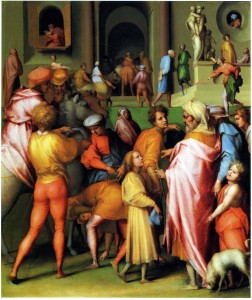 Pontormo, Joseph Sold to Potiphar |
In 1523–1524 Rosso seems for the first time to have found some value in the spatial and formal anomalies of Pontormo’s art. These anomalies in Rosso’s Moses and Rebecca and Eliezer make, however, no psychological effect upon the content of the narrative of these pictures. In this respect Rosso’s art does not correspond to Pontormo’s, the subjective character of which all but subsumes its illustrative aspects. The force of Pontormo’s Victory and Baptism, that has the passionate thrust of Leonardo’s Battle of Anghiari and the plastic mobility of Michelangelo’s Battle of Cascina cartoon, had no use for Rosso at this time. Nor of interest to him were the intrinsic values of the human body and its movement as he had seen them in Michelangelo’s cartoon. True, the Battle cartoon seems also to have prompted Rosso’s imagination in the invention of his Moses and his Rebecca and Eliezer, but not in such a way as to gather from it its remarkable anatomical knowledge. Still, Rosso did share with Pontormo at this time a new recollection of this cartoon that both had studied as young men.
A relationship of artistic intentions between Pontormo’s composition of around 1522 and Rosso’s Moses has already been pointed out by Cox-Rearick,55 although not to suggest any pervasive similarity of forms between the two. In fact, the Pontormesque characteristics of the figures in Rosso’s altarpieces of 1521 are not found in the Moses and the Rebecca and Eliezer. Nor are the figures Michelangelesque in the sense of any extensive physical similarity with the nudes of the Battle of Cascina or even with his teste divine drawings, although Rosso’s paintings do contain several fanciful female heads. Instead there is a schematic definition and arrangement of forms that reminds one again of Bandinelli’s art, as mentioned by Kusenberg.56 Baccio’s Massacre of the Innocents, engraved by Marco Dente around 1520–1521, and already mentioned in relation of Rosso’s Marriage of the Virgin, is closer in style to Rosso’s two pictures of 1523–1524 than any other work he might have known. Here there are, as in Rosso’s paintings, a variety of very active and muscular nudes whose anatomy is so accentuated as to appear to be on exhibit itself rather than in the service of some larger narrative, emotional, and aesthetic intentions. In Bandinelli’s scene, the women are richly dressed and wear elaborate headdresses, as do Rosso’s. Furthermore, the piling-up of the figures at the right in Bandinelli’s composition is remarkably like the arrangement of the figures in the Moses killing the Egyptian and defending the Daughters of Jethro. It is possible that the suggestions of Roman origins that have been recognized in Rosso’s painting may instead have their sources in Bandinelli’s Massacre in spite of the fact that, for all of its references to antique sculpture, it is not Roman in those details of costume that so enriched, according to Vasari, Perino’s Martyrdom cartoon. The details of Bandinelli’s scene are much related to the art of Leonardo, Michelangelo, and Sarto. Bandinelli’s Massacre is also quite without that Raphaelesque reciprocity of plastic forms moving in space that characterizes Perino’s composition and Raphael’s own Massacre of the Innocents engraved by Marcantonio [Fig.Marcantonio, Raphael]. The juxtaposed and planar arrangement of the larger forms in Bandinelli’s Massacre suggests a predominantly Florentine source in Michelangelo’s Battle of Cascina, while the smaller relationships suggest Leonardo’s art. Because of the relationship of Rosso’s pictures to Bandinelli’s, Michelanglo’s, and Leonardo’s work, its indigenously Florentine character is all the more apparent, especially at a time when Rosso had not yet been to Rome, and in 1522 and 1523, Bandinelli and Michelangelo were again living in Florence.
Like Michelangelo’s Battle of Cascina and Raphael’s Massacre of the Innocents, Bandinelli’s composition gives the impression of being a special demonstration of the artist’s talents and abilities. But unlike those demonstrations by Michelangelo and Raphael, Bandinelli’s is literally staged, his performing figures spread out around the edge of a large Renaissance courtyard described with quattrocento precision. It is not so much that we are seeing Bandinelli’s interpretation of the Massacre of the Innocents as we are seeing, whatever the subject may have been, a performance of Bandinelli’s art. The distinction here between what is Bandinelli’s achievement and what is Michelangelo’s and Raphael’s is not one necessarily intended by Bandinelli to separate his art from theirs as it is one that reveals Bandinelli’s dependency on and competition with their artistic achievements. The issue with Bandinelli seems very much to be the presentation of his own “grand” style, even at the expense of narrative clarity. This is also true, even if less so, of Pontormo’s Victory and Baptism where it is also not altogether clear what is represented.
The more schematic, even diagrammatic, character of the style of Rosso’s Moses suggests that, like Bandinelli’s Massacre, it too has as its major intention the display of Rosso’s talents and powers of invention. But this seems even more boldly and obviously the issue of this picture than it is of the composition by Bandinelli, and of those by Perino and Pontormo. Such audacity should not strike us as unusual with Rosso, prepared as we have been by the originality of such works as the altarpieces of 1521. What, nevertheless, remains startling is the degree to which Rosso’s abstraction, so precisely the vehicle of poignant feeling in the pictures at Volterra and for Villamagna, is here, in 1523–1524, the determinant of the complete denial of felt emotion as part of the content of his picture. What instead impresses and gives us an aesthetic jolt is the conceit itself of the Moses picture. Certain aspects of the Pala Dei and the Sposalizio indicate, in retrospect, such an artistic possibility earlier in his own works, and Rosso himself could have gathered from other works of art available to him in Florence similar suggestions that have been mentioned. Yet none of these works allow for the step that Rosso actually took into the kind of artistic invention presented by his Moses. Perhaps no other suggestions were needed to prompt that creative leap that was taken in 1523–1524. Still, one other project might have been important to Rosso in this instance: Pontormo’s frescoed lunette at Poggio a Caiano (Fig.Pontormo,Lunette) and the early inventions for it.
Cox-Rearick has pointed out how the first compositional drawing for this lunette (Fig.Pontormo,Florence,454F), extending conceptions that Pontormo had seen on the Sistine Ceiling, became “a conceit in which powerless giants pretend to a functional role”.57 This phrase might just as well characterize Rosso’s Moses Killing the Egyptian and defending the Daughters of Jethro. It is precisely the invention of Pontormo’s design that attracts our attention, that huge rootless limb totally encircling an oculus and those large and pliant figures seated on two ledges within a totally enclosing wall and holding onto a few scarcely leafy branches. The design does not seem to be related to a narrative and the figures are therefore not necessarily functional in respect to one. The manner in which they appear to function is as attendants to that huge branch, the Medici Broncone. Thus the composition may be seen emblematically and with the value equal to the force of Pontormo’s bold artistic conceit. Working from this symbolic conception Pontormo would seem eventually to have infused into it the components of a story, the story, according to Vasari, of Vertumnus and Pomona.58 As these components were infused into and did not displace the original conceit of this project, the fresco as executed still exhibits an emblematic character that, because of its now narrative suggestions, approaches even more the possibilities of the meaning of Rosso’s Moses. It is true that Pontormo’s figures are more realistic than Rosso’s but the placement of the former on two shallow ledges closed off on both sides and situated high up on the wall of the salone at Poggio a Caiano gives these figures a very precarious existence. The subtle attenuation of plausibility of this scene, enhanced by Pontormo’s inclination to emphasize the shapes and silhouettes of his figures rather than their volume and mass, suggests a fine balance of distinct quantities of actuality and abstraction that Rosso, moving from a similar position held in 1521, would, in 1523–1524, tip in the direction of abstraction. The move in this direction was the significant step that dislodged the making of representational art from the values of verisimilitude that had been, since the time of Donatello and Masaccio, one of the basic elements of Florentine art.
Unfortunately, we do not know why these pictures were painted for Giovanni Bandini and Giovanni Cavalcanti. The reasons would seem to have been personal and special as the subjects of the pictures are so unusual. Furthermore, the similarity of the subjects suggests that, while there may not have been any direct connection between Bandini and Cavalcanti, certain circumstances in their lives must have been similar at the time these pictures were painted. Both subjects refer to eventual marriages, of Moses to Jethro’s daughter, Zipporah, who would seem to be the young surprised woman at the right in the Uffizi picture, and of Rebecca to Isaac, Eliezer’s master, in the panel in Pisa. The exposed breast of Zipporah and the placement of Moses’ genitals in the very center of the painting in the Uffizi certainly give strong sexual references. In the variant copy of the Rebecca and Eliezer painting one woman, at the right, holds her covered breast. Although none of the men’s genitals is visible in the version in Pisa, the matching Uffizi drawing of the whole composition attributed to Salviati (Fig.P.15 Copy,Florence,14610F) shows them of the man leading a camel at the left and of the supine figure at the lower right. Their deletion and concealment in the panel painting in Pisa—the hiding of the sleeping nude’s genitals by the strongly lit knee of the man holding the dog and the total elimination of the left arm and hand of the man at the left, probably originally conceived with his left hand holding his genitals as in the drawing in Vienna (Fig.P.15 Copy, Vienna)—seem to indicate a censorship later than the time of the making of the original lost Rebecca and Eliezer that was of no concern of Rosso. Remembering that Rosso’s almost contemporary Sposalizio has also its sexual elements, in the youthful beauty of St. Joseph and St. Vincent Ferrer’s gesture seen in relation to Joseph’s groin, there is reason to believe that the Moses and the Rebecca and Eliezer should be seen as having similar intentions also related to marriage. One might even suppose that the heraldic-like abstraction of these privately commissioned pictures is what makes possible the degrees of sexuality that Rosso depicts. By abandoning verisimilitude and the depiction of deeply felt emotions, Rosso was able to explore, and without sentimentality, the sexual nature of his subjects. The duality of subject and content of Rosso’s pictures recalls that of Pontormo’s fresco at Poggio a Caiano but with the function of representation and symbolization reversed. Where Pontormo’s poignantly felt representation masks its symbolic meaning, Rosso’s stylistic abstraction transforms the narrative substance of his pictures into the appearance of an emblematic image. In doing this Rosso’s art indicated, as Bandinelli’s, Pontormo’s, and Perino’s did not quite, the possibility of an autonomy of artistic behavior from visual and emotional investigation that would later be an aspect of the formulas of some mid-century Central Italian painting.59
No other works by Rosso are as removed from actual appearance as are his Moses killing the Egyptian and defending the Daughters of Jethro and the Rebecca and Eliezer. Yet very possibly these two pictures allowed more than any others he had painted up to this time for the character of much of his later art. That is, they allowed for the extent of its invention and, one might also say, for the limitation of the emotional expression of a certain portion of it. On this latter issue it might be more just to say that their style allowed, subsequently, for the restriction of the emotional expression of some of his art and hence for the opportunity of his powers of invention to serve other than the needs of deeply felt emotion.
What then were these other needs? After the fundamental publications of Kurt Kusenberg and Paolo Barocchi, the extensive and intensive research of John Shearman, Arnold Hauser, Sydney Freedberg, Marie-Geneviève de la Costa, Paul Barolsky, Eric Darragon, Vivien Gaston, David Franklin, Elisabetta Marchatti Letta, Alberto Mugnaini, Cinzia Sicca, Dalia Haitvosky, Mariagiulia Burresi, Antonio Caleca, Edward J. Olszewski, and, most comprehensively, Caroline Elam, have allowed for a recreation of the ideas and circumstances of this keenly interesting and moving moment in Florence when Rosso did these two paintings. While the evidence is fragmentary there is a sufficiently large and varied amount of it that can be related to suggest a plausible history of these two paintings. It is a history, I believe, that can, reflectively, be related to Rosso’s Virtù Vanquishing Fortune and to his St. John the Baptist in the Wilderness that are considered above in what could be taken as a preface to some of what is conjectured here. Vasari, already in 1550, reported that the pictures were painted for two Florentines, the Moses for the wildly temperamental, murderous, and sexually enthusiastic Giovanni Bandini, the Rebecca and Eliezer for the Florentine businessman who was also resident in London, Giovanni Cavalcanti. According to Vasari, the first was sent to France, the second to England. Cavalcanti appeared in London already in 1513 and at the English court in 1522 active in the business, cultural, and political affairs of Henry VIII, Leo X, and the Florentine members of the papal curia. Through him the original Rebecca and Eliezer would have been sent to England, but when precisely is not known. He would seem to have commissioned the painting from Rosso in Florence and then returned to England, but he was back in Florence in 1527 at the time of the Medici expulsion. The existence of the Pisa copy would indicate that while waiting to be shipped to England the lost original was more visible than the Moses. Bandini kept his quadro d’ignudi in the camera terrena of his home in Florence, as mentioned in a letter from Bandini to Filippo Strozzi on 2 March 1529. Here Bandini reports that the Giovanni Battista della Palla, the art dealer and major supplier of art to the king of France, asked him for the picture. “I immediately gave orders that it be consigned to him free of charge.” Della Palla had the “quadro di Giovanni Bandini” shipped to Marseilles very soon thereafter. There is no evidence that either picture was ever publically exhibited in the short while each remained in Florence before being shipped off to England and to France.
The Moses measures 160 by 117 centimeters, the Rebecca and Eliezer 165 by 117, not large as grand Florentine pictures can be, such as Rosso’s recent altarpieces of 1522 (253 by 210) and 1523 (325 by 250). Nor as small at Rosso’s recent portraits, The Young Man with a Letter measuring 85.5 by 66.5, and the portrait in Washington, 88.7 by 67.9. It is known that Battista della Palla, as a supplier of art to patrons outside Italy and aware of the dangers of long distant shipment of works of art, preferred paintings done on canvas. Panel pictures even of the modest size of Rosso’s Moses would be heavy to handle and difficult to pack for travel, not to mention the rough trip over land and the loading and the unloading of them when sent even part of the way by ship. The original Moses is on canvas and the lost original of the picture for Cavalcanti was most likely on the same support. It is thus most probable that the two pictures by Rosso were commissioned for export, directly by Cavalcanti to England, and from Bandini through della Pala for the other painting to France. Cavalcanti may have been successful in selling his picture in England. Della Palla, who would have been the dealer who handled the sale of Bandini’s quadro d’ignudi for a fee, first got the painting early in 1529 to ship to Marseilles. From a memorandum to Filippo Strozzi likely written after the end of October 1529, Bandini reports that forty crates of works of art reached Marseilles that he heard had been “ill received and ill looked after.” In November 1530, under new Medici rule, della Palla, who has had a part in the plot of 1522, was arrested and imprisoned in the Fortress of Pisa, where he was found dead in 1532. There is no evidence that Rosso’s Moses, intended for Francis I, ever reached the king. Its purchase was likely prohibited by the king’s need for money to liberate his hostage sons negotiated by the Treaty of Combrai between the French king and the emperor signed on 5 August 1529. The history of Rosso’s Moses may not be unlike that of Michelangelo’s Leda that got to France but then was handed around for the profit of whomever could get the most for it, and eventually lost, but not before Rosso could make his copy of it (see D.74). The Moses resurfaced in the Uffizi inventory of 14 March 1587 (modern style 1588).
The major controversy surrounding the Moses and the Rebecca and Eliezer has been the intent of the subjects of the pictures in relation to Bandini and Giovanni Cavalcanti. There is no evidence that the subjects were related to specific marriages. Nor, in any case, does the subject of marriage occupy, by implication, more than a small area of the paintings. Each scene centers on a well where, in the Moses, shepherds have come to water their flocks, and, in the Rebecca andEliezer, cameleers have come to water their herds and to rest. But the Moses displays across most of its surface a battle of nudes with Moses defending the daughters of Jethro and killing the Egyptian. In 1529 Bandini, who had the painting in his house, called it a quadro d’ignudi without any mention of Moses; in 1550 Vasari named it un quadro di alcuni ignudi bellissimi before referring to its subject, una storia di Mosè… Intended for Francis I, who preferred contemporary Florentine works over any other, Rosso’s fight of nude men would have brought Michelangelo’s art to mind, perhaps even the Battle of Cascina, with Moses, an exemplum virtutis, in relation to Fortune, and as defender of virtue and justice (Mugnaini), in which the king of France might recognize himself. The frightened young shepherdess’s bare breast, shoulder and arm, and the bunch of drapery at her pudendum would bring to mind her fecundity as the eventual wife of Moses, but the naked beauty of Zipporah’s would also delight Francis I who we know prided himself as a connoisseur of female beauty. The centralized genitals of Moses would have flattered the king in reference to his own virility.
As it is likely that Rosso chose the subject of his picture for the French king, its various aspects might further indicate the effort to get Francis I to support again the Republican cause in Florence that he had earlier promised at the time of the Orti Oricellari conspirarcy. The audacity of Rosso’s composition strengthens its reference to the virtues, even the virtù, of the king, as does also the combined fury and control of its execution. Compared to the facture of the altarpieces done on wood of 1522 and 1523 the Moses on its canvas support seems to have been painted quickly, not only to get it done in short time but to show the bravura of Rosso’s talent. But getting it done quickly could have had its point if the painter had already in his mind to leave for Rome.
The painting for Cavalcanti may well not have had behind its conception quiet the fullness of intent as the work for the French king. It can be seen as another painting like the Moses that Cavalcanti wanted to send to the English king but did not want a copy of the work meant for the Francis I. Rosso found as an equivalent subject in another Old Testament event involving the selection of a bride at a well and a group of nude men who come to water their camels. From the copy in Pisa the lost original seems to have been less daring and less interesting than the Moses, an evaluation that Elizabeth Grath also recognized as reported by Caroline Elam. But Cavalcanti would have made sure that the painting for the English king was as prestigious a work as the one for Francis I. The removal of the genitals in the Pisan picture, that takes with it the full left arm and hand of the standing cameleer at the left, could have been due to Cavalcanti’s idea of Henry’s taste in pictures and in sexual exhibition. This suggests that Cavalcanti, the Florentine businessman, would have seen the Moses before he commissioned the Rebecca and Eliezer and in an early state of the latter requested the deletion of its overt sexual details. Alternatively these deletions may be only an aspect of the copy that would account for the awkward removal of that left arm and hand and no replacements for them by Rosso.
The making of these two painting for export may indicate that after the completion of the Sposalizio Rosso has no other Florentine commissions waiting to be fulfilled. It is very possible that the idea of making the Moses for sale to the French king was Rosso’s idea in the first place, from which the Rebecca and Eliezer followed quite by chance. Highly ambitious, but with professional disappointments in Florence and now with only these quick jobs for export of a kind he was never to do again, in order to earn whatever was possible to carry him over until something better came along. When other commissions did not appear he set off for Rome where, as mentioned by Vasari, he was greatly anticipated, essendosi veduti alcuni disegni fatti per lui, i quali erano tenuti maravigliosi, atteso che il Rosso divinissimamente e con grand pulitezza disegnava.60
* * *
Rosso was born in the parish of San Michele Visdomini and in 1517 was living in the parish of San Marco. In October 1522 he rented a house in the “Via Nuova dal Canto a Montelore” in the parish of S. Pier Maggiore in which he already resided elsewhere (DOC.7b). Just before he left Florence, he lived, according to Vasari, with his assistant Batistino, “il quale era di bellissimo aspetto” and a pet monkey (bertuccione) in a house in Borgo de’ Tintori, the windows of which over looked the gardens of the friars of Santa Croce. Vasari tells the story of how Batistino trained the monkey to steal grapes from these gardens. When the monk who tended them tried to beat the monkey off, it tore at the pergola that supported the vines and destroyed it. After the monk registered a complaint, Rosso was summoned to appear before the Office of the Eight, which condemned the monkey to wear a weight fastened to its body so that it could not get out and into the gardens. But the monkey learned to carry the weight, and one day while the cleric was away, brought it down to where the monk lived and with it broke all the roof tiles over his room. Three days later, during a heavy rainstorm, the cries of the drenched monk were heard.61
* * *
Late in 1523 or early in 1524 Rosso, with his assistant Batistino and ape, departed from Florence and traveled to Rome, via Arezzo according to Vasari.62 The “schizzetto tutto d’ignudi molto bello” that he did in Arezzo for Giovanni Antonio Lappoli’s Visitation in the Badia di Ss. Flora a Lucilla is lost (L.17) but the altarpiece, missing the lunette that was above it showing God-the-Father with angels, still exists to give some idea of Rosso’s conception.
Although we must read it through the drapery and the heads—or at least some of them—invented by Lappoli and although we must attempt to appreciate it in spite of Lappoli’s execution, Rosso’s conception appears to be closely related to that of his Sposalizio of 1523. Like that altarpiece, Lappoli’s Visitation has aspects both of a narrative scene and of a sacra conversazione with Mary Magdalen and King David with a harp on the ground before him in the foreground, the king holding a book inscribed with passages from Psalm 84:14 and Psalm 131:17 (n.5, L.17). The figures are arranged more or less symmetrically on a flight of stairs and there is a suggestion in Lappoli’s picture that the lighting from the right and the dark background are also related to the illumination and shadow in Rosso’s Marriage of the Virgin. The abstraction of the Moses was probably not an aspect of Rosso’s lost drawing for Lappoli’s public altarpiece, for it is most likely that the manner of those two earlier paintings was a mode that Rosso would not have found applicable here. The style of the pictures of 1523–1524 and that of the Sposalizio served different intentions. The similarity, in so far as one can see it, between the Visitation and the slightly earlier Sposalizio, even though in the later picture Rosso seems to have simplified—for Lappoli?—the composition of the other, coming after the Moses and the Rebecca and Eliezer, suggests at least the possibility of concurrency of styles in Rosso’s career. In Rome this would become a serious issue of some importance to Rosso’s art and to the nature of his artistic ambitions.63
3 See Wittkower, 1937–1938, 313–321; and Kiefer, F., “The Conflation of Fortuna and Occasio in Renaissance Thought and Iconography,” Journal of Medieval and Renaissance Studies, IX, 1, 1979, 1–27. The subject is extensively considered in Mario Santoro, Fortuna, ragione e prudenza nella civiltà letteraria del Cinquecento, Naples, 1967. See also Panofsky, Erwin, “Good Government’ or Fortune? The Iconography of a Newly-discovered Composition by Rubens,” GdBA, 6th series, LXVIII, 1966, 305–326.
4 On Fortune as discussed by Machiavelli, see B. T. Wilkins, “Machiavelli on History and Fortune,” Bucknell Review, VIII, 1959, 225–245; Felix Gilbert, Machiavelli and Guicciardini, Politics and History in Sixteenth-Century Florence, Princeton, 1965, 193–197, 288–293, 251–253; Hanna Fenichel Pitkin, Fortune is a Woman, Berkeley, Los Angeles, London, 1984, 138–169; and Martines, Lauro, “Political Thinking: Man Against Unreason,” Power and Imagination. City-States in Renaissance Italy, New York, 1979, 310–317.
5 See Carroll, 1961, 449, n. 6, with the incorrect statement that Martianus Capella wrote that Fortune’s bosom was thought also the source of her ill-will. For the passage by Martianus Capella, see Patch, 1922, 164–165, and n. 16. See also The Marriage of Philology and Mercury, translated by W.H. Stahl, R. Johnson, and E.L. Burge, in Martianus Capella and the Seven Liberal Arts, II, New York, 1977, 30, and Martianus Capella, ed. by Adolf Dick, Leipzig, 1925, 37. For the passage by Cicero, see his De Divinatione, trans. by W. A. Falconer, London, Loeb ed., 1923, 466–467. Martianus Capella stated that Fortune distributed her favors from her ample bosom but dealt misfortune with beatings and the like. At Praeneste, Fortune, shown nursing Jupiter and Juno, was a benevolent goddess worshipped by mothers, on which, see Hild, in Daremberg and Saglio, 1899, II, 2, 1270, and 1275 where a Fortuna is mentioned but with flaccid pendulous breasts, not the kind of Fortune of interest in the Renaissance.
Mundy, 1985, 79–84, chose not to see the object held by Virtù as a breast, but rather as a scalp or hank of hair. Reading my too convenient translation of Virtù as Virtue, he thought the one lady’s “behaviour decidedly not virtuous.” But virtù at the time Rosso’s drawing was made, and as frequently used by Machiavelli, also has an active and virile meaning, even as the noun is feminine and must be visually personified as a woman: “to possess virtù was a character trait distinguishing the energetic, even reckless (but not feckless) man from his conventionally virtuous counterpart, rendering him less vulnerable to the quirks of Fortuna” (J.R. Hale, in A Concise Encyclopaedia of the Italian Renaissance, ed. by J.R. Hale, New York and London, 1981, 338; see also Jerrold E. Seigel, “Virtù in and Since the Renaissance,” Dictionary of the History of Ideas, ed. Philip P. Wiener, New York, IV, 1973, 476–486). Mundy also thought that the drawing shows Opportunity (Occasio) grabbing Fortune by the forelock which she cuts off citing Vasari in the “Life” of Taddeo Zuccaro and in the “Life” of Salviati as proof of such a subject (Vasari-Milanesi, VII, 23, 81). Unfortunately Vasari was wrong in naming Fortune and Occasio as adversaries (see Kiefer in n. 3). Taddeo’s image of Prudence seizing Fortune by the forelock of Occasio was the favorite impresa of Pope Julius III, as shown in Alessandro Nova, The Artistic Patronage of Pope Julius III, New York and London, 1988, 29–30, 50, n. 61, 159, 163, 190, n. 72, and 192–193, n. 82, Figs. 11, 12, 29, 54, 73, and 77, including a variation of the impresa showing Virtù subduing Fortune. Salviati’s fresco in the Palazzo Vecchio (Dumont, 1973, Pl. XLIII, Fig. 92, at upper right) also shows Prudence, with a mask on the back of her head and a snake at her waist, pulling the forelock of Fortune. In Rosso’s drawing Virtù in the background is clearly doing two different things with her two hands: her right pulling Fortune’s head back by its forelock, the left pulling something up from Fortune’s chest. It may be uncomfortable to conclude that a breast is being ripped from the figure, but this is what is happening (note the nipple of the breast in the foreground and again, marked by a dot, in the background).
Cox-Rearick (1964, I, 168, no. 107, II, Fig. 107, and 1984, 144, Pl. 119) identified a drawing by Pontormo as representing Fortune (Fig.Pontormo,Fortune), suggesting a connection with Pontormo’s activity at the Medici Villa at Poggio a Caiano in 1520–1521. While this drawing bears no relation to Rosso’s either stylistically or interpretatively, it is interesting that the theme may have occupied Pontormo so shortly before it did Rosso.
6 See Pope-Hennessy, John, Cellini, New York, 1985, Pls. 46, 47, 48, with captions stating that lost original medal was made on Cellini’s first visit to France in 1537, and modified in the surviving medal, the best version of which, in silver, is in the Bargello in Florence. Pope-Hennessy gave the reverse the title: The King Triumphant over Fortune, but the figure on the horse seems to have a small right breast and flying hair and is probably the personification of Virtù.
8 Martianus Capella and the Seven Liberal Arts, II, The Marriage of Philology and Mercury, New York, 1977, 30.
10 Vasari-Milanesi, 1906, V, 166. See below on the incorrect Latin of Rosso’s signature in the book held by St. Apollonia in the Marriage of the Virgin of 1523 (Fig.P.13g).
11 So far as I know Fortune’s breasts are not discussed in Renaissance texts. She was frequently depicted nude but not with any particular emphasis on her breasts. However, in the middle of the sixteenth century Vasari might have meant them as especially significant, as his representations of Fortune show her draped but with her ample breasts exposed (see Wittkower, 1937–1938, 320, Pl. 53b, and Chastel, 1983, 235–236, Fig. 114).
12 On compositions by Mantegna and Leonbruno that show Fortune and are relatable to the circumstances of their own lives, see Jacobson, 1982, 626–627, Figs. 4–6.
13 St. John the Baptist in the Desert, Corsham Court, Collection of Lord Methuen no. 82, 43 x 33 cm., Freedberg, 1963, I, Fig. 80, II, 78–79, no. 38, as c. 1517–1518. Shearman, 1965, I, Pl. 132a, II, 262, Cat. no. 72, as c. 1523–1525.
16 Patch, 1922, 200–202; The Inferno of Dante, translated by Robert Pinsky, bilingual edition, New York, 1994, 56–57.
18 See Musacchio, Jacqueline Marie, Art, Marriage and Family in the Florentine Renaissance Palace, New Haven and London, 2008, Chapter 4, “The Madonna, Saints and Heroes for the Home,” 190–243.
19 On this conspiracy, see Spini, Giorgio, Tra rinscimento e riforma: Antonio Bracioli, Florence, La Nuova Italia, 1940, 13–41; Osmond, Patricia J., “The Conspiracy of 1522 against Cardinal Giulio de’Medici: Machiavelli and ‘gli esempli delli antique’,” in Clement, 2005, Chapter 5, 55–72; and Najemy, John M., A History of Florence 1200–1575, Blackwell, Malden, MA, Oxford, Carlton, 2006, 440–441.
21 Shearman, 1965, I, 163 n., also noted that Rosso recalled this altarpiece in the 1520s. Franklin, 1994, 87–88, thought that my suggestion that Rosso’s intended to depict the vision of St. Bernard should be treated with caution. Caution may especially be indicated by the detailed illustration of this vision in the fifteenth-century stained glass window above Rosso’s altarpiece in this chapel. Visually, however, the saint’s posture and gesture, the emphasis of the Saint’s placement in the scene, the brilliant light upon his habit, and his upward glance toward the Virgin bring to mind that vision however cautious the viewer maybe in preventing this from happening.
24 There may be some resemblance here to the profile of the supposed figure of St. Catherine of Alexandria beneath the surface of the Portrait of a Young Man in Washington (Fig.P.8e) and which may have belonged to the altarpiece of which the Angel Playing a Lute is a fragment (on which see P.4).
25 On images of the Child with an erect penis, see Steinberg, 1983,78–82, and Figs. 82–87, but also Walker Bynum, 1986.
27 Vasari-Milanesi, 1906, V, 158–159; translation, De Vere, V, 191–192.
28 See A. Stix and L. Fröhlich-Bum, Beschreibender Katalog der Handzeichnungen in der graphischen Sammlung Albertina, III, Die Zeichnungen der Toskanischen, Umbrischen and Romischen Schulen, Vienna, 1932, 22, no. 153 and ill.
30 See Gertrude Schiller, Ikonographie der christlichen Kunst, Cassel, IV, 2, 76–80; and Franklin, 1992, 186–187. Vasari referred to the painting as a “sponsalizio.”
32 See Freedberg, 1961, I, 433, II, Fig. 535, who pointed out “its singular iconographic form, combining narrative and altarpiece.” See also Franklin, 1992, 186, 189–190, on altarpieces with narrative scenes and added saints.
35 As reported in Mrs. Arthur Bell, Lives and Legends of the Evangelists, Apostles, and Other Early Saints, London, 1901, 258.
36 I wish to thank Professor Dario Cori for his reading of this inscription. The mitre worn by the priest in Francesco Zaganelli’s (d. 1531) Sposalizio at Capodimonte, Naples (no. 82) has a Hebrew inscription, and one of the four letters appears on the mitre of the priest in the fragment of Palma Vecchio’s Marriage of the Virgin of 1520–1521, formerly in the Giovanelli Collection (see Philip Rylands, “Palma Vecchio’s ‘Assumption of the Virgin'”, BM, CXIX, 1977, 244, Fig. 26, and 245).
37 The placement of the ring on the Virgin’s finger signifies her betrothal to Joseph and is a common feature of pictures that are thus somewhat incorrectly called the Marriage of the Virgin. Marilyn Aronberg Lavin reminded me that the ring is a relic in San Lorenzo, the cathedral of Perugia. I have not found that this might bear upon the conception of Rosso’s altarpiece in San Lorenzo in Florence.
38 A young, but bearded and modestly dressed Joseph appears in Zaganelli’s Sposalizio, and in Palma’s (see n.35); he is young, unbearded, simply dressed, and demure in Lorenzo Costa’s Marriage of the Virgin of 1505 in the Pinacoteca Nazionale, Bologna (see Ranieri Varese, Lorenzo Costa, Milan, 1967, 65, no.18, and Pl. 47), and young and unbearded in Trometta’s drawing in the British Museum (“Drawings by Niccolò Martinelli, Il Trometta”, Master Drawings, I, 4, 1963, 15, no. 16 and Pl.6). See also Smith, 1976, 29, n.7. But none of these figures of St. Joseph has the handsomeness and splendid costume of Rosso’s saint. Rosso’s painting and its youthful Joseph were, however, influential on the conception of Poppi’s Sposalizio of 1579 in S. Niccolò Oltrarno in Florence (Fig.Poppi,Sposalizio); see Elam, 1982, 722, Figs. 83–84, 723, and Giovanetti, 1995, 45, 93–94, no. 31, 151, Fig.45). In Northern Europe Goswyn van der Weyden’s Betrothal of the Virgin (Max J. Friedlander, Early Netherlandish Painting, Leyden, XI, 1974, 22, and Pls. 26–27) shows Joseph young and bearded though not especially handsome.
39 As mentioned by Meyer Schapiro, ” ‘Muscipula Diaboli’, The Symbolism of the Mérode Altarpiece”, AB, XXVII, 1945, 185 and n. 25. In the fourteenth-century Franciscan Meditations on the Life of Christ (Ragusa and Green, 1961, 26–27) it is explained that one reason that God wanted Mary to have a husband was “that the appearance of the Son of God might remain concealed from the demon.” On the deception-of-Satan theory, see Ruth Mellinkoff, The Devil at Isenheim: Reflections on Popular Belief in Grünewald’s Altarpiece, Berkeley and Los Angeles, 1988, 28–31, and the review of this book by Christian Heck, AB, LXXIII, 1991, 690. Franklin, 1992, 188–189, thought that the decision to make Joseph as young as he appears in the San Lorenzo altarpiece was Rosso’s, stating that “There was a major increase in the literature devoted to Joseph in this period, especially from the Dominicans, but none of it advocated a young Joseph.” This might support the possibility that Rosso learned of a young Joseph from elsewhere even as his remarkable beauty is the artist’s own description of his youthfulness.
40 On the sacrament of marriage, see Cynthia Hahn, “‘Joseph will Perfect, Mary Enlighten and Jesus save Thee’: The Holy Family as Marriage Model in the Mérode Triptych,” AB, LXVIII, 1986, 61–65 (“Marriage in the Mérode Triptych”).
41 See G. Kaftal, Saints in Italian Art: Iconography of the Saints in Tuscan Painting, Florence, 1952, cols. 1021–1025, and n.1, Fig. 1145. Sinding-Larsen, 1974, 117 and n.8, pointed out two later paintings of St. Vincent Ferrer preaching on judgment, an altarpiece by Jacopo del Meglio in S. Maria Novella in Florence, and an anonymous late sixteenth- or early seventeenth-century painting in S. Maria sopra Minerva in Rome. See also Franklin, 1992, 190, and Pl.36b (attributed to Botticini), and 190, n. 60 (referring to a picture attributed to Domenico Ghirlandaio illustrated in Von Holst, 1974, Pl. 131).
42 The gesture is one of doctrinal significance but does not seem to be pointing out a specific detail, such as the ring.
43 Franklin, 1992, 188, noted the “crepuscular atmosphere” of Rosso’s picture as related to its placement in the Ginori chapel.
44 Vasari-Milanesi, 1910, V, 159; translation, De Vere, V, 192.
45 See Bernice Davidson, “Early Drawings by Perino del Vaga”, Part 2, Master Drawings, I, 4, 1963, 19–20, and Pl. 16. Davidson said that Perino arrived in Florence probably early in 1522. See also her “Perino del Vaga e La Sua Cerchia”, Master Drawings, VII, 4, 1969, 404, and Pl. 16, where she gave the date 1522–1523 for Perino’s Martydom composition; Shearman, 1965, I, 98–99, with the date 1523; and Parma Armani, 1986, 54–53, with Fig., 320, no. C II, as 1522–1523. See also Shearman, 1967, 65, and Franklin, 1988, 320, with the suggestion of the influence of Perino’s Martyrdom on Rosso.
46 Vasari, in his “Life” of Michelangelo (Vasari-Milanesi, 1906, VII, 273), said that Michelangelo “Amò gli artefici suoi, praticò con essi; come con Jacopo Sansovino, il Rosso, il Puntormo, Daniello da Volterra, a Giorgio Vasari aretino,…” Naming only five artists would seem to give some importance to their relation to Michelangelo. Though these artists would have known Michelangelo at different times, Rosso could have known him personally only in Florence before 1524. Michelangelo was in Florence from 1516 and while there is no evidence that Rosso knew him this early, it is plausible to say that they were acquainted soon thereafter this date.
47 On the these divine drawings by Michelangelo made for Gherardo Perini, probably in 1522, see Vasari in Vasari-Milanesi, VII, 276–277; Ludwig Goldscheider, Michelangelo Drawings, London, 1966, 42–43, nos. 51–52, and Pls. 51–52; and Hirst, 1988, 107–109, who commented that Rosso seems to have had access to Michelangelo’s drawings.
48 See the two drawings in the Louvre discussed by Paul Joannides (1972, 541–551, Figs. 48–49), and Kathleen Weil-Garris Posner (“Comments on the Medici Chapel and Pontormo’s Lunette at Poggio a Caiano”, BM, CXV, 641–649, Figs. 12–13). Both designs are datable between late 1520 and early 1521.
52 Vasari-Milanesi, 1910, V, 159–160; translation, De Vere, V, 192.
58 Vasari-Milanesi, 1906, VI, 265. On the iconography of Pontormo’s fresco, see Matthias Winner, “Pontormo’s Fresko in Poggio a Caiano”, Zeitschrift für Kunstgeschichte, XXXV, 3, 1972, 153–197, and Julian Klieman, “Vertumnus and Pomona, Zum Programm von Pontormos Fresko in Poggio a Caiano”, Mitteilungen des Kunsthistorischen Institutes in Florenz, XVI, 3, 1972, 293–328. Frederick A. Cooper (“Jacopo Pontormo and Influences from the Renaissance Theater”, AB, LV, 3, 1973, 380–392) denied, wrongly I believe, the identification of the fresco with the story of Vertumnus and Pomona, but he presented interesting information for the interpretation of this painting.
59 Smith, 1977, related the Moses to the writings of Philo Judaeus, the Jewish theologian and philosopher, and his Life of Moses, and hence thought the scene as “an example of Moses’ sense of justice and readiness to come to the aid of the weak,” and with “civic or political meaning, intending to present Moses as an exemplum virtutis.” This is possible. But Smith also pointed out the special attention given to one of the daughters, whom he identified also as Zipporah, in a pose similar to that of the Virgin in the Annunciation. It is interesting that Philo Judaeus, in his On the Change of Names, and regarding the story that Rosso depicted, makes a sexual reference: “The [seven] daughters stand as a symbol of the seven faculties of the unreasoning element, namely reproductive power, speech and the fives senses.” Furthermore, elsewhere Philo Judaeus gives the meaning of Zipporah’s name as “bird” and says that she is Virtue, whom Moses took as his wife, and that as a Virtue she became impregnated, miraculously, by God Himself.
Gaston, 1988, related the Moses to Savonarola’s “politicized vision of Moses” which “took on a new theoretical strength in the works of Machiavelli” and showed “the continuity of thought which harnessed athletic imagery to moral concepts… the obscure incident at Midian now demonstrating political as well as spiritual strength.” (On this subject, see also Alison Brown, “Savonarola, Machiavelli and Moses: a Changing Model,” in Florence and Italy. Renaissance Studies in Honour of Niccolai Rubinstein, ed. Peter Denley and Caroline Elam, London, 1988, 57–72.) What Gaston was not able to indicate is how the thoughts of Savonarola and Machiavelli would bear upon a picture made for Giovanni Bandini who, as she pointed out, “was an important diplomat and military commander for the Medici.”
Although Smith briefly discussed the Rebecca and Eliezer in relation to the writings of Philo Judaeus and Gaston mentioned the painting in a note, neither took seriously the relationship of the two pictures which I think must be related in their meaning. Smith pointed out that Giovanni Bandini belonged to the Compagnia della Cazzuola in Florence, to which members of the Ginori family also belonged. Gaston also noted (224, n. 22) that Nardi recorded that he met Bandini in 1527 at the villa of Carlo Ginori, who commissioned Rosso’s Marriage of the Virgin.
60 Vasari-Milanesi, 1910, V, 161; translation, De Vere,V,194.
61 Vasari-Milanesi, V, 160–161. Borgo de’ Tintori is now Corso de ‘Tintori which continues as Via Tripoli. Part of the site of the gardens is now occupied by the Biblioteca Nazionale. A view of this site appears in a painting of 1718 in the museum at S. Croce (illustrated in I musei di Santa Croce a di Santo Spirito a Firenze, ed. Luisa Becherucci, Milan, 1983, 13) which shows two houses on the street that also face the gardens of S. Croce. A view of this area also appears in Vasari’s Siege of Florence in the Sala di Clemente VIII in the Palazzo Vecchio (Boase, 1979, 14–15, Fig. 8). George Bull in his version of Vasari’s “Life” of Rosso (Giorgio Vasari, Lives of the Artist, Harmondsworth, 1987, II, 174) translated “bertuccione” as Barbary ape. This kind of rather large tailess ape, wearing a collar and with a leash tied to the ledge of a house, appears in the background of Masolino’s Raising of Tabitha in the Brancacci Chapel. A large ape with a tail and attached by a band around his body and a chain to a cubic weight appears at the lower left of Rosso’s Nymph of Fontainebleau engraved by Milan and Boyvin (Fig.E.103). A similar monkey, with a band around its torso can be found on a ledge of the building at the far right of Rosso’s Unity of the State in the Gallery of Francis I (Fig.P.22,VI Sb) and in the related tapestry INSERT DETAIL HERE. It is very possible that the monkey depicted by Rosso was the kind that he owned. Vasari said he took it to Rome. He may later have taken it to France.
Barolsky, 1978, 141, calling the animal a baboon, as “bertuccione” can be translated, thought Vasari’s story expressed “Rosso’s satirical bent and attitude toward religion.” Barolsky, 1991, 21–22, expressed the opinion that the ape and story were fictitious and served Vasari’s purpose as “an extension of the artist” and “a mockery of the clergy,” and, more deeply, “fortelling the incarceration of Rosso himself” at the time of the Sack of Rome. I doubt that the story has so much importance; its primary effect is to give comic relief to Rosso’s biography. I am also inclined to believe that the story is true. The site of the story is plausible, as well as the reference to the Ufficio degli Otto (probably the Otto di Guardia, the committee for police and criminal matters). I have wondered if the assistant Batistino is the Giovanbatista di Francesco di Jacopo who can be related to the S. Maria Nuova Altarpiece commission (see under P.5, and Franklin, 1987, 656, n. 42, who planned a discussion of this painter and his relationship to Rosso).
62 See Vasari-Milanesi, 1906, VI, 9. Rosso’s departure from Florence could have taken place only after he had finished the Sposalizio, dated 1523, and the Moses and Rebecca and Eliezer paintings which Vasari said were done in Florence after the altarpiece in S. Lorenzo. Clement VII was proclaimed pope on 19 November 1523, but it is not necessary to believe that this Medici appointment was what prompted the artist to rush to Rome. He could have left at that time also because of an outbreak of the plague, which Sarto also fled (see Shearman, 1965, I, 5). It seems unlikely that Rosso was still in Florence, or Arezzo, as late as 18 April 1524, when his name appears as one of the possible appraisers of Guglielmo de Marcillat’s frescoes in the cathedral of Arezzo (DOC. 8) for Rosso was already in Rome on 26 April 1524, when he was commissioned the decoration of the Cesi Chapel in S. Maria della Pace (P.16). Nevertheless, it does seem strange that his name would be mentioned as a possible appraiser if he were known not to be available because he was in Rome; stranger, too, because he stopped in Arezzo on his way to Rome and gave Lappoli a drawing for an altarpiece (see L.17). Hence, it is possible that he was still in Arezzo on 18 April 1524 and left for Rome immediately thereafter. The “loan Baptista fiorentino” who seems to have been active in Naples in the early 1520s (Becherucci, 1949, 56) cannot be identified with Rosso Fiorentino as the group portrait related to this identification had to have been painted in Naples before March 1522 when Rosso was certainly in Florence (see F. Nicolini, L’arte napoletana del Rinascimento e la lettera di Pietro Summonte a Marcantonio Michiel, Naples, 1925, 164, 250–251).
Lamenting Florence’s treatment of its famous men, Anton Francesco Doni in his I Marmi of 1552 (ed. by Ezio Chiòrboli, Bari, 1928, II, 22; and Darragon, 1988, 22, 29, n. 5) commented on Rosso’s departure from Florence by saying: “Il vostro gran Rosso perché no lo aver mantenuto qua?”
63 A drawing of a Meeting at the Golden Gate (Fig. Florence, 6470F) in the Uffizi is inscribed Rosso darezzo and could just possibly reflect a lost drawing by Rosso done in Arezzo at the same time that he designed Lappoli’s Visitation (see under L.17).

